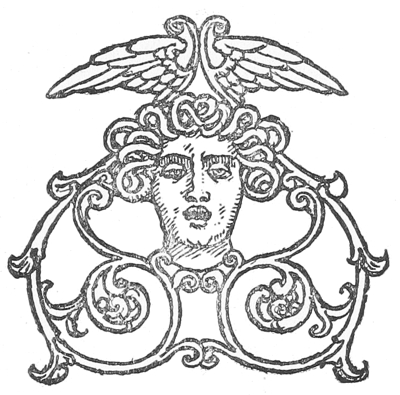


A STUDY · MAX LIEBERMANN

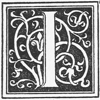
IT may perhaps be interesting to the readers of this book to give a short account of its origin. From the earliest days of my pupilage to art I had been instinctively drawn towards the paintings of Turner, Corot, Constable, Bonington, and Watts, with an intense admiration for their manner in viewing, and methods of recreating, nature upon their canvases; and in later years I had been fascinated by the works of more modern artists, such as La Thangue, George Clausen, Edward Stott, and Robert Meyerheim. In 1891, a student in Paris, I found myself face to face with a beautiful development of landscape painting, which was quite new to me. “Impressionism,” together with its numerous progeny of eccentric offshoots, was at the time causing a great furore in the schools. Curiously enough I had been charged with copying Monet’s style long before I had seen his actual work, so that my conversion into an enthusiastic Impressionist was short, in fact, an instantaneous process.
Since then I have endeavoured, by precept and by example, to preach the doctrine of Impressionism, particularly in England, where it is so little known and appreciated. It has always seemed to me astonishing that an art which has shown such magnificent proofs of virility, which has long been accepted at its true value on the Continent and in America, should be comparatively neglected in my own country. A stimulating propaganda being needed, I invaded for a short time the domain of the writer on art, a sphere of activity for which I feel myself none too well equipped. For years, as a hobby, I had collected all manner of documents bearing upon the subject of Impressionism, and the mass of material which thus accumulated formed the basis for several articles which have appeared under my name in the English magazines. To the Editors of the Pall Mall Magazine, the Artist, and the Studio, I must tender my best thanks for the leave, so courteously given, to incorporate the substance of the respective articles in this volume.
viiiMany of the pictures which illustrate these pages are unique, having been reproduced for the first time, the photographs not being for public sale. I have to acknowledge my sincere obligations to Miss Mary Cassatt, Messieurs Durand-Ruel (who have given me much personal assistance), George Petit, Bernheim jeune, Maxime Maufra, Alexander Harrison, Paul Chevallier, Lucien Sauphar, Emile Claus, Max Liebermann, and, indeed, to all the artists illustrated, for permission to use the photographs of their works. To Miss Mary Cassatt, and Messieurs Claude Monet, Emile Claus, and Max Liebermann I am also indebted for the loan of valuable pictures, and also for permission to reproduce them in colours. Without such aid it would have been impossible to produce satisfactorily any account of Impressionism. I trust that this volume may be of real service in the cause of art education, and that it may introduce to an extended circle of art-lovers the masterpieces of the great artists who founded and are continuing Impressionist Painting.
| PAGE | ||
| DEDICATION | v | |
| PREFACE | vii | |
| LIST OF ILLUSTRATIONS | xi | |
| LIST OF PORTRAITS | xv | |
| CHAP. | ||
| I. | THE EVOLUTION OF THE IMPRESSIONISTIC IDEA | 1 |
| II. | JONGKIND, BOUDIN, AND CÉZANNE | 9 |
| III. | EDOUARD MANET (1832-1883) | 17 |
| IV. | THE IMPRESSIONIST GROUP, 1870-1886 | 31 |
| V. | CLAUDE MONET | 37 |
| VI. | PISSARRO, RENOIR, SISLEY | 49 |
| VII. | SOME YOUNGER IMPRESSIONISTS: CARRIÈRE, POINTELIN, MAUFRA | 57 |
| VIII. | “REALISTS”: RAFFAËLLI, DEGAS, TOULOUSE-LAUTREC | 65 |
| IX. | THE “WOMEN-PAINTERS”: BERTHE MORISOT, MARY CASSATT, MARIE BRACQUEMOND, EVA GONZALÈS | 75 |
| X. | “LA PEINTURE CLAIRE”: CLAUS, LE SIDANER, BESNARD, DIDIER-POUGET | 79 |
| XI. | AMERICAN IMPRESSIONISTS: WHISTLER, HARRISON, HASSAM | 89 |
| XII. | A GERMAN IMPRESSIONIST, MAX LIEBERMANN | 95 |
| XIII. | INFLUENCES AND TENDENCIES | 101 |
| APPENDIX | 107 | |
| BIBLIOGRAPHY | 113 | |
| INDEX | 121 |
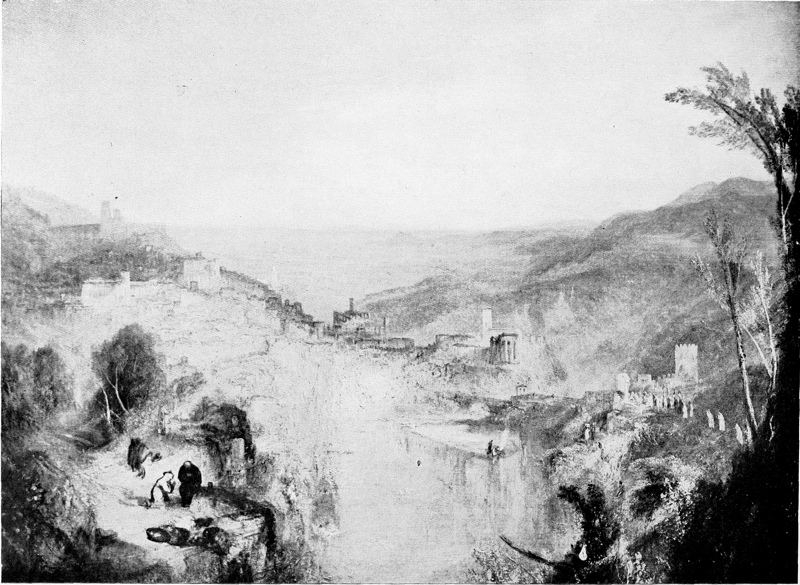
MODERN ITALY · J. M. W. TURNER
“L’IMPRESSIONISME, ELLE EST DIGNE DE NOTRE ADMIRATIVE ATTENTION, ET NOUS POUVONS RATIONNELLEMENT CROIRE QUE, AUX YEUX DES GÉNÉRATIONS FUTURES, ELLE JUSTIFIERA CETTE FIN DE SIÈCLE DANS L’HISTOIRE GÉNÉRALE DE L’ART”
GEORGES LECOMTE

ALTHOUGH the great revolution of 1793 changed the whole face of France both politically and socially, it failed to emancipate the twin arts of painting and literature. In each case one tradition was succeeded by another, and nearly forty years elapsed before the new spirit completely broke through the barriers set up by a past generation.
In literature the victory was complete. The reason is easy to discover. The smart dramatist and the young novelist are always more likely to catch the fickle taste of the uneducated public than the budding painter, who depends to a great extent for his appreciation upon the trained and generally prejudiced eye of a connoisseur. There is another reason for the success of the Romantic School in literature. The majority of its leaders lived to extreme old age, and were themselves able to correct their youthful extravagances. Hugo, Dumas, Gautier (to mention but three) went down to their graves in honour. They had outlived the antagonisms of their early days, and no man dared to raise his voice in protest against poets who had added fresh laurels to the glory of France.
The world of art was less fortunate. Many of the younger men barely lived through the first flush of youth. Destroying Death is the worst enemy to the arts. It is idle to imagine the changes which must have ensued had Géricault and Bonington reached the Psalmist’s allotted span. The unnatural union of Classical traditions with the yeast of Romanticism might not have taken place. Such artists as Delaroche and Couture would have dropped into the background, and there would have been less reason for the revolt of Edouard Manet. It is possible that Claude Monet might have been forestalled. Surely, Impressionism would have come to us in another shape from different easels. In any event it was bound to arrive, for a French artist had already struck the note nearly a century and a half before.
2The schools of painting which flourished under the last three Capet kings lacked many of the essentials of truly great art. But they possessed qualities, which the Classicalists despised, and the Romanticists never reached in exactly the same way. They possessed a strong sense of colour. Watteau, in particular, was the first to catch the sunlight. The painters of “les fêtes galantes” are artificial, unreal, dominated by mannerisms. But the cold inanities of David, Girodet, Gérard, and Gros are no more to be compared with them than the bituminous melodramatics of the lesser Romantic artists.
Watteau’s successors never entirely lost their master’s sense of light and colour. In a mild way Chardin attempted realism. Boucher, and, later, Fragonard were influenced by that Japanese art which was to take such a prominent place in the movement of a hundred years later. But the world altered. The stern, hard ideals of Rome and Greece were too severe for these poor triflers with the Orient. David reigned supreme. The Journal de l’Empire considered Boucher ridiculous. Unhappy, forgotten Fragonard, surely one of the most pathetic of figures, died in poverty whilst the drums of Austerlitz were still reverberating through the air.
Ingres, a pupil of David, taught his students that draughtsmanship was of more importance than colour. “A thing well drawn,” he said, “is always well enough painted.” Such teaching was bound to provoke dissent, and the germs of the coming revolution were to cross from England. Byron and Scott were the sources of the literary revolution which swept across Europe. British artists showed the way in the fight against tradition and form, which resulted in the School of Barbizon, and its great successor, the School of Impressionism.
Excluding the miniaturists, and such foreign masters as Holbein, Vandyck, Kneller, and Lely, English art could hardly boast one hundred consecutive years of history when its landscape artists first exhibited in the Paris Salon. The French School could not forget Italy and its own past. Even to this day the entrance to the École des Beaux-Arts is guarded by two colossal busts of Poujet and Poussin, and the supreme prize in its gift is the Prix de Rome. But English art has never been trammelled excessively by its own past, simply because it did not possess one, and, with insular pride, refused to accept that of the Continent.

Photo by W. A. Mansell & Co.
PETWORTH PARK · J. M. W. TURNER
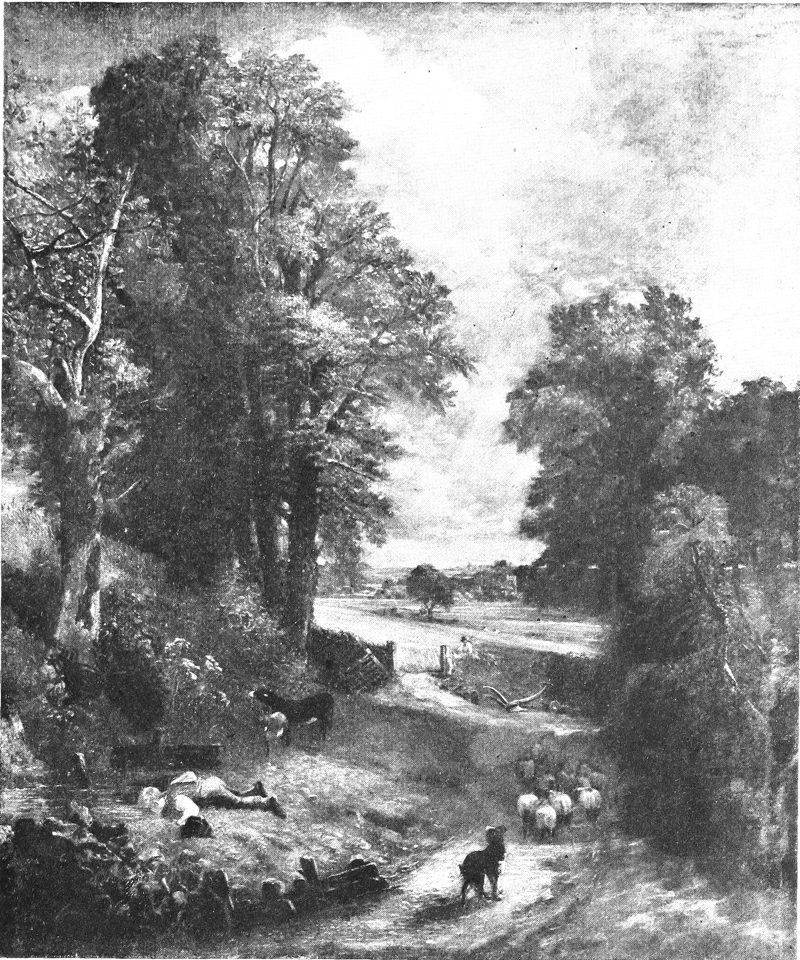
Photo by W. A. Mansell & Co.
THE CORN FIELD · J. CONSTABLE
Hogarth is a case in point. His education was slight and desultory; he did not indulge in the Grand Tour; he professed a truly British scorn for foreigners, uttering “blasphemous expressions against the divinity even of Raphael, Correggio, and Michelangelo.” 3He took his subjects from the life which daily surged under his windows in Leicester Square, and when he attempted a classical composition he utterly failed, and was promptly told so by his numerous enemies. His canvases form historical records of the men and women of the early Georgian era, in much the same manner as Edouard Manet represents the “noceurs” and “cocottes” who wrecked the Second Empire and reappeared during the first decade of the Third Republic.
Hogarth was a colourist, and the early English School was always one of colour and animation, attempting to follow Nature as closely as possible. Some of the slighter portrait studies of Sir Joshua Reynolds have a strong affinity to the work of the French Impressionists. Richard Wilson was not altogether blind to the beautiful world around him, although he considered an English landscape always improved by a Grecian temple. Gainsborough was decidedly no formalist, and whilst the lifeless group, comprising Barry, West, Fuseli, and Northcote, was endeavouring to inculcate the classical idea, the English Water-colour School began to appear, the Norwich School was in the distance, Turner’s wonderful career had commenced, and Constable, the handsome boy from Suffolk, was studying atmospheric effects and the play of sunlight from the windows of his father’s mill at Bergholt. In 1819 Géricault, one of the leaders of the reaction in France against Classicalism, paid a visit to England. He does not seem to have been greatly influenced by English work, owing no doubt to his lamentably early death. But his visit resulted in Constable and Bonington becoming known in France.
For years English painters exhibited regularly at the Salon. In 1822, the year when Delacroix hung Dante’s Bark, Bonington exhibited the View of Lillebonne and a View of Havre, whilst other Englishmen exhibiting were Copley Fielding, John Varley, and Robson. In 1824 the Englishmen were still more prominent. John Constable received the Gold Medal from Charles X. for the Hay Wain (now in the London National Gallery), and exhibited in company with Bonington, Copley Fielding, Harding, Samuel Prout, and Varley. In 1827 Constable exhibited for the last time, and, curious omen for the future, between the frames of Constable and Bonington was hung a canvas by a young painter who had never been accepted by the Salon before. His name was Corot, and he was quite unknown.
The influence of these Englishmen upon French painting during the nineteenth century is one of the most striking episodes in the history of art. They were animated by a new spirit, the spirit 4of sincerity and truth. The French landscape group of 1830, which embraced such giants as Corot, Rousseau, and Daubigny, was the direct result of Constable’s power. The path was made ready for Manet, who, though not a “paysagiste,” became the head of the group which included Monet, Sisley, and Pissarro. Forty years later the younger men sought fresh inspiration in the works of an Englishman. Indirectly, Impressionism owes its birth to Constable; and its ultimate glory, the works of Claude Monet, is profoundly inspired by the genius of Turner.
When the principles which animated these epoch-making English artists are contrasted with those which ruled the Impressionists, their resemblance is found to be strong. “There is room enough for a natural painter,” wrote Constable to a friend after visiting an exhibition which had bored him. “Come and see sincere works,” wrote Manet in his catalogue. “Tone is the most seductive and inviting quality a picture can possess,” said Constable. It cannot be too clearly understood that the Impressionistic idea is of English birth. Originated by Constable, Turner, Bonington, and some members of the Norwich School, like most innovators they found their practice to be in advance of the age. British artists did not fully grasp the significance of their work, and failed to profit by their valuable discoveries.
It was not the first brilliant idea which, evolved in England, has had to cross the Channel for due appreciation, for appreciated it certainly was not in the country of its origin. As the genius of the dying Turner flickered out, English art reached its deepest degradation. The official art of the Great Exhibition of 1851 has become a byword and a reproach. In English minds it stands for everything that is insincere, unreal, tawdry, and trivial.
The group of pre-Raphaelites, brilliantly gifted as they undoubtedly were, worked upon a foundation of retrograde mediævalism. And, as the years followed each other, English art failed as a whole to recover its lost vitality. Domestic anecdote, according to the formulæ of Augustus Egg, Poole, or, slightly higher in the scale, Mulready and Maclise, formed the product of nearly every studio. The false Greco-Roman convention of Lord Leighton luckily had no following. Rejuvenescence came from France in the shape of Impressionism, and English art received back an idea she had, as it proved, but lent.
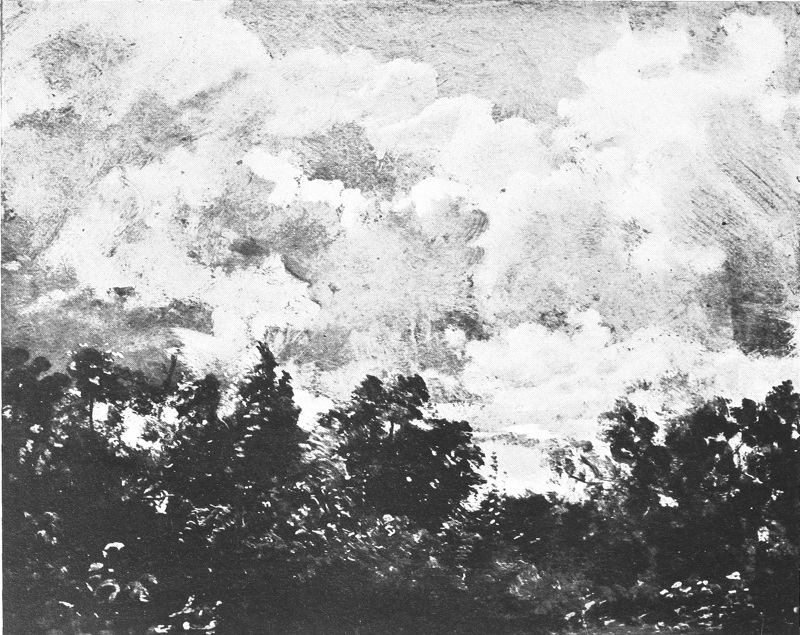
A STUDY · J. CONSTABLE
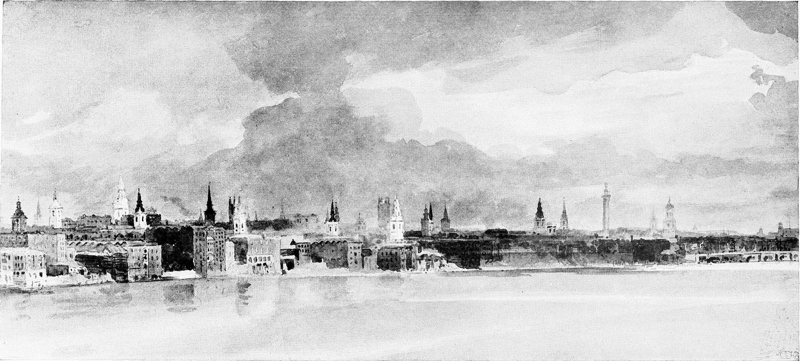
VIEW OF THE THAMES · THOMAS GIRTIN
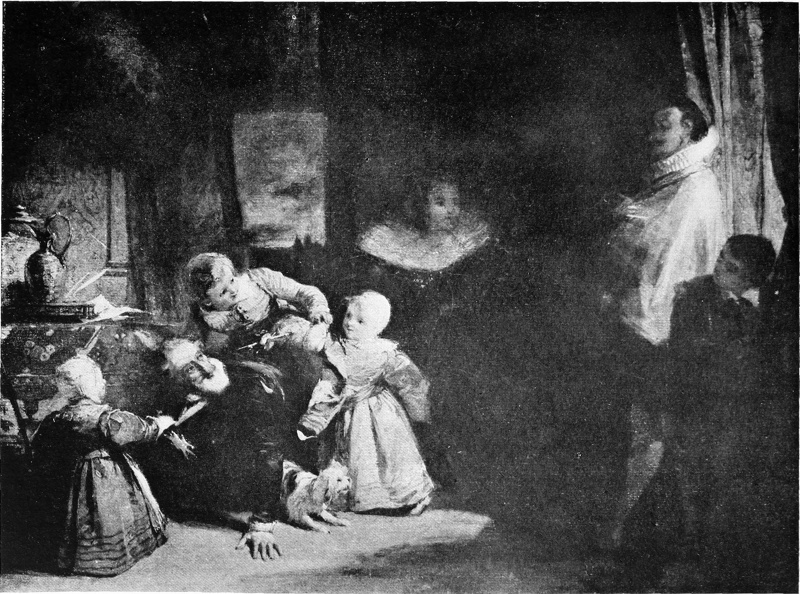
Photo by W. A. Mansell & Co.
HENRI IV. AND THE SPANISH AMBASSADOR · R. P. BONINGTON
Those Englishmen who are taunted with following the methods of the French Impressionists, sneered at for imitating a foreign style, are in reality but practising their own, for the French artists simply 5developed a style which was British in its conception. Many things had assisted this development, some accidental, some natural. All the Englishmen had worked to a large extent in the open. Now the atmosphere of France lends itself admirably to Impressionistic painting “en plein air.” All landscapists notice that the light is purer, stronger, and less variable in France than in England.
By thus working in the open both Constable and Turner, together with their French followers, were able to realise upon canvas a closer verisimilitude to the varying moods of nature than had been attempted before. By avoiding artificially darkened studios they were able to study the problems of light with an actuality impossible under a glass roof. They were in fact children of the sun, and through its worship they evolved an entirely new school of picture-making. The Modern Impressionist, too, is a worshipper of light, and is never happier than when attempting to fix upon his canvas some beautiful effect of sunshine, some exquisite gradation of atmosphere. Who better than Turner can teach the use and practice of value and tone? In triumph he fixed those fleeting mists upon his immortal canvases, immortal unhappily only so long as bitumen, mummy, and other pigment abominations will allow.
The technical methods of the French Impressionists and of the early English group vary but little. The modern method of placing side by side upon the canvas spots, streaks, or dabs of more or less pure colour, following certain defined scientific principles, was made habitual use of by Turner. Both Constable and Turner worked pure white in impasto throughout their canvases, high light and shadow equally, long before the advent of the Frenchmen.
An example of this was to be seen in a large painting by Constable hung in the Royal Academy Winter Exhibition of 1903. The Opening of Waterloo Bridge, exhibited in 1832, was declared by the artist’s enemies to have been painted with his palette-knife. Almost the whole of the canvas, especially the foreground, is dragged over by a full charged brush of pure white, which, catching the uneven surface of the underlying dry impasto work, produces a simple but successful illusion of brilliant vibrating light.
This work was not well received by the contemporary press and public. It was regarded as a bad joke, became celebrated as a snowstorm, compared with Berlin wool-work (a favourite simile which Mr. Henley has recently applied to Burne-Jones), and was derided as the product of a disordered brain. Seventy years have barely sufficed for its full appreciation.
By a curious coincidence Bonington’s Boulogne Fishmarket was 6hung almost exactly opposite in the same Winter Exhibition. This canvas must have had an enormous influence with Manet, its blond harmony and rich flat values within a distinct general tone being a distinguishing feature of the great Frenchman’s style.
The Impressionists, therefore, continued the methods of the English masters. But they added a strange and exotic ingredient. To the art of Corot and Constable they added the art of Japan, an art which had profoundly influenced French design one hundred years before. The opening of the Treaty ports flooded Europe with craft work from the islands. From Japanese colour-prints, and the gossamer sketches on silk and rice-paper, the Impressionists learnt the manner of painting scenes as observed from an altitude, with the curious perspective which results. They awoke to the multiplied gradation of values and to the use of pure colour in flat masses. This art was the source of the evolution to a system of simpler lines.
In colour they ultimately departed from the practice of the English and Barbizon Schools. The Impressionists purified the palette, discarding blacks, browns, ochres, and muddy colours generally, together with all bitumens and siccatives. These they replaced by new and brilliant combinations, the result of modern chemical research. Cadmium Pale, Violet de Cobalt, Garance rose doré, enabled them to attain a higher degree of luminosity than was before possible. Special care was given to the study and rendering of colour, and also to the reflections to be found in shadows.
So far as the term implies the position of teacher and pupils, the Impressionists did not form themselves into a school. On the contrary, they were independent co-workers, banded together by friendship, moved by the same sentiments, each one striving to solve the same æsthetic problem. At the same time it is possible to separate them into distinct personalities and groups.
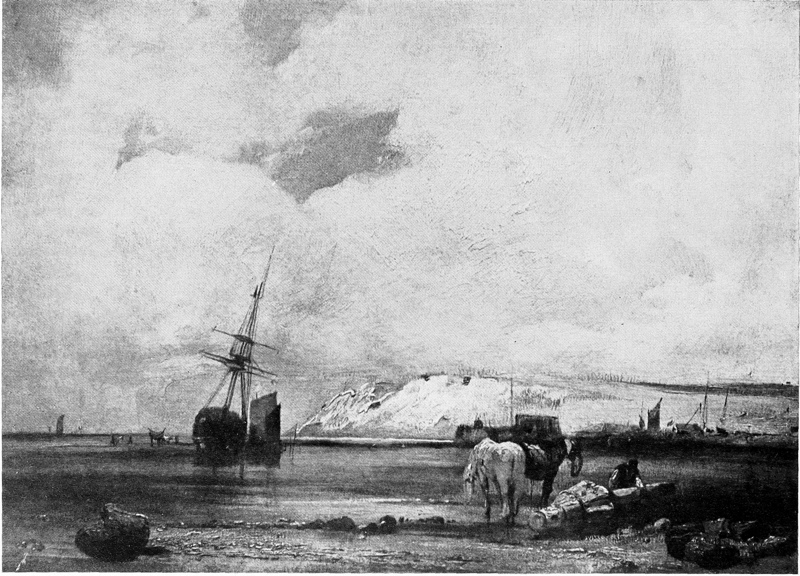
Photo by W. A. Mansell & Co.
A COAST SCENE · R. P. BONINGTON
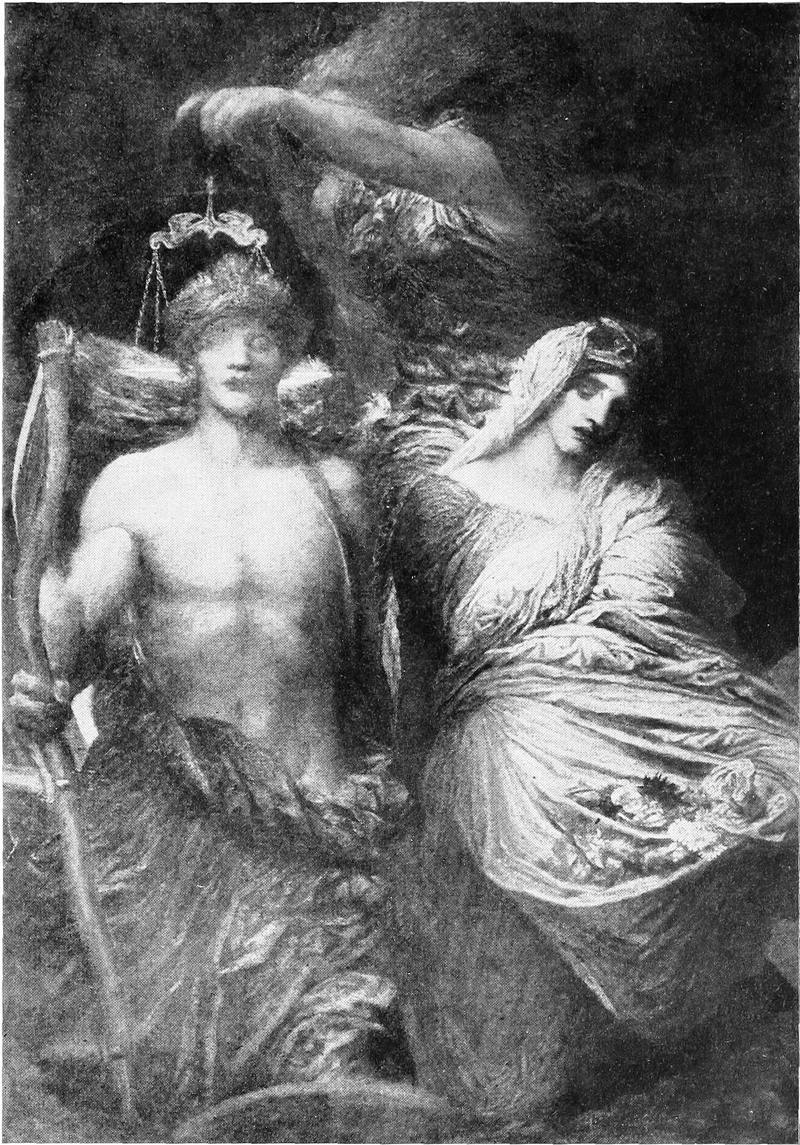
Photo by Fredk. Hollyer
TIME, DEATH, AND JUDGMENT · G. F. WATTS
Edouard Manet occupies a position alone. His work can be separated into two periods, divided by the year 1870. His earlier work deeply influenced Claude Monet, who was a prominent member of the group which gathered round Manet at the Café Guerbois. After 1870 the position was slightly changed, for, although he retained the nominal leadership of the group which was now known under the title of Impressionists, Manet was influenced by the technique of Claude Monet. The question has yet to be decided whether Manet or Monet was the founder of the new school. Monsieur Camille Mauclair declares for the latter, stating that Manet’s pre-eminence was due to the attention he attracted by 7his excessive realism, and that Claude Monet was the true initiator. It may be admitted that Impressionism, as the phrase is now understood, did not really gather force until 1867. Claude Monet was greatly attracted by Manet’s work as early as 1863, and upon these new methods he seems to have based his own, widened though after his visit to London with Pissarro in 1870.
During his lifetime Manet was the recognised head, and around him was formed the famous circle of the Café Guerbois, which became known as the School of Batignolles. This included Monet, Pissarro, Sisley, Cézanne, Renoir, and Degas. If there is one man greater than the others it is Claude Monet. Only during comparatively recent years have his originality and strength been generally recognised. He now occupies the position held by Manet, although he cannot be said to be Manet’s successor. Manet painted the figure, seldom attempting landscape, a genre which is primarily Monet’s. Claude Monet is doubly indebted to English art. Profoundly moved by Turner, whose works he studied at first hand in England, he also traces an artistic descent through Jongkind and Boudin from Corot, who caught the methods of Constable and Bonington.
Jongkind and Boudin are two little masters not to be forgotten. Not altogether Impressionists themselves, they were in close affinity to the school upon which they had much influence. Men of uncommon character and earnestness of purpose, their art was sincere. In themselves they were interesting, for, richly endowed with natural talents, they were for the most part poor beyond belief in material wealth. Inspired by a genuine love for Nature in all her aspects they never reached the high technique of their English predecessors, and were far surpassed by Claude Monet and his group. Forerunners in the evolution of the school of “plein air” painting, a reference is necessary to them in order to follow the development of the school as a whole.
For the first time in the history of art women have taken an active part in founding a new school. Madame Berthe Morisot, Miss Mary Cassatt, and Madame Eva Gonzalès must be included amongst the early Impressionists.
Various movements based upon the Impressionistic idea have taken place in France and on the Continent generally. There are the Pointillistes for instance, and the Neo-Impressionists. Amongst foreign artists Whistler must be mentioned; a student at Gleyre’s he attended at the Café Guerbois, and embraced many of Manet’s ideas.
8The history of the early battles over Impressionism centres for the most part round one personality. In following the story of the failures and successes of Edouard Manet we follow the gradual rise of the entire school, for no man fought more bravely in defence of its principles.
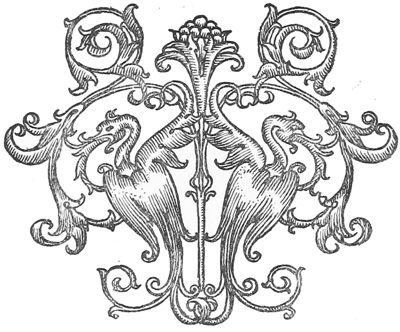
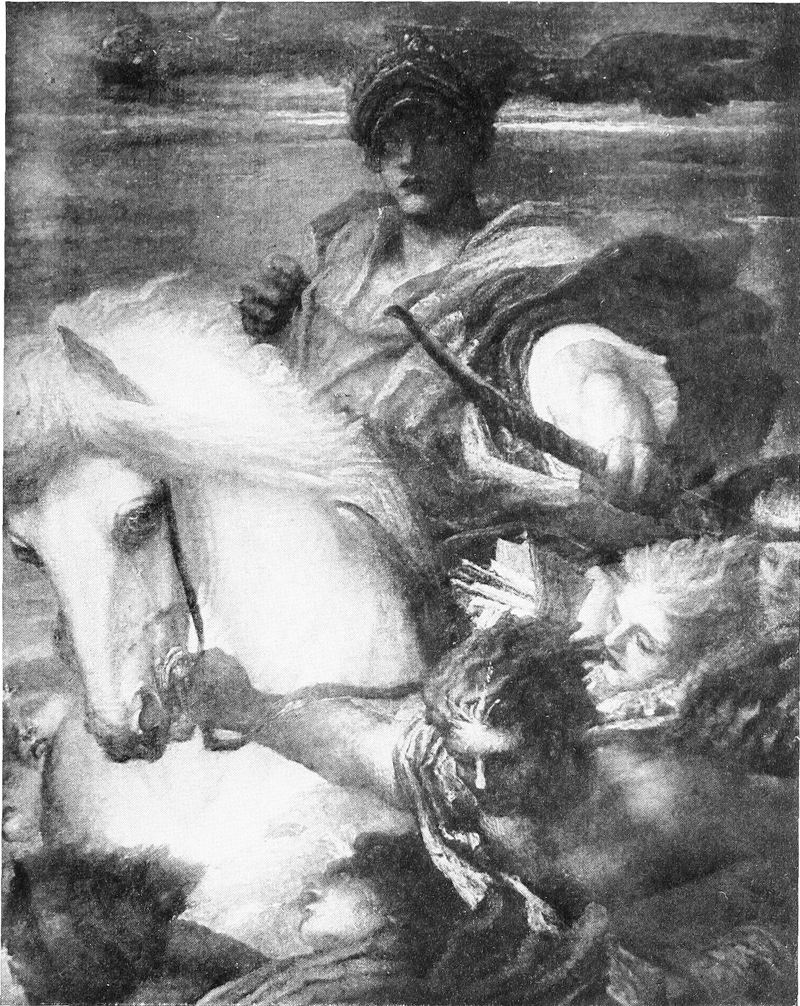
Photo by Fredk. Hollyer
RIDER ON THE WHITE HORSE · G. F. WATTS
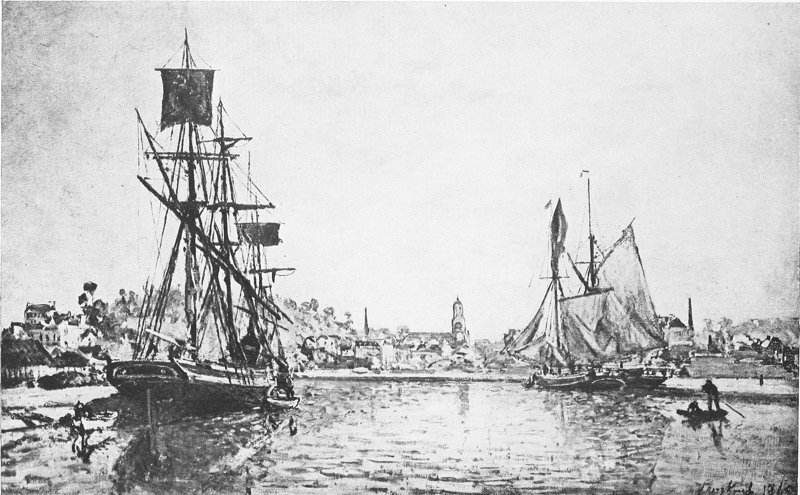
VIEW OF HONFLEUR · J. B. JONGKIND
“ILS PRENNENT LA NATURE ET ILS LA RENDENT, ILS LA RENDENT VUE À TRAVERS LEURS TEMPÉRAMENTS PARTICULIERS. CHAQUE ARTISTE VA NOUS DONNER AINSI UN MONDE DIFFÉRENT, ET J’ACCEPTERAI VOLONTIERS TOUS CES DIVERS MONDES”
ZOLA

JONGKIND and Boudin are the links which connect the Barbizon men of 1830 to the Impressionist group of 1870. Although little public fame came to them during their lifetime, they had considerable influence upon the younger landscape-painters of their generation. Both were artists of great ability as well as of enormous industry; both suffered from continued misfortune and neglect. Yet no collection illustrating the history of Impressionism can exclude examples of the Dutch Jongkind, or of Boudin, a follower of Corot and master of Monet. Jongkind’s pictures are doubling, nay trebling, in value, and the records of the public sale-rooms are astounding evidences of the increasing appreciation of Boudin by modern collectors.
The biographies of Jongkind and Boudin form excellent texts over which one may moralise upon the uncertainties of art as a career. It is not often that the Fates compel two men to struggle for so long against such hopeless and wretched surroundings. The life of Jongkind was a life of continued misery. Towards its end he utterly gave way, and died a dipsomaniac. Boudin possessed a little more grit, although his surroundings were not more propitious. He lived almost unnoticed until a beneficent Minister awarded him the greatest prize a Frenchman can receive on this earth, the Cross of the Legion of Honour.
Johann Barthold Jongkind was born at Lathrop, near Rotterdam, in 1819. Dutch by birth, many years’ residence in France, together with a strong sympathy with Gallic ways, made him almost a citizen of his adopted country, and certainly a member of the French School of Painting. At first he was a pupil of Scheffont, and afterwards he worked under Isabey. At the Salon of 1852 he obtained a medal of the first class, and then for years in succession was rejected by the juries. Almost at the end of his life he was offered the long-coveted decoration, but he was never a popular artist, nor even well known 10amongst the art public. A few amateurs bought his works, his water-colours were lost in old portfolios, and the exhibition of his pictures previous to the sale after his death was a revelation alike to painters and critics. His life was a sad history of neglect, terrible privation, and want. All that we know of him is that he gave way to alcoholism, dying in Isère in 1891, alone, friendless, and forgotten.
Jongkind was one of the very first men in France to occupy himself with the enormous difficulties surrounding the study of atmospheric effects, the decomposition of luminous rays, the play of reflections, and the unceasing change crossing over the same natural form during the different hours of the day. His influence over several of the more prominent men of the Impressionist group was great. Edouard Manet was strongly impressed by his methods, and Claude Monet refers to him as a man of profound genius and originality of character, “le grand peintre.”
In the sale-rooms Jongkind’s water-colours and etchings are now reaching very high prices, although one cannot agree that they are his most remarkable creations. Works the artist was content to sell for £4 to £8 now change hands under the hammer at sums ranging from £160 to £800. The best canvases were painted towards the end of his life, especially those depicting the luminous atmosphere of the beautiful Dauphiné countryside. His large landscapes are extremely unequal, somewhat hard and dry in technique, and more or less stereotyped in the choice of subject. His pictures do not always convey the true feeling for atmospheric effect, and many are simply experiments which lack the great quality of charm. Without a doubt he possessed extraordinary ability, but he lacked the illuminating spark of genius. He pointed out a way he was not himself strong enough to follow.
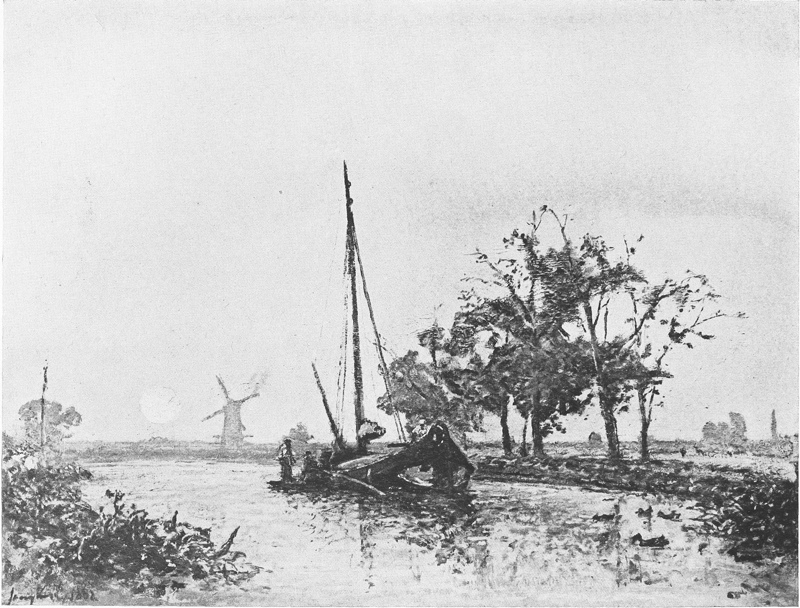
MOONRISE · J. B. JONGKIND
Louis-Eugène Boudin, an old comrade and life-long friend of Jongkind, is the head of the group of “little masters” who reigned during the transitional period in French landscape art between 1830 and 1870. He was born in the Rue Bourdet, Honfleur, on July 12, 1824, and died within a few miles of his birthplace in 1898. He leaves a magnificent record of work accomplished, and the memory of a noble life devoted to a beautiful ideal. Pissarro, in a letter addressed to the writer, says that Boudin had much influence upon the advancement of the Impressionist idea, particularly through his studies direct from Nature. His father was a pilot on board the steamboat François of Havre, a bluff and hearty sailor, typical of the coast nearly a century ago. A good specimen is to be found in the 11burly guardian of the Musée Normand at Honfleur, who, by a coincidence not altogether strange in this world of coincidences, travelled round the world with old Boudin, and knew intimately “le petit Eugène.”
The boy’s mother was stewardess on board the boat her husband piloted, and the artist commenced life in the humble and not altogether enviable capacity of cabin-boy. In that position he remained until his fourteenth year, travelling from French and English ports as far as the Antilles. At that age an irresistible desire came over his soul. He wished to quit seafaring life and devote himself to the brush. He had already made many sketches in bitumen, some having attracted attention from passengers. Those which have been preserved display wonderful proficiency, considering the many difficulties the boy had to labour under. Chance helped the youth; for his father, tiring of his endless struggle with the elements, retired from his post and opened a little stationery shop on the Grand Quai at Havre. The cabin-boy became shop-boy.
This new mode of life gave him far greater time to follow his inclinations. All untaught he applied himself assiduously to draughtsmanship, painting on the quays, in the streets, devoting Sundays and fête-days to long excursions amongst the hills round about Havre. One day Troyon brought a canvas for framing to the elder Boudin’s shop. In the corner he noticed some curious little pastels of the shipping and harbour. Eugène made his first artistic friendship. Troyon, who was living in great poverty, only too pleased to sell a picture for twenty-five francs, was of great assistance to the lad. Another customer helped young Boudin. Norman by birth, son of a seaman, Jean-François Millet met the boy in Havre and was attracted by his evident skill. Millet was in the same quandary as Troyon; stranded in semi-starvation, he was executing portraits at thirty francs per head, diligently canvassing the retired ebony merchants, the harbour officials, the sailors and their sweethearts. Alphonse Karr and Courbet, whilst wandering through Normandy, became acquainted with Boudin’s sketches, and sought out the young artist.
Eugène Boudin’s career was now determined. The advice of friends was vain. They pointed out that if Corot with his immense talent was unable to earn an independence at the age of fifty, an untrained shop-boy had still less chance. No man could tell a more bitter story of the artist’s life than Millet, and he attempted to persuade the boy to keep to the shop. All efforts were fruitless. Couture and a few other associates obtained a small student’s allowance 12from the Havre Town Council, and Boudin set out for Paris. The bursary of one pound weekly soon came to an end, and left the artist without resources or friends. He paid for his washing with a picture valued at the sum of forty francs. The laundress immediately sold the work to cover her bill, and the canvas has recently changed hands for four thousand francs. His “marchand de vin” exchanged wine for pictures which have lately passed through the sale-rooms at forty times their original agreed values. By these means, together with a few portrait commissions, Boudin managed to eke out a most precarious existence.
From 1856 dates the foundation of the “Ecole Saint Simeon,” (so called from the rustic inn and farmhouse on the road from Honfleur to Villerville, halfway up the hill overlooking Havre and the mouth of the Seine), in which Boudin took a prominent part. In 1857 the artist exhibited ten pictures at the local Havre exhibition, which he followed with a sale by auction, his idea being to raise enough money to pay his expenses back to Paris. Claude Monet had been sending several pressing letters of invitation, holding out fair prospects of business with several art dealers. The sale was a complete failure, producing a net sum of £20. Boudin gave up his hopes of Paris and returned to the farmhouse of Saint Simeon saddened and discouraged. Roused by “la mère Toutain,” he opened an academy of painting, and the old inn of Saint Simeon may be called the cradle of French Impressionism.
For twenty-five years it formed the resting-place, from time to time, of all the most celebrated men of the group. The list is a long one—Millet, Troyon, Courbet, Lepine, Diaz, Harpignies, Jongkind, Cals, Isabye, Daubigny, Monet, and many others. Boudin always regretted that there was no history written of the place, no record of the scenes which took place there. One has the same regret over many other famous sketching grounds and artistic inns in France. What stories can be told of the joyous life, of the good fellowship, the games and escapades, the brilliant jokes of many a world-renowned genius in playful mood, happy little bands of men with the spirit and souls of children!

RETURN OF THE FISHING SMACKS · EUGENE BOUDIN
The hostesses are of a type apart, and no other country but France produces them in such numbers. “Mères des artistes,” they are full of pride with their anecdotes of celebrated lodgers. Peasants of the best class, admired and respected by all who come into contact with them, they are remembered with affection. The peaceful holidays spent in these lovely villages represent much of the brighter side of the art-student’s career, and memories mix with regrets as 13one recalls a youth spent in that beloved country of art—la belle France.
Boudin’s academy of painting at the inn was no great success, and he changed his habitat to Trouville, twenty miles down the coast, at the invitation of Isabey and the Duc de Morny. They suggested that he should paint “scènes de plage” of that gay and fashionable watering-place, the bathers, the frequenters of the Casino and the racecourse, the regattas, the “landscapes of the sea” as Courbet called them. “It is prodigious, my dear fellow; truly you are one of the seraphim, for you alone understand the heavens,” cried Courbet one day in excitement as he watched Boudin at work. Boudin was at last becoming famous. Alexandre Dumas addressed him as, “You who are master of the skies, ‘par excellence,’” and above all came the testimony of Corot, who described him as “le roi des ciels.”
Unfortunately, the public did not buy Boudin’s pictures, and he remained in poverty. In 1864 he married, his wife receiving a “dot” of 2000 francs, and a home was made up four flights of rickety stairs in a mean street in Honfleur, the rental of the garret being thirty-five shillings per annum. Amongst their visitors the saddest was Jongkind, the man of failure, a reproach to the blindness of his generation, and a warning to those who seek fortune by the brush. It was only by the combination of courage, energy, and robust health that Boudin was able to fight his way through actual periods of starvation in order to live to see his work justified by public appreciation.
Four years later the little household was moved to Havre. Boudin was reduced to such absolute poverty that he was not able to provide himself with sufficient decent clothing to visit a rich tradesman of the town, who had commissioned some decorative panels. The commission was lost, and the fight for bread was keener than before. During the winter furniture was converted into firewood, and the artist worked as an ordinary labourer. Boudin hated Paris, but at the urgent solicitation of artists, who promised him work, he left Havre for the metropolis. Ill luck still dogged his steps. No sooner had he settled with his wife in the new quarters than the war broke out with all the unendurable misfortunes of “l’année terrible” in its train.
Hopes of commissions were at an end, the art colony being scattered far and wide. Boudin fled first to Deauville, then to Brussels. Crowded with French refugees, the struggle for life entered its bitterest stage. For the second time Boudin became a day-labourer. At last, by a most trifling chance, his wretched position 14was altered for the better. By hazard Madame Boudin met a picture-dealer whilst marketing, and his appreciation and encouragement enabled the artist to return to his easel. The artist’s progress was, however, extremely slow. Nine years later he held an auction sale of his pictures, at which four paintings realised £21. A friend who had joined in the sale was more unfortunate, for he sold nothing. “You see,” he wrote to Boudin, “that nothing succeeds with me. I don’t know how it will all finish. What upsets me most in the midst of all this worry is the fear that I should lose all love for painting.” This phrase must have represented Boudin’s thoughts during the long years of disheartening struggle.
In 1881, after twenty-three years of almost annual exhibition in the Paris Salons, Boudin obtained a medal in the third class. Nowadays this award is usually made to the young man who exhibits for the first time. Three years later Boudin received a medal of the second class, which exempted his work from judgment by the jury, and places its recipient “hors concours.” He commenced, at the age of fifty, to sell his pictures more regularly, but at prices extremely low and out of proportion to their present value. At the Hôtel Drouot, Paris, in 1888, one hundred canvases by Boudin fetched the grand total of £280. It is difficult to estimate what sum such a lot would reach at the present day.
The tide had changed, for the Government bought a large painting, Une Corvette Russe dans le Bassin de l’Eure au Havre for the Luxembourg. In 1889, public honour was marred by the most mournful blow. To his inconsolable grief his wife died, after twenty-five years of the happiest companionship. Amongst the letters of sympathy were many acknowledgments of the artist’s genius, notably from Claude Monet, “in recognition of the advice which has made me what I am”—a striking and flattering phrase from the head of the Impressionist group. In this same year Boudin was awarded the gold medal at the Salon. In 1896 the Government purchased his Rade de Villefranche for the Luxembourg, and the old artist received from the hands of Puvis de Chavannes, at the recommendation of the Minister Léon Bourgeois, the ribbon and cross of the Legion of Honour.
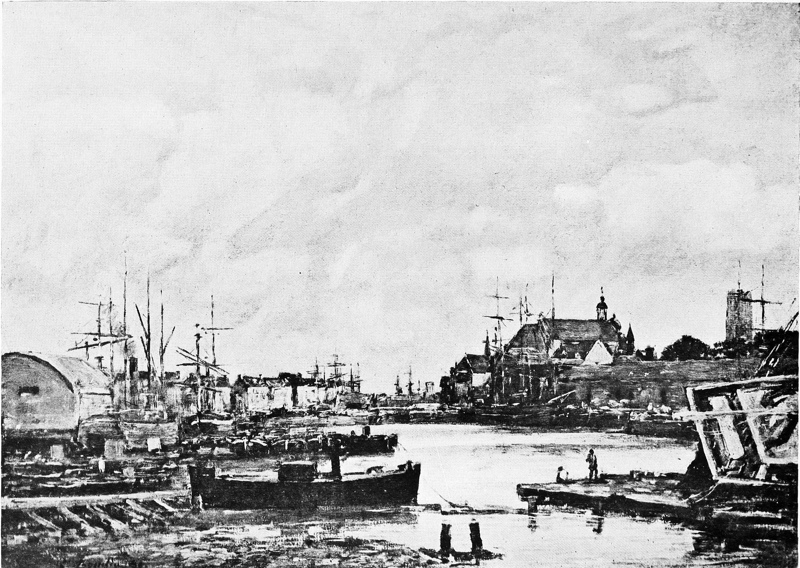
THE REPAIRING DOCKS AT DUNKIRK · EUGENE BOUDIN
Boudin’s health, weakened by the long privations, had at last broken up. After several futile journeys he returned to his native Normandy, and, whilst working at his easel in his châlet near Deauville in 1898, died almost without warning. By his will he left a rich legacy of pictures to the gallery of his native town, Honfleur. Over one hundred of Boudin’s sketches can now be 15seen in the public gallery of Havre. Boudin’s connection with modern Impressionism is chiefly the influence generated by a strong enthusiasm for working “en plein air” and a deep love of Nature. His dominant colour, almost to the end of his life, was grey—a grey beautiful in its range and truthful in its effect. Personally Boudin had the head of an old pilot, with healthy ruddy complexion, white beard, and keen blue eyes. He spoke slowly in low monotonous tones, was doggedly tenacious of an idea, had strong artistic convictions. He was modest to a degree, and when he sought honours they were for brother artists, never for himself. His highest ambition was reached when the Town Council of Honfleur named a street “Rue Eugène-Boudin.” This street, long, narrow, hilly, with many rough places and occasional pitfalls, typifies the artist’s own life. After his death the town went further. Aided by M. Gustave Cahen, president of the “Société des Amis des Arts,” Honfleur erected a fine statue of its talented son by the jetty, where he had so often painted his favourite scenes of sea and shipping.
Boudin has left a name which will be honoured in the annals of French art. He lived a long life, produced many works of which not one falls below his own high standard. His position, midway between two great schools, is perhaps one reason why he has not loomed more strongly in the public appreciation. Upon their merits his pictures cannot easily be forgotten. When it is remembered that he links Corot to Monet, was in fact the true master of the latter, it will be seen what an important niche he occupies in any history devoted to Modern French Impressionism.
From Boudin is an easy step to Cézanne, one of the pioneers of the movement before 1870. Paul Cézanne and Zola were schoolboys together in Aix. They left Provence to conquer Paris, and whilst Zola was a clerk in Hachette’s publishing office Cézanne was working out in his studio the early theories of Manet, of whom he was an enthusiastic admirer. Both men frequented the Café Guerbois, and there is little doubt that in the remarkable series of articles contributed to De Villemessant’s paper “L’Événement,” Zola was assisted by Cézanne, who had introduced the journalist to the artists he had championed. When the criticisms were republished in 1866, in a volume entitled “Mes Haines,” Zola dedicated the book in affectionate terms, “A mon ami Paul Cézanne,” recalling ten years of friendship. The writer went still further, for the character of Claude Lantier, hero of “L’Œuvre,” a novel dealing largely with artistic life and Impressionism, is generally supposed to have been suggested by the personality of Paul Cézanne.
16For years Cézanne seldom exhibited, and his pictures are not known amongst the public. As to their merits, opinion is curiously divided. He has painted landscapes, figure compositions, and studies of still-life. His landscapes are crude and hazy, weak in colour, and many admirers of Impressionism find them entirely uninteresting. His figure compositions have been called “clumsy and brutal.” Probably his best work is to be found in his studies of still-life, yet even in this direction one cannot help noting that his draughtsmanship is defective. It is probable that the incorrect drawing of Cézanne is responsible for a reproach often directed against Impressionists as a body—a general charge of carelessness in one of the first essentials of artistic technique. Apart from this defect, Cézanne’s paintings of still-life have a brilliancy of colour not to be found in his landscapes.
In his student-days this artist had a great admiration for Veronese, Rubens, and Delacroix, three masters who had some influence upon Manet. Some of his latter methods showed a strong sympathy with the Primitives. The modern symbolists are his descendants, and Van Gogh, Emile Bernard, and Gauguin owe much to his example. Personally he unites a curiously shy nature with a temperament half-savage, half-cynical. Cézanne’s work is remarkable for its evident sincerity, and the painter’s aim has been to attain an absolute truth to nature. These ambitions are the keynotes of Impressionist art.
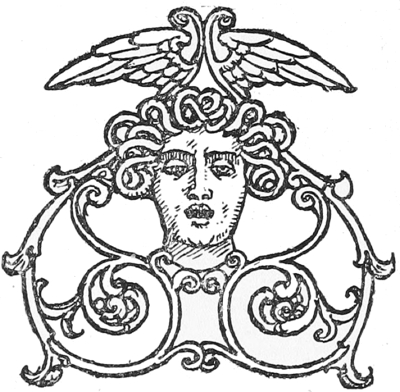
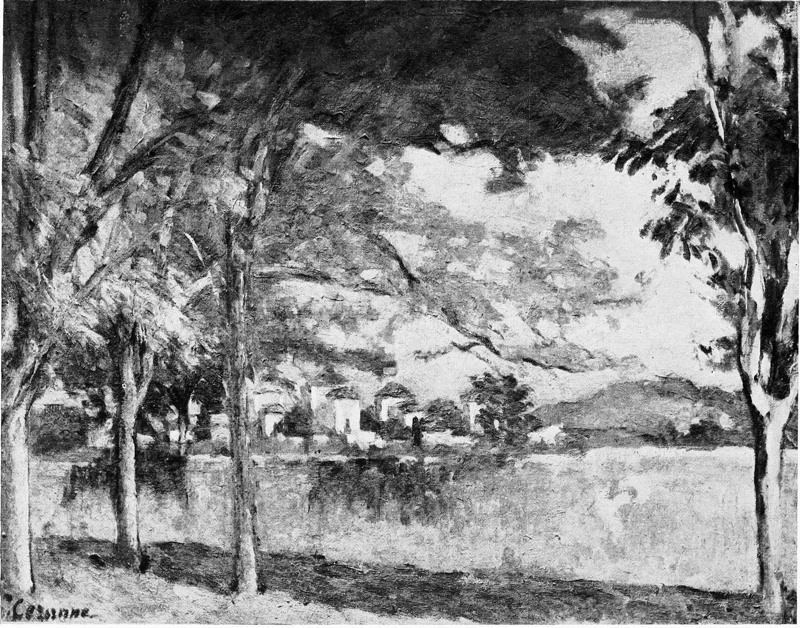
LA ROUTE · PAUL CÉZANNE
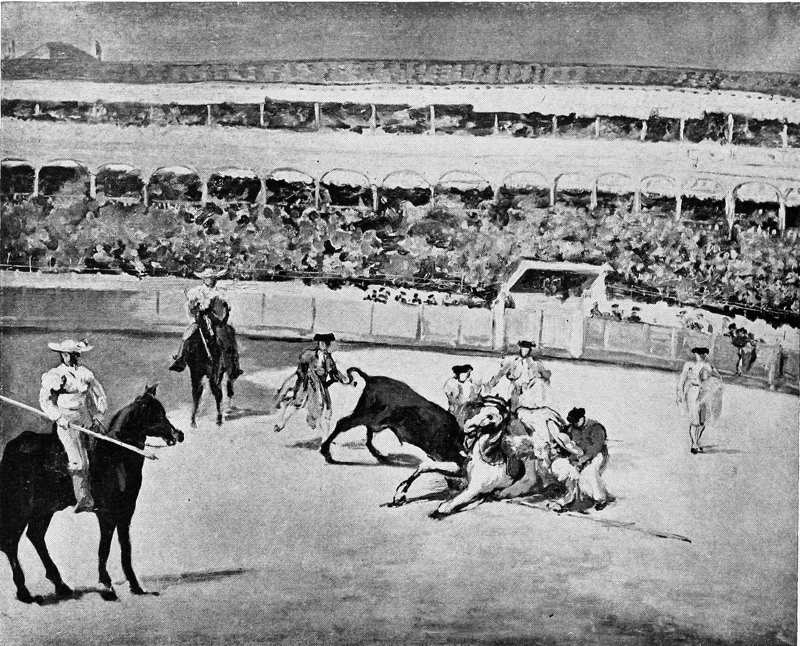
THE BULLFIGHT · EDOUARD MANET
“CE QUI ME FRAPPE D’ABORD DANS CES TABLEAUX, C’EST UNE JUSTESSE TRÈS DÉLICATE DANS LES RAPPORTS DES TOUS ENTRE EUX.
“TOUTE LA PERSONNALITÉ DE L’ARTISTE CONSISTE DANS LA MANIÈRE DONT SON ŒIL EST ORGANISÉ: IL VOIT BLOND, ET IL VOIT PAR MASSES”
ZOLA

FOR over twenty years the technique and methods of Edouard Manet were a subject for the most virulent debate. His art, in fact, became the scene of a battle in which every painter in Europe had a hand. Officialdom found no place for him in its heart, no matter whether the State was Imperial or Republican. The Empress Eugénie once asked that his pictures might be removed from public exhibition; President Grévy demurred when the artist’s name was placed on the list for the Legion of Honour. Clearly this man was no supporter of the established order of things. Refused recognition as an artist by the school of tradition, disowned by his own teacher, a source of hilarity to the public, Edouard Manet caught but a glimpse of the long-wished-for land of success which he was fated never to enjoy fully.
The battle is not quite finished, and the rout of the old school continues to the present day. One result remains. Manet has had a greater influence upon the art of the last forty years than any other master during that period, and the standard which he raised has become a rallying-point for the greatest painters of the present age.
Edouard Manet was born in Paris on January 23, 1832, at No. 5, Rue des Petits Augustins. Thirty-six years previously Corot was born round the corner, in the Rue du Bac. To-day the Rue des Petits Augustins is a long street running through the Latin Quarter, southwards from the Seine and the Louvre, known as the Rue Bonaparte. It has become the chief mart for commerce in artists’ materials, photographs, pictures, and all the odds and ends which fill up a studio. With a quaint appropriateness, the birthplace of Manet faces the École Nationale des Beaux-Arts.
The boy was the eldest of three brothers. His father was a judge attached to the tribunal of the Seine, and the family had been connected with the magistrature for generations. First a pupil at 18Vaugirard, under the Abbé Poiloup, Manet then entered the Collège Rollin, took his baccalaureate in letters, and grew into an elegant man of the world. But his inclinations clashed with his duties, and his uncle, amateur artist and colonel in the artillery, taught him how to sketch in pen and ink. M. Antonin Proust describes the result in a recent magazine article.
“From earliest years,” he writes, “Manet drew by instinct, with a firmness of touch and vigour unexcelled even in his latest works. His family was intensely proud of the boy’s uncommon gift, and his artistically-inclined uncle, Colonel Fournier, supported him against his father, who—despite his admiration—had other views as to his son’s career.”
“One should never thwart a child in the choice of his career,” said Colonel Fournier.
“If,” replied the father, “the boy is not inclined towards the ‘Palais,’ let him follow your example and become a soldier; but go in for painting—never!”
A studio-stool tempted the boy far more than a probable seat on the Bench. If he had to waste time, it should not be in the Salle des Pas Perdus.
His parents sent him, towards the close of his school-days, upon a voyage to Rio de Janeiro, hoping that travel might distract his mind from thoughts of an artistic life. It is said that they contemplated a naval career. Charles Méryon, it may be remembered, made the voyage round the world in a French corvette before he took up the etcher’s needle. Like Méryon, Manet improved his draughtsmanship, although a sailor. He sketched incessantly. One day the captain asked him to get out his paints and touch up a cargo of Dutch cheeses, which had become discoloured by the sea. “Conscientiously, with a brush,” says Manet, “I freshened up these têtes de mort, which reappeared in their beautiful tints of violet and red. It was my first piece of painting.”
His voyage in the Guadeloupe ended, he returned home with unaltered determination. After some protest his father relented, and in 1850 Manet entered the studio of Thomas Couture.
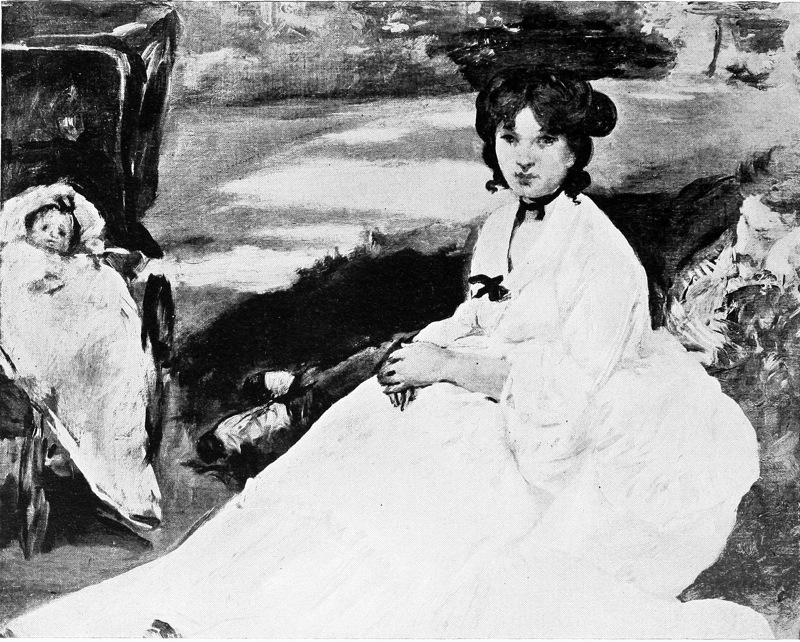
THE GARDEN · EDOUARD MANET
Couture occupied a leading position in that group sometimes called the “juste milieu.” Between the Romanticists and the Classicalists his preferences perhaps were for the latter. Of extreme irritability in temper, with a deep contempt for those in authority, he combined a keen desire for success both popular and financial. His picture, The Romans of the Decadence, in the Salon of 1847, brought both, and for a few years he remained one of the most celebrated 19artists in France. Then he criticised Delaroche, with the usual result when one painter puts another right: he offended King Louis-Philippe, he insulted the Emperor Napoleon III. Kings must be taken at their own valuation, if one wishes to enjoy their good graces. It was not surprising that Couture ultimately became a disappointed and forgotten man.
He has been called an Apostle of Classicalism. Taught first by Baron Gros, who vacillated from one school to the other, and afterwards by Delaroche, who endeavoured to reconcile the opposing parties, Couture could hardly have taken any other position in the art world of the ’forties. “He was apart among the painters of the day, as far removed from the cold academic school as from the new art just then making its way, with Delacroix at its head. The famous quarrel between the Classical and Romantic camps left him indifferent. He was of too independent a nature to follow any chief, however great.” This is the testimony of an American artist, Mr. P. A. Healy, who studied under Couture about the time Manet was in the atelier, and shows that the future Impressionist worked under a man by no means curbed by tradition. According to his pupil, Couture’s great precept was, “Look at Nature; copy Nature.” Manet’s doctrine was couched in almost the same words, “Do nothing without consulting Nature.”
We know that during the time Manet remained in Couture’s studio, master and pupil quarrelled incessantly. The reason usually given is that Manet would not respect tradition. But neither would Couture. “That in the captain’s but a choleric word, which in the soldier is flat blasphemy.” One was there to teach, the other to be taught. The temperaments of the two men were fundamentally different. The thick-set, scowling Couture, of shoemaker descent, would naturally rub against the grain of the rather dandified young scion of the magistrature. Couture hated the middle classes, and Manet belonged to the “haute bourgeoisie.” Manet’s family was legal to the bone, and Couture detested lawyers even more than he disliked doctors. With all these drawbacks Couture was admittedly the best teacher in Paris. Manet evidently recognised the advantage, for he remained in the studio for six years, until he was twenty-five years of age, although quite able to sever the connection had he wished.
Then came the “wanderjahre,” which commenced in 1856. Manet visited Germany, Holland, and Italy. In the Low Countries, Franz Hals exerted a great and permanent influence over the student; Rembrandt was copied in Germany; in Italy, Titian and Tintoretto 20received his homage. Dresden, Prague, Vienna, Munich, Venice and Florence were visited. Upon his return to Paris he copied assiduously in the Louvre, and it was in this wonderful gallery that he so thoroughly mastered all that a young painter could learn from the Spanish School. He did not visit Madrid until 1865. His Spanish subjects before that date were the result of a careful study of Velazquez and Goya in the National Collection and the visit of an Iberian troupe of players to Paris. In the Louvre he copied paintings by Velazquez, Titian, and Tintoretto.
Of living artists Courbet considerably influenced the first period of Manet’s activity. Ever on the fringe of Impressionism, although never in the group, Courbet was a romantically inclined realist who taught the younger men to turn to everyday life for their subjects. His canvases were full of colour; although they have sadly toned down in the course of time, owing to the curious and unsuccessful experiments he made in trying to combine his practice with his theories.
In 1859 Manet sent his work for the first time to the Salon. The Absinthe Drinker, strong, but reminiscent of Courbet, was rejected. The Salon was held every two years, and in 1861 both his contributions were accepted, one being a double portrait of his father and mother, the other a Spanish study called the Guitarero. For this Manet was awarded Honourable Mention, his first and almost his final official distinction, for he received no other until the year before his death, twenty-one years later. Working with tremendous energy in his studio in the Rue Lavoisier, Manet became the centre of a circle of friends which included Legros, Bracquemond, Jongkind, Monet, Degas, Fantin-Latour, Harpignies, and Whistler. The Guitar-player was an undoubted success. “Caramba,” writes genial Theo. Gautier, “Velazquez would greet this fellow with a friendly little wink, and Goya would hand him a pipe for his papelito.” Upon the jury it is said that Ingres himself was flattering, and the mention honorable was ascribed to the lead of Delacroix. Couture’s sneer that Manet would become merely the Daumier of 1860 did not seem likely to be justified.
Manet was now engaged upon several pictures which must not be ignored. Music at the Tuileries (1861), refused at the Salon, was, as its name implies, an open-air study of the fashionable crowds gathered round the bandstand in the lovely gardens by the palace. The Street Singer is the earliest of the almost realistic renderings of everyday life which the Impressionists delighted in. A sad-faced 21girl (a well-known character of the day) standing with a guitar at a street corner; the type is the same to this hour both in London and Paris, one of the thousand wretched beings superfluous to a great city, at once its pleasure and its sport.
The Boy with a Sword, now in the Metropolitan Museum of New York, also belongs to this period. The picture is masterly. Inspired from Spain, it is, like most great paintings, full of simplicity, full of strength. The Old Musician is also extremely Spanish, with a haunting reminiscence of Los Borrachos by Velazquez (although Manet had not yet directly seen this canvas). A small group watches an old man about to play his fiddle. Some boys, a little girl with a doll (a figure very dear to Manet), a man drinking, a native of the Orient in a turban and a long robe, these form a straggling composition. The picture is a fantasy of a nation the painter loved but had never yet seen.
Two personal matters affected the life of Manet about this time. His father died, leaving him a considerable private fortune, thus making the artist financially independent of dealers and the ups and downs of public exhibition. In 1863 he married Mlle. Suzanne Leenhoff, a Dutch lady of great musical talent. From one point of view 1863 was disastrous, from another triumphant. Hitherto a man of promise, Manet now developed into a man of notoriety.
The little “one-man show” at the gallery of M. Martinet, Boulevard des Italiens, presaged the coming storm. Manet exhibited the Spanish Ballet, Music at the Tuileries, Lola de Valence, and nearly the whole of his other work up to that date. Baudelaire was enthusiastic. Verses on Lola de Valence are enshrined in “Fleurs de Mal.” Other critics were not so kind. M. Paul Mantz did not restrain his pen and referred to “a struggle between noisy, plastery tones, and black,” with a result “hard, sinister, and deadly,” the whole summed up as “a caricature of colour.”
The Salon of 1863, which followed, has become famous not through what it accepted, but by reason of what it refused. In a contemporary chronicle the most notable pictures of the exhibition are La Prière au Désert by Gustave Guillaumet, a Sainte Famille by Bouguereau, La Déroute by Gustave Boulanger, La Bataille de Solférino by Meissonier, and the Chasse au Renard by Courbet. With the exception of Courbet it is an academical list, although it is extraordinary how Courbet crept in.
The list of rejected artists is amazing. Like Herod’s soldiers, the jury seems to have been chiefly occupied in stamping out youth. Bracquemond, Cals, Cazin, Fantin-Latour, Harpignies, Jongkind, 22J. P. Laurens, Legros, Manet, Pissarro, Vallon, Whistler, these and many others were thrown out. The work was too vigorously performed, and Napoleon III. authorised the opening of another gallery in the same building as the old Salon, known as the Salon des Refusés. The most striking canvas in this room was Manet’s first great work, the Déjeuner sur l’Herbe (Breakfast on the Grass), sometimes called Le Bain.
The painting challenged opposition on two separate grounds. The first was its subject; the second its technique. Between two young men stretched on the grass, wearing the black frock-coats of a latter-day civilisation, sits a nude woman drying her legs with a towel. In the background another woman “en chemise” is paddling in the stream. In defence of such a subject it is usual to refer to the painters of the Renaissance, who, without exciting angry comment, mixed draped and undraped figures in their compositions. There is a celebrated Giorgione at the Louvre to which none objected. Other times, other manners. Infanticide is not encouraged in England although it is the practice in China. Many social practices of the Renaissance, innocent enough in the eyes of that golden age, are distinctly discouraged by the criminal code of to-day. Forty years have elapsed since the Déjeuner sur l’Herbe was first exhibited, and Mrs. Grundy is not the power she was. But if any English painter hung a representation of two dressmaker’s assistants bathing in the Serpentine under exactly the same conditions as Manet depicted the little party at Saint-Ouen, there would be some sharp criticism.
It is far more pleasing to discuss Manet’s manner of painting. In a period when work was sombre in tone and Nature rapidly losing her place in art, Manet with his Déjeuner sur l’Herbe, Olympia, and Le Fifre de la Garde, changed the current with startling directness.
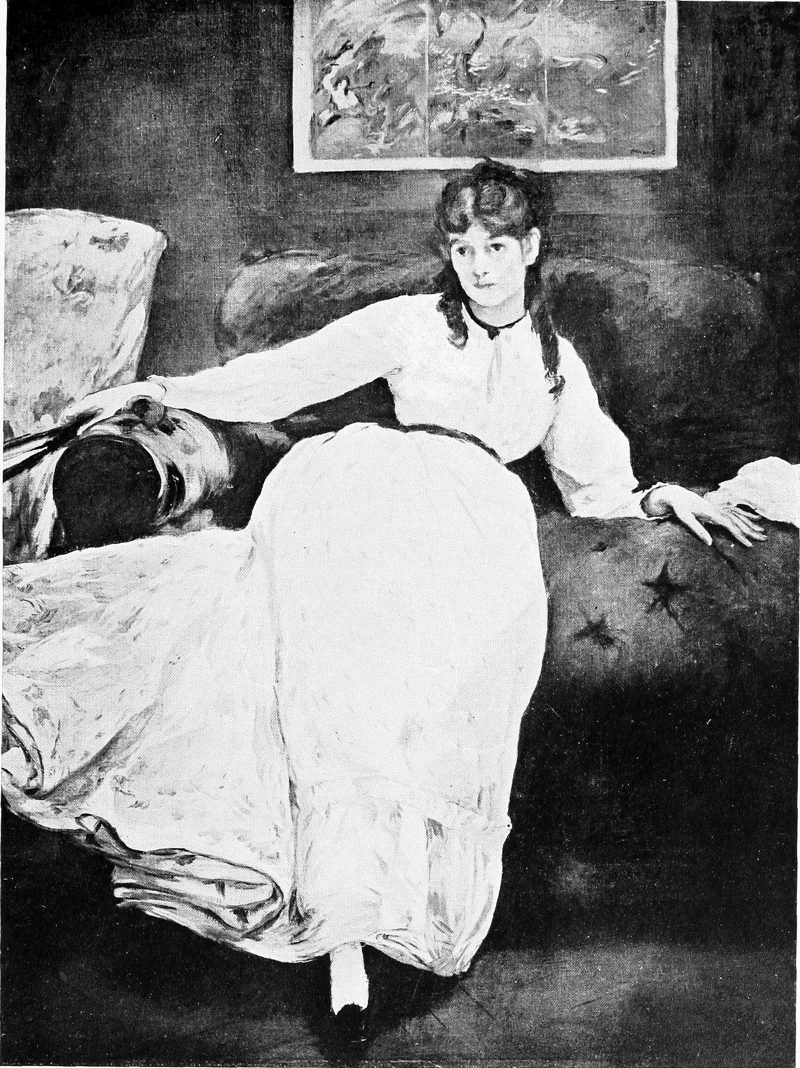
PORTRAIT OF BERTHE MORISOT · EDOUARD MANET
In these and other canvases there was not a shadow, the surface being from end to end clear and highly coloured. Where a Classicalist would have rendered a shadow in the usual burnt umber, Manet made his tones a little less clear, but always coloured and always in value. His method of working was to discard all blacks and preparations of blacks. This was directly antagonistic to the teaching of Couture, who painted on a black canvas. Manet drew straight away on a white canvas with the end of his brush. Then, after having endeavoured to render with a single tone all the pale parts, he carried the lights right into the shadows, of which he studied the slightest nuance. The result was novel to the vision, and strange to the public. The Déjeuner sur l’Herbe was a masterly rendering of 23white flesh against black clothes, which was not appreciated because it was so foreign to the eye.
is an excellent motto for painters who wish to achieve popular renown, but it was never the motto of Manet and the Impressionists.
To a certain extent the Salon des Refusés was successful. The jury of the old Salon had received a fright, and in 1865 they opened their doors very widely. Making a virtue of necessity, they reversed their policy and welcomed the whole artistic world, in order to obviate the necessity of a second Salon des Refusés.
Olympia was far in advance of anything the artist had yet attempted. In composition it recalls Velazquez, Goya, and Titian. A girl, anæmic and decidedly unprepossessing, quite nude, is stretched upon a couch covered with an Indian shawl of yellowish tint. Behind is a negress, with a bouquet of flowers. At the foot of the bed a black cat strikes a sharp note of colour against the white linen.
Gautier and Barbey D’Aurevilly—both men of exotic genius—received the painting with great favour. They found themselves alone in their opinions. Again the subject displeased the crowd, whilst the extraordinary technique exasperated the art world. Even Courbet, reformer as he was, repudiated it. “It is flat and lacks modelling. It looks like the queen of spades coming out of a bath.” Manet retorted: “He bores us with his modelling. Courbet’s idea of rotundity is a billiard-ball.” The general verdict, however, was one in which ridicule and mockery were equally mixed. A religious picture, Christ reviled by the Soldiers, received no greater encouragement, and in the next Salon Manet was rejected without mercy. Le Fifre de la Garde and The Tragic Actor were both refused. He had provoked such fierce animosity that he was even excluded from the representative exhibition of French art included in the Universal Exhibition of 1867.
Luckily, no longer dependent for money on his art, Manet was able to exhibit under more favourable circumstances. Like Rodin a few years ago, Manet opened a large gallery in the Avenue de l’Alma, which he shared with Courbet. Here he collected fifty works, including the Boy with the Sword, several Spanish subjects, seascapes, portraits, studies of still life, aquafortes, even copies. A catalogue was issued containing a short introduction. “The artist does not say to you to-day, Come and see flawless works, but, Come and see 24sincere works.” Another sentence shares with a title of Claude Monet’s the origin of the generic phrase, “Impressionism.” “It is the effect of sincerity to give to a painter’s works a character that makes them resemble a protest, whereas the painter has only thought of rendering his impression.” Manet never considered himself as a man in revolt.
The artist had now a considerable following, and was supported by several vigorous pens in the press, notably that wielded by Emile Zola, who had been introduced to Manet by an old school friend become artist, Cézanne. Zola’s campaign in 1866, following upon the rejection by the Salon of the Fifre de la Garde, saw some hard fights. Zola saluted Manet as the greatest artist of the age, and incidentally overturned a few pedestals in the Academy. Animosity directed against the artist was transferred to the journalist, and Zola was soon ejected from his position under M. de Villemessant as art critic to the Figaro (then famous as l’Événement). Artists of the old school used to buy copies of this journal containing the offending articles, seek out Zola or Manet on the boulevards, and then destroy the paper under their eyes with every manifestation of scorn.
About this time the gatherings in the Café Guerbois, in the Rue Guyot, behind the Parc Monceau, were held twice a week regularly, and the School of Batignolles became an established fact. The group was mixed, and held together more through comradeship than through identical aims. It included Whistler, Legros, Fantin-Latour, Monet, Degas (a young man fresh from the Ecole des Beaux Arts), Duranty, Zola, Vignaux, sometimes Proust, Henner, and Alfred Stevens. To these names should be added Pissarro, Sisley, Renoir, Bazille, and Cézanne. Monet had been attracted by Manet since the little exhibition at Monsieur Martinet’s in 1863, although they did not meet until 1866, the year that Camille Pissarro joined the camp. Fantin-Latour was an old chum, the friendship commencing in 1857, and he commemorated these gatherings in a picture of the members of the group, which attracted much attention in the Salon of 1870.
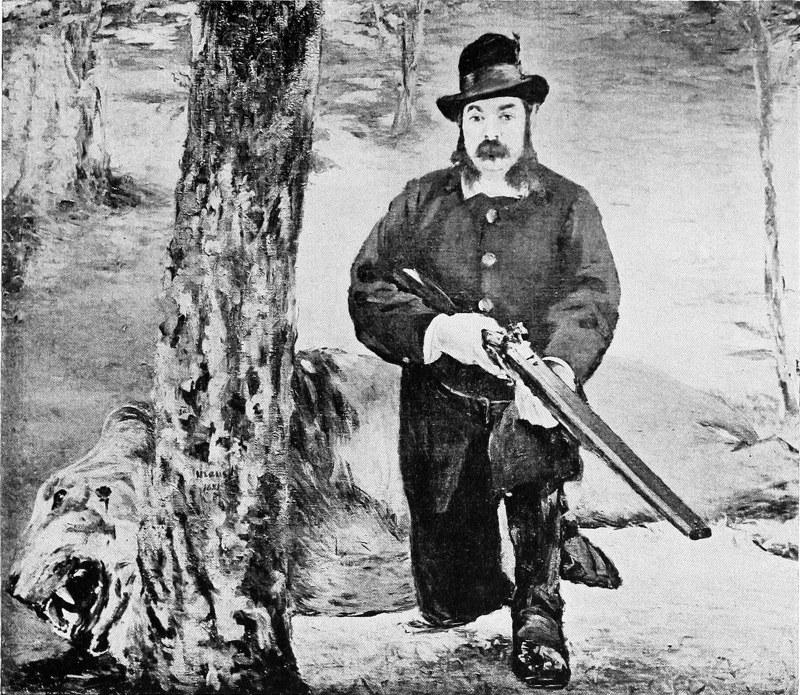
PORTRAIT OF M. P——, THE LION-HUNTER · EDOUARD MANET
The home life of Edouard Manet was strangely different from what one would expect of such an artist, so notorious in the Paris of the Empire that when he entered a café its frequenters turned to stare at the incomer. Manet lived with his wife and his mother in the Rue St. Pétersbourg. The old lady, faithful to her remembrance of the age of Charles X. and the Citizen King, lived amidst souvenirs of the past. Modernity was entirely absent from the little household, and those who anticipated evidences of the spirit of 25revolution which characterised Manet in the world of the boulevards here discovered the atmosphere, even the decoration and furniture, of the Louis-Philippe period. Romance had also entered into the hitherto prosaic Manet family. Mlle. Berthe Morisot, a clever young artist from Bourges, had married Manet’s brother Eugène, and became an ardent follower of her brother-in-law’s artistic doctrines, whom she aided frequently.
A famous work of this period is The Execution of the Emperor Maximilian, the subject representing a file of dark-hued Mexicans shooting the unfortunate monarch. It is a vast canvas, slightly inconsistent with many of the artist’s theories. Not lacking in actuality (it was commenced within a few months of the event), it was of historical genre and painted in a studio from models, the face of the Emperor being copied from a photograph. Rarely, if ever before, seen in London, this magnificent painting was received enthusiastically when exhibited at the first collection made by the International Society in 1898.
In France the authorities forbade the public exhibition of the Execution, the tragedy having had too intimate a relation with French politics; but at the Salon of 1869 Manet was represented by The Balcony, which provoked considerable derision from critics and public.
The famous duel with Duranty took place early in the following year. Duranty, an old friend and journalistic supporter of the movement, of great literary reputation in the ’sixties and ’seventies, but quite forgotten now, suddenly published a newspaper article in which the artist was violently attacked. There was no palpable reason for such a strange outbreak, and at the next gathering at the Café Guerbois, Manet requested explanations. In his anger the artist struck the writer across the face. Manet had for seconds Zola and Vigniaux, and his adversary was slightly wounded in the breast. Within a few years Manet stretched out his hand in friendship, and the quarrel was made up and forgotten by both parties.
The tremendous upheaval of the year 1870 had its effect upon Manet’s art, as it had upon the whole national and intellectual life of France. It marks the end of his first period, for after the war Manet paid more attention to the question of lighting, and gathered closer to the little group of “Luminarists” of which Claude Monet was the most significant figure. Early in 1870 the artist, when painting near Paris, in the park of his friend De Nittis, for the first time woke up to the prime importance of working “en plein air.” The war intervened, and Manet served with the colours. After the 26campaign he returned to his easel, but no longer an exclusive follower of the Spanish School and the Romanticists of the type of Courbet.
At the call of their country, artists and authors alike followed the flag. One can still remember how short-sighted Alphonse Daudet kept sentry-go during the first awful winter, and how, almost at the end of the siege of Paris, the brilliant Henri Regnault was shot down in a sortie. Bastien-Lepage was in the field, and one of the group of the Café Guerbois, Bazille, was killed in action. Manet enlisted in the Garde Nationale, and, for some reason which is not obvious, was at once promoted to the Staff. Unfortunately, Meissonier was nominated Colonel of the same regiment, which shows that the État-Major was quite ignorant of the state of contemporary art. Meissonier, a man of strong opinions, the recognised head of his profession, member of the Institute, was covered with official honour. Manet, with equally forcible convictions, the hero of the Salon des Refusés, was pariah to the Academy. It was not likely that two such men could get on well together.
Some years afterwards Manet displayed his feelings. He was gazing in a public gallery at a Charge of Cuirassiers, recently painted by Meissonier. A crowd gathered round. His criticism was short. “It’s good, really good. Everything is in steel except the cuirasses.” The mot travelled round the town, and duly reached the ears of the venerable artist at Passy. Manet saw active service. He was under fire at the Battle of Champigny, and also took part in the suppression of the Commune. A vivid little sketch by Manet shows a Parisian street, after some sharp fighting with the insurgents. It may be found reproduced in Duret’s monograph. Broken down in health, Manet joined his mother and sister at their retreat in the Pyrenees, and at Oléron painted the Battle of the “Kearsage” and “Alabama,” a wonderful piece of sea-painting, although executed far from the actual scene of the engagement.
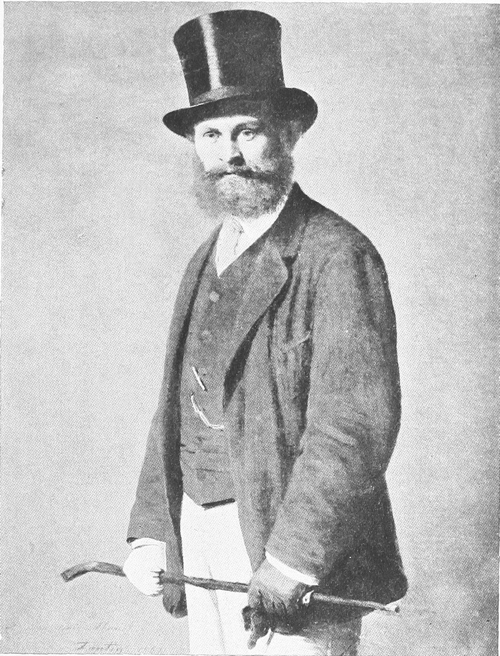
EDOUARD MANET
Manet had exhausted the paternal inheritance and was living on the fruits of his labour. The Impressionist School, as we now know it, was at the height of its activity, but by no means at the summit of its success. It assumed as its title the designation which had been applied to it as a nickname. The origin of this title is obscure. As already mentioned, Manet used the term in his introduction to the catalogue of 1867. Claude Monet named one of his pictures, a sunset, exhibited in the Salon des Refusés, “Impressions.” Ruskin though had used the same term years before in describing a canvas by Turner. Many of the members of the 27group were in the most abject poverty until the celebrated dealer, M. Durand-Ruel, came to their assistance. Manet had better sales than the rest of his brethren, for several collectors began to buy from his easel, viz. Gérard, Faure (of the Opera), Hecht, Ephrussi, Bernstein, May, and De Bellis. It is characteristic of the man that in his own studio he exhibited the works of his friends in order that the wealthy buyers he was beginning to attract should also invest in the productions of the less fortunate Impressionists.
In 1873 Manet contributed to the Salon a portrait of the engraver Belot seated in the Café Guerbois. Known as Le Bon Bock, it was his most popular success both with public and critics. Over eighty sittings were given before the canvas was completed. Manet had departed far from the technique of the Dutch portrait-painters, but Le Bon Bock strongly suggests the manner of Hals, although ranking on its own merits as an independent triumph. To the year of Le Bon Bock succeeded a long period of public indifference and artistic warfare. The Impressionists held their first collective exhibition, which was bitterly disappointing in its results. The public had changed but little. The Opera Ball and The Lady with Fans (about 1873), the Railway, painted wholly in the open air, and Polichinelle (exhibited at the Salon of 1874), The Artist and L’Argenteuil of 1875, all were received with disfavour.
It is extremely curious to note how canvases which appear to-day perfectly normal in their methods and aims positively outraged the feelings of critics thirty years ago. L’Artiste, a magnificent portrait of the engraver Desboutins, was refused by the Salon together with Le Linge. L’Argenteuil, a simple representation of two life-sized figures by the borders of the Seine, would be received with acclamation instead of disdain. Manet and his group were undoubtedly educating the public, but progress was very slow. There was an outburst of opinion in favour of the artist when the Salon refused L’Artiste and Le Linge. One sentence of criticism summed up the general feeling of those who were not entirely prejudiced against the new spirit. “The jury is at liberty to say that it does not like Manet. But it is not at liberty to cry ‘Down with Manet! To the doors with Manet!’”
Reaction on the part of the jury followed, exactly as it had followed in previous years. After the success of the Salon des Refusés Manet was accepted. Then, being rejected, he opened the gallery of the Avenue d’Alma, and was hung by the jury at the ensuing Salon. Rejected in 1876, the outcry in the press surprised the jury, who accepted his works in 1877. These extraordinary ups and downs culminated in 1878, when the jury of the Exposition 28Universelle, held in that year, definitely refused to hang any of his canvases. In the opinion of this jury the painter of Le Bon Bock was not a representative French artist. Ten years had changed the official art world but little, for the same thing had happened in 1867. This was almost the last insult Manet had to endure. In 1881 he received a second medal at the Salon. The discussion in the Committee had been acrimonious, but seventeen members of the jury were found to support the award. Amongst the names of the majority are those of Carolus-Duran, Cazin, Henner, Lalanne, de Neuville, and Roll.
One cannot deny that Manet’s work greatly varied. The portrait of M. Faure, in the character of Hamlet, was to a certain extent conventional studio-painting, and could offend nobody. The subject would not provoke the most susceptible. M. Faure was celebrated on the stage of the Grand Opera, possessed considerable wealth, and was one of Manet’s most devoted friends. Nana, sent to the Salon together with the portrait of M. Faure, was rejected. The technique was brilliant, but the subject, although harmless enough, suggested Zola’s heroine. Zola’s book was not published until 1879, but the name designated a class apart.
In 1880 Manet exhibited a wonderful portrait of M. Antonin Proust, and in the December of the following year his old friend, now Directeur des Beaux-Arts, was able to give to his life-long companion the Cross of the Legion of Honour. Had Manet no friends at Court, he would certainly not have received this coveted decoration. President Grévy objected when he saw the painter’s name, and would have struck out Manet from the list had not Gambetta exerted some little pressure.
But the struggle was nearly ended. Manet was dying. “This war to the knife has done me much harm,” he is reported to have told Antonin Proust. “I have suffered from it greatly, but it has whipped me up.... I would not wish that any artist should be praised and covered with adulation at the outset, for that means the annihilation of his personality.”
On New Year’s Day, 1882, he received the Cross, and at the Salon exhibited Un Bar aux Folies-Bergères, a barmaid enshrined amidst her glasses at a Paris music-hall, and a portrait, Jeanne. Since 1879 paralysis had been slowly sapping his powers. Edouard Manet died near Paris on April 30, 1883, at the early age of fifty-one. Disappointment, injured pride, lack of appreciation, continued and strong hostility, each had had its effect upon a physique always sensitive and never too strong. The artist had died for his art.
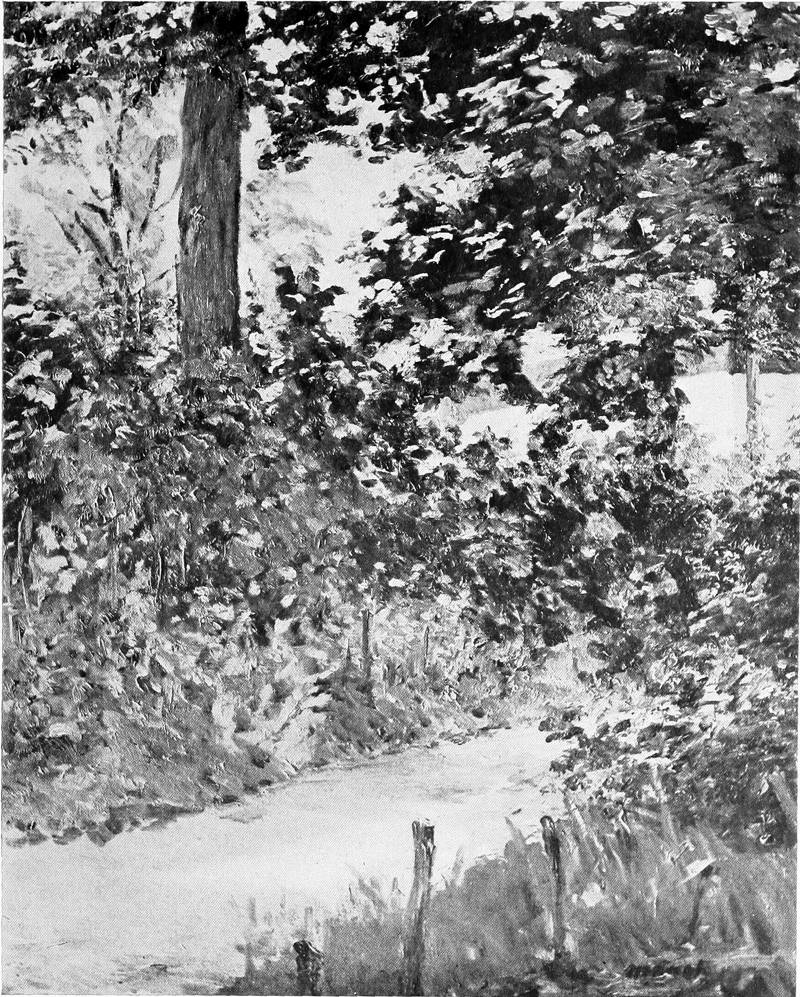
A GARDEN IN RUEIL · EDOUARD MANET
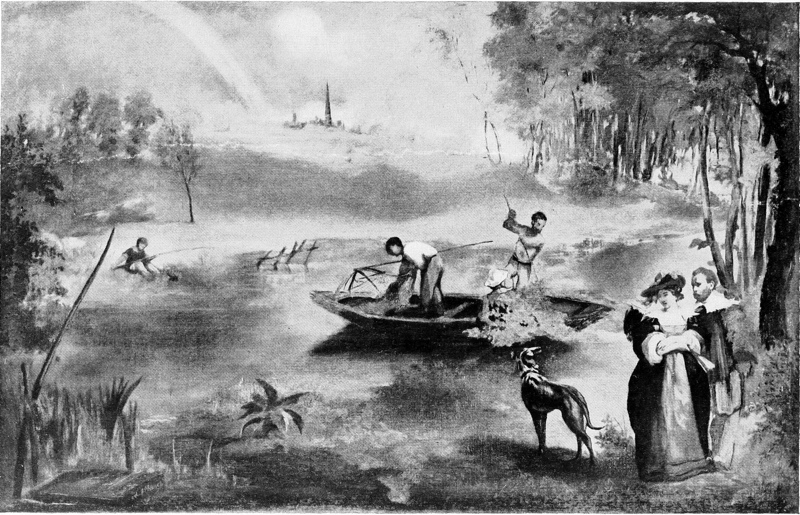
FISHING · EDOUARD MANET
29The secret of Manet’s power is sincerity and individuality; his main effort was a rendering of fact; his deepest interest the truthful juxtaposition of values, the broad and simple treatment of planes, combined with a constant search for the character of the person or object portrayed.
The influences which guided Manet during the earlier portion of his career have been noticed at length. He travelled extensively, and his works bear many souvenirs of foreign masters. But sufficient stress is not always laid upon the influences at work around Manet in Paris, namely, the influences of Delacroix, Corot, and the men of 1830, who carried but one stage farther the methods and tradition of the English masters, Constable, Bonington, Girtin and Turner.
Apart from sources of inspiration Manet was personally gifted. He possessed (as M. Duret so well points out) the faculty of sight, a gift from Nature which cannot be acquired by will or work. Technique he had obtained after six years’ hard study in the most severe atelier in Paris. But technique is a subsidiary equipment, for a complete command over one’s materials does not always imply the possession of genius.
“The fools!” said Manet with bitterness to Proust. “They were for ever telling me my work was unequal. That was the highest praise they could bestow. Yet it was always my ambition to rise—not to remain on a certain level, not to remake one day what I had made the day before, but to be inspired again and again by a new aspect of things, to strike frequently a fresh note.”
“Ah! I’m before my time. A hundred years hence people will be happier, for their sight will be clearer than ours to-day.”
Ambition to rise, never to remain on the same level! That is the whole doctrine of art, and the supreme epitaph for Edouard Manet, pioneer and master.
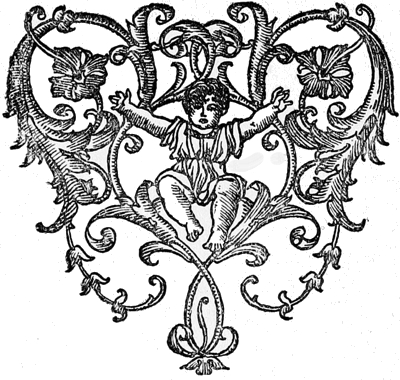
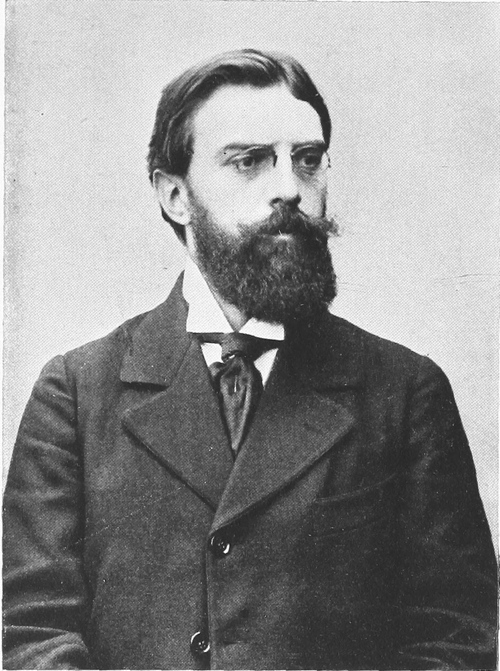
GEORGES D’ESPAGNAT
“L’ADMIRATION DE LA FOULE EST TOUJOURS EN RAISON INDIRECTE DU GÉNIE INDIVIDUEL. VOUS ÊTES D’AUTANT PLUS ADMIRÉ ET COMPRIS, QUE VOUS ÊTES PLUS ORDINAIRE”
ZOLA

THE outbreak of the Franco-German War in 1870 scattered far and wide the little group that congregated at the Café Guerbois, and had a curious effect upon the evolution of their methods of painting. Several of the leading members of the circle crossed to England, and the studies they pursued in London formed the basis for the unconventional departures which have produced the masterpieces of Modern Impressionism. Practically all the later developments of their art date from the above-named year, and if a place of genesis be sought for it will be found in the London National Gallery.
As related in a previous chapter, Edouard Manet, the acknowledged head at the Café Guerbois gatherings, became a captain in the Garde Nationale, with Meissonier as his colonel. Boudin and Jongkind fled to Belgium, and became labourers. Monet, Pissarro, Bonvin, Daubigny, and some friends, braved the horrors of “La Manche” and settled in London. They arrived almost penniless, thoroughly disheartened by the terrible events which were threatening their motherland with disaster. The journey, momentous to the unhappy passengers, was the opening of a new epoch in art.
The following letter from Pissarro, to the author, written in November 1902, gives an interesting account of their doings in London. He says: “In 1870 I found myself in London with Monet, and we met Daubigny and Bonvin. Monet and I were very enthusiastic over the London landscapes. Monet worked in the parks, whilst I, living at Lower Norwood, at that time a charming suburb, studied the effects of fog, snow, and springtime. We worked from Nature, and later on Monet painted in London some superb studies of mist. We also visited the museums. The water-colours and paintings of Turner and of Constable, the canvases of Old Crome, have certainly had influence upon us. We admired Gainsborough, Lawrence, Reynolds, &c., but we were struck chiefly by the landscape-painters, 32who shared more in our aim with regard to “plein air,” light, and fugitive effects. Watts, Rossetti, strongly interested us amongst the modern men. About this time we had the idea of sending our studies to the exhibition of the Royal Academy. Naturally we were rejected.”
“Naturally we were rejected!” These poor exiles were offering to the conservative Academy canvases painted in a method that Constable could not get accepted forty years before.
Their admiration of Turner and Constable was a repetition of the experiences of another great Frenchman nearly fifty years earlier. In his published journal, Delacroix has written: “Constable and Turner are true reformers.” At the Salon of 1824 the pictures of Constable so profoundly impressed him that he completely repainted his large canvas, the Massacre of Scio, then hanging in the same exhibition. The next year he visited London in order that he might more closely study Constable’s work. He returned to Paris marvelling at the hitherto unsuspected splendour of Turner, Wilkie, Lawrence, and Constable. Immediately he began to profit by their examples. Delacroix chronicles that he noticed that Constable, instead of painting in the usual flat tones, composed his picture of innumerable touches of different colours juxtaposed, and, at a certain distance, recomposing in a more powerful and more atmospheric natural effect. He adds that he considers this new method far superior to the old-fashioned one.
The group of 1870 made this discovery afresh. It is pleasant to imagine that these artistic explorations somewhat dulled the misery of their exile. They worked and copied in the public and private galleries, they painted by the riverside, and in the streets and parks. With enthusiasm they absorbed the technique of Turner and Constable, perhaps of Watts, and the result is to be seen in Claude Monet’s Haystacks, in Pissarro’s street scenes, in Sisley’s landscapes, in the luminous work of Guillaumin and d’Espagnat, in the canvases of Vuillard, Maufra, and many followers. Their style was revolutionised, their ideals changed. The dull greys and the russet browns which reigned supreme before 1870 were banished for ever.
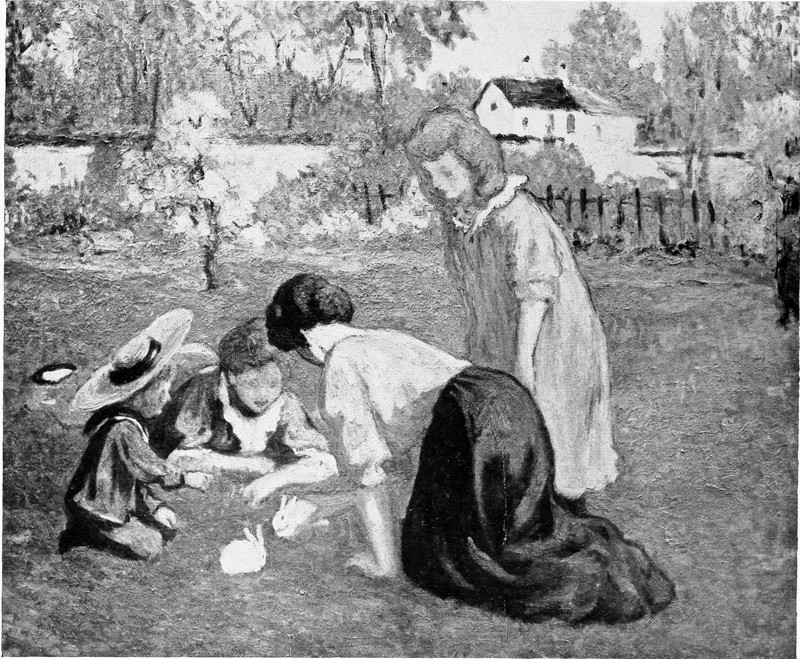
THE WHITE RABBITS · GEORGES D’ESPAGNAT
They returned to France the preachers of a new crusade. The “Café de la Nouvelle Athénée” became the centre of the group. Reunited under Manet, whose style commenced to show signs of much influence from Claude Monet, the reformers gathered many recruits, and gained more enemies. They were not without friends on the press: Emile Zola, who had written so eloquently in “Mes Haines,” Théodore Duret, friend and literary executor of 33Manet, Gustave Geffroy of “La Vie Artistique,” in Monet’s opinion the most slashing of the lot, Arsène Alexandre of “Le Figaro,” Gustave Cahen, Roger Marx, and many others.
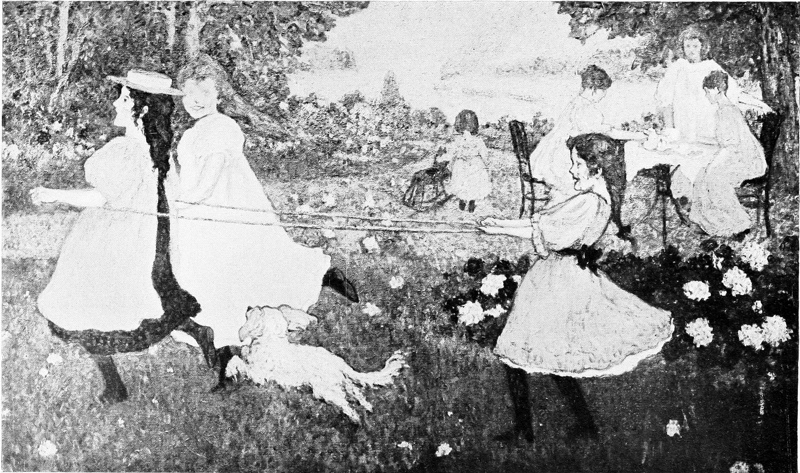
A SUMMER AFTERNOON · GEORGES D’ESPAGNAT
But the financial position of the whole group was exceedingly precarious. They could not sell their pictures. It was admitted that the canvases of such men as Monet and Pissarro were the works of men of genius, but the buying public (and they are numerous in France) did not understand the new movement, and so failed to support it adequately. As a whole, it may be said that the art public were in open hostility to Impressionism. With a few exceptions, the critics of the established art journals condemned the movement. Even comic singers ridiculed the painters in the music-halls of Paris. The Salon was closed against them, and the dealers refused to look at their canvases.
Meanwhile the artists starved. These were the evil days of evictions, of visits from the sheriff, of the forced sale of household furniture to pay insignificant debts. It is a sordid story of a struggle to obtain the barest necessities of existence. These wretched years proved a bitter chastening of the spirit to proud and refined natures. Tragedy and comedy were intermixed. Glimpses of hope and comfort appeared from time to time as some fresh buyer appeared on the scene. But these welcome callers were not frequent, and the rifts of sunshine through the grey clouds were, as a rule, transitory.
The artists did not over-value their works. They were able to live in tranquillity if their pictures fetched prices ranging from £2 to £4. To sell a canvas at £8 was an event, and £20 was a figure absolutely unheard of. A letter from Manet, a comparatively rich man with an independent income, to Théodore Duret, the critic, gives a vivid insight into the situation in 1875. Manet had recently visited Claude Monet at Argenteuil. “Dear Duret,” he writes, “I went to see Monet yesterday. I found him altogether ‘hard up.’ He asked me if I knew of a purchaser for ten or twenty of his pictures at £4 each. Shall we take it on? I thought of a dealer, or of an amateur, but there I foresee the possibility of refusals. It is unfortunate that it is only connoisseurs, like ourselves, who can at the same time—in spite of all the repugnance we may feel over it—make an excellent bargain and help a man of such talent. Answer as quickly as possible or make an appointment with me. Amitiés, Edouard Manet.”
This is good proof, if proof were needed, of the straits to which one of the leaders of the group was reduced. It is also odd 34to note that Manet was afraid of a refusal, from both dealers and collectors, to the offer of such a bargain as a score of works by Claude Monet at £4 apiece. The letter also proves that those professional dealers who had hitherto supported the Impressionists were at the end of their resources, notably M. Durand-Ruel.
This celebrated dealer and collector had brought himself to the verge of bankruptcy through a too generous investment in Impressionist work. He was gradually ostracised by brother dealers, buyers, and art critics. He was regarded in much the same light as the artists themselves, considered to have lost his mental balance and also his acumen as a man of business. Certainly he speculated upon a large scale. In January 1872, having previously bought two studies, M. Durand-Ruel called upon Manet at his studio and bought on the spot twenty-eight canvases for the sum of 38,600 francs (£1544). The whole Impressionist camp went wild with joy under the mistaken idea that their millennium had arrived. They had many years to wait. Both the pictures and the capital were locked up for a considerable time. The public had yet to be educated, and the few amateurs who bought Impressionist work could select examples in abundance from the artists’ easels.
It is to the credit of the group that they followed their ideals and refused many temptations. Several of them, Monet in particular, were admirable portraitists, and could easily have gained a very respectable living from that branch of art. A writer in one of the French art reviews asserts that Claude Monet’s Femme à la Robe Verte was the finest painting in the Salon of 1866. Only men who have passed through such experiences can appreciate at its true value the heroic courage, faith, and self-confidence required during such a trial.
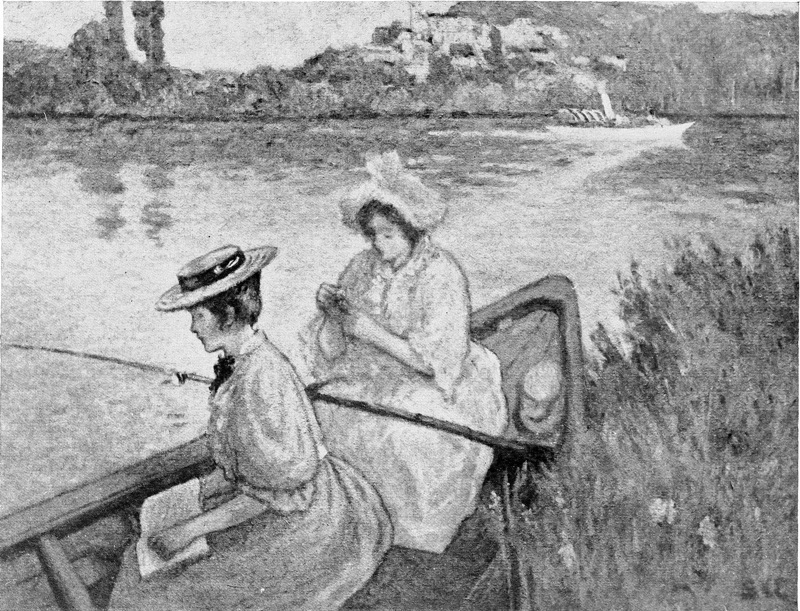
FAIR ANGLERS · GEORGES D’ESPAGNAT
The ordeal was long and severe. It included public disdain and private poverty. The movement did not, however, remain stationary. In 1874 a small exhibition was organised, and held, from April 15 to May 15, at the galleries of M. Nadar, 35 Boulevard des Capucines. This little salon, entitled “L’Exposition des Impressionistes,” has become historic. The list of exhibitors included the following: Astruc, Attendu, Béliard, Boudin, Bracquemond, Brandon, Bureau, Cals, Cézanne, Gustave Colin, Debras, Degas, Guillaumin, Latouche, Lepic, Lépine, Levert, Meyer, de Molins, Monet, Berthe Morisot, Mulot-Durivage, de Nittis, Auguste Ottin, Léon Ottin, Pissarro, Renoir, Rouart, Robert, Sisley. From every point of view, except that of art, the exhibition was a failure. The press attacked it with exceptional virulence, the public kept 35away. The artists were lampooned in idiotic cartoons, and branded as traitors who were disloyal to the artistic traditions of their country. The public sales at the Hôtel Drouot were disastrous. In March 1875, excellent examples of Claude Monet were sold at prices varying between £6 and £13. Pictures by Mlle. Berthe Morisot fetched from £3 to £19, and by Sisley from £2 to £12. Renoir was the most unfortunate. Out of twenty paintings, ten did not reach £4 each. Not one sold for more than £12.
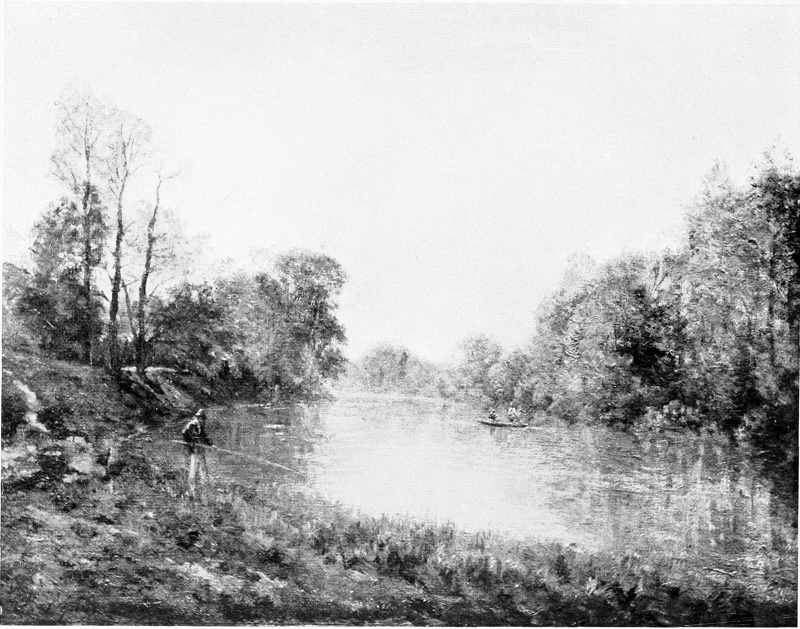
FISHING NEAR PARIS · LEPINE
The particulars of the following exhibitions and sales are fully detailed by M. Gustave Geffroy in his “Vie Artistique.” The second exhibition was held at the house of M. Durand-Ruel in April 1876. The participators were Béliard, Legros, Pissarro, Bureau, Lepic, Renoir, Caillebotte, Levert, Rouart, Cals, J.-B. Millet, Sisley, Degas, Claude Monet, Tillot, Desboutin, Berthe Morisot, Jacques François, and the younger Ottin.
In 1877 a sale was held, but prices showed little improvement. An exhibition had been held a month previously, the exhibitors being Caillebotte, Cals, Cézanne, Cordey, Degas, Guillaumin, François, Lamy, Levert, Maureau, Monet, Berthe Morisot, Piette, Pissarro, Renoir, Rouart, Sisley, and Tillot.
These lists are exceedingly interesting, as they show year by year the composition of the group. In succeeding years fresh names appeared. In 1879, at the Spring Exhibition in the Avenue de l’Opéra, the catalogue included Bracquemond, Marie Bracquemond, Caillebotte, Cals, Mary Cassatt, Degas, Forain, Lebourg, Monet, Pissarro, Rouart, Somm, Tillot, and Zandomeneghi. In 1880, at the gallery in the Rue des Pyramides, the same names appeared, together with J. F. Raffaëlli, J. M. Raffaëlli, Vidal, and Vignon. Claude Monet does not appear to have sent any works, probably because of his “one-man show” at “La Vie Moderne” gallery. In April 1881, the annual collection began to decline in numbers, canvases being sent by Mary Cassatt, Berthe Morisot, Degas, Forain, Gauguin, Guillaumin, Pissarro, Raffaëlli, Rouart, Tillot, Vidal, Vignon, and Zandomeneghi. In the following year (at the Rue Saint-Honoré) the number was still less, Caillebotte, Gauguin, Guillaumin, Monet, Berthe Morisot, Pissarro, Renoir, Sisley, and Vignon. Practically the last collective exhibition was held in 1886, the catalogue consisting of works by Degas, Berthe Morisot, Gauguin, Guillaumin, Zandomeneghi, Forain, Mary Cassatt, Odilon Redon, Camille Pissarro, Seurat, Signac, and Lucien Pissarro.
M. Geffroy refers to these exhibitions as battle-fields. Campaigns 36cannot last for ever, and victory had at last crowned the Impressionists. To-day these artists are honoured and decorated, their works hang in public galleries over the whole world. It may be said that we are all Impressionists now. Certainly of the students it is true, for ninety per cent. of those who take up landscape painting follow with admiration the paths of the Impressionists. A glance through the annual salons, either in Europe or America, fully proves the assertion. Before many years have elapsed, even in England, one will find this the case. The difficulty of Hanging Committees will be, not to hide away Impressionist work to the least damage of its surroundings, but to hang the anecdotal, moral, and all canvases of like genre, in such obscure corners as will give the least offence to their moribund and conservative creators.
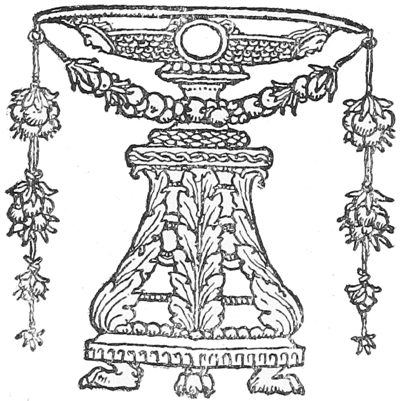
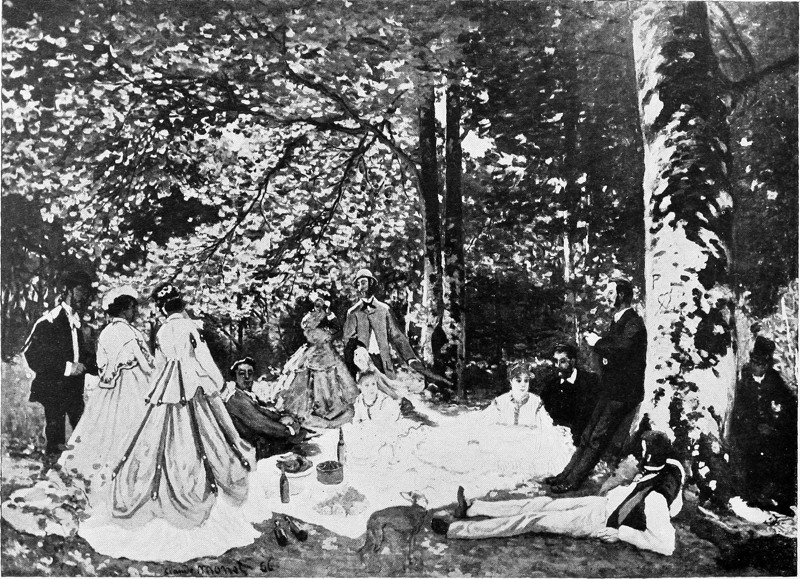
THE PICNIC · CLAUDE MONET
“SÛREMENT CET HOMME A VÉCU, ET LE DÉMON DE L’ART HABITE EN LUI”
GUSTAVE GEFFROY

CLAUDE MONET is one of the few fortunate painters whose fame is not posthumous, and whose material recompense runs parallel with the merit of their production. He, above all others, has lifted the School of Impressionism in France from the derision and disrepute which greeted its inception some thirty years ago, and to him is due the honour of making it one of the most prominent of latter-day art movements.
The present generation witnesses the triumph of a remarkable revolution, and the success of a group of painters, of which Monet was head, after years of acrimonious struggle against a world of prejudice and disdain. Claiming a right to exercise their art as they thought fit, aided by a mere handful of far-sighted critics and patrons, for thirty years they patiently endured public obloquy. Now the Luxembourg Gallery enlarges its space to receive their works, and before long they will be represented side by side with the masters of the Louvre. Appreciation is the order of the day, and millionaires compete for their canvases.
The life-history of Claude Monet is inseparably connected with the story of Impressionism in France. As a leader of the little group any record of the subject must largely consider his part in the result. It is remarkable that a man of such talent should remain comparatively unknown in England, considering that another portion of the Anglo-Saxon world has always generously encouraged him. For the past twenty years a large proportion of his works has gone to the United States. The English nation will have to pay dearly in the future for its present neglect of modern French art. At the present moment there is not a single specimen of the work of Monet on exhibition in any English public art gallery.
Claude Monet was born in Paris on November 14, 1840. Son of a wealthy merchant of Havre, his inclinations towards art were soon shown, and these tendencies, as usual, discouraged at home. 38No member of the family had any artistic gifts, and, as in the case of Edouard Manet, the youth was sent on a foreign tour. His school work was spasmodic and irregular, and he devoted much of his time at Havre to caricature and the company of Boudin the painter. When remonstrated with his reply was the historic, “I would like to paint as a bird sings.”
After two years of military service with the Chasseurs d’Afrique in Algeria, Monet caught fever, and returned home. He then entered the Atélier Gleyre, and remained in Paris. Of personal history there is little to relate. He is a man of high purpose, greatly talented, excessively active and self-reliant, who has not faltered once from the path of his ideals. His adventures have been those usual to the profession of a landscape-painter. He has suffered from fever and rheumatism, the results of working near mosquito-haunted marshes, in drenching rain, or in damp grass. The occupation is peaceful enough, the diseases named are of everyday occurrence, yet they exert a powerful influence upon the life of a man for ever engaged with brain and eye, with nerves strung to the most intense pitch.
His early struggles were the ordinary struggles of nine-tenths of those votaries who worship at the shrines of Art. Claude Monet has drunk deeply of the bitterness of life. He has endured privations and disappointments which have brought him almost to the depths of despair. He has survived only through his indomitable pluck.
“One must have the strength for such a fight,” says Monet, with the assurance born of experience, when recounting the history of those troublous days. He is fortunately most generously endowed with the attributes peculiar to the true artistic temperament—those exquisite dreams and reveries which are at once a solace, a pleasure, and a sustaining impetus. Truly was Baudelaire justified in writing: “Nations have great men in spite of themselves, and so have families. They do their best not to have any, so that the great man, in order to exist, must needs possess a power of attack greater than the force of resistance developed by millions of individuals.”
It has long been granted, even by the bitterest of his opponents, that Monet possesses a few at least of the attributes of genius—the capacity for turning out large quantities of work, an almost unparalleled fertility of invention, imagination, and originality, and above all that priceless gift to the artist—the supreme power of creation. Moreover, he is ever keen and restless in search of the new and unexplored, for ever mistrusting the value of his own productions.
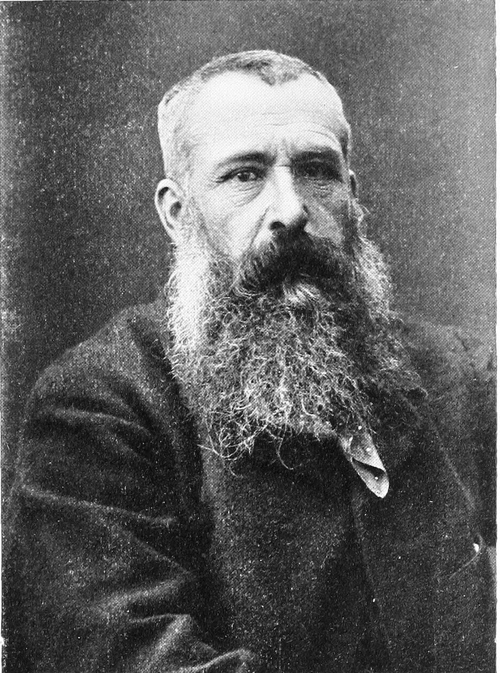
CLAUDE MONET
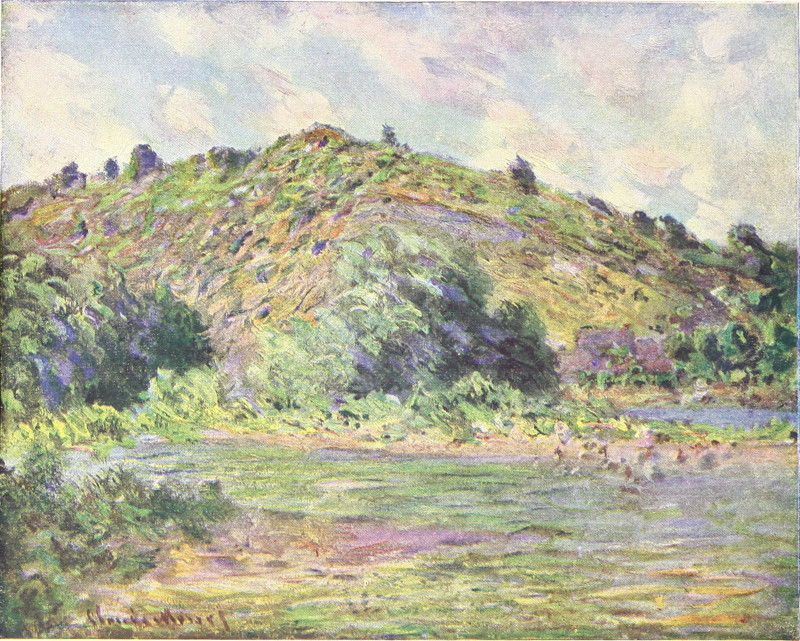
A STUDY · CLAUDE MONET
39Never has he been influenced strongly enough to waver in the pursuit of his ideals, either through the gibes of the critics or the lack of appreciation on the part of the public.
His work is large and simple in character; his colour vigorous to the utmost capacity of the prismatic tints, bearing the impress of a passionate, violent, and highly sensitive artistic individuality.
Monet is a lyrical poet, singing the joy of life and nature. The decadence of modern France in literary circles finds no reflection on his canvas. Strongly opposed by personal temperament to the ugly and morbid, he allows his brush to touch no subject at all allied to such themes. In every picture he paints we seem to hear Pippa singing:
A happy serenity is his great charm, and it has been arrived at by temperament, not by training.
At the beginning of the Impressionist movement the nightly meetings at the Café Guerbois became the centre of a small band of innovators and iconoclasts, attracted by the sympathy of a common aim, the necessity of mutual encouragement, and the prescience of the evolution of a new idea.
The first public exhibition of the works of these painters was held in the spring of 1874 at Nadar’s, in the Boulevard des Capucines. It created an uproar in the art world, which culminated in several scenes of personal violence between over-excited critics. Other exhibitions, chiefly devoted to the works of Claude Monet, may be roughly summarised as follows: one in 1876; at the galleries of M. Durand-Ruel in 1877; in 1880 at the offices of “La Vie Moderne,” Boulevard des Italiens; in 1889 in conjunction with Rodin at the gallery of M. Georges Petit.
Monet exhibited at the Salon for the first time in 1865. The two marine pieces drew from Edouard Manet the remark, “Who is this Monet, who looks as if he had taken my name, and happens thus to profit by the noise I make?” He exhibited for the last time in 1880. In 1882 he forwarded Glaçons sur la Seine, a remarkably beautiful conception of an illusory effect, the rejection 40of which finally ended all relations between the artist and a too conservative body.
With the exception of a semi-private show at Dowdeswell’s of Bond Street in 1883, Monet made his début in England at the Winter Exhibition of 1888 of the Royal Society of British Artists, then under the presidency of Mr. Whistler. That careful critic, Mr. H. M. Spielman, of the “Magazine of Art,” wrote the following lines in his journal: “He who contemplates these distinctive pieces of arch-impressionism, without prejudice, without ‘arrière pensée,’ must own that for strength and brilliancy of general tone and for decorative effect, they have few, if any, equals.”
Monet has never been seen at his best in England; indeed, the same may be said of all the members of the Impressionist group. Owing to the ready market for their work in France and America, it is rarely that the dealers are able to attract across the Channel any but second-rate canvases. Isolated works have been shown at the Boussod Vallodon galleries, the New English Art Club, the International Society’s Exhibition at Knightsbridge, and a miscellaneous collection on view at the Hanover Gallery, Bond Street, in 1901. The standard of the latter was not high, and the result disappointing to all parties. A representative exhibition remains to be held.
No other country but France can boast of landscape so varied, so picturesque, and so atmospherically suited to the Impressionist. The principal scenes of Monet’s labours have been Havre, Belle-Isle-en-Mer, the Riviera, La Creuse, La Manche, with Giverny and the Seine valley in particular. Short visits have been devoted to England, Norway, and Holland; but the first-named localities have seen the production of the famous series known under the titles of Les Meules, Peupliers au bord de l’Epté, Glaçons sur la Seine, Matins sur la Seine, A Argenteuil, Belle Isle, Bordighera, Antibes, Champs des Tulipes, and Les Cathédrales. There is also a series of paintings of the artist’s Japanese water-garden at Giverny, and yet another series dealing with London under different atmospheric aspects.
Claude Monet is enthusiastically in love with London from the painter’s point of view. From the balconies of the Savoy Hotel the French master has watched the tidal ebb and flow of the great grey river, with its squalid southern banks shrouded day by day in white mist and brown smoke, the warehouses and chimneys coated in a veil of soot, the legacy of ages. The autumnal fogs, which harmonise discordant tones, round off harsh outlines, cloak the ugly and create the beautiful, are to the foreigner London’s greatest charm, although to the inhabitant they are a deadly infliction.
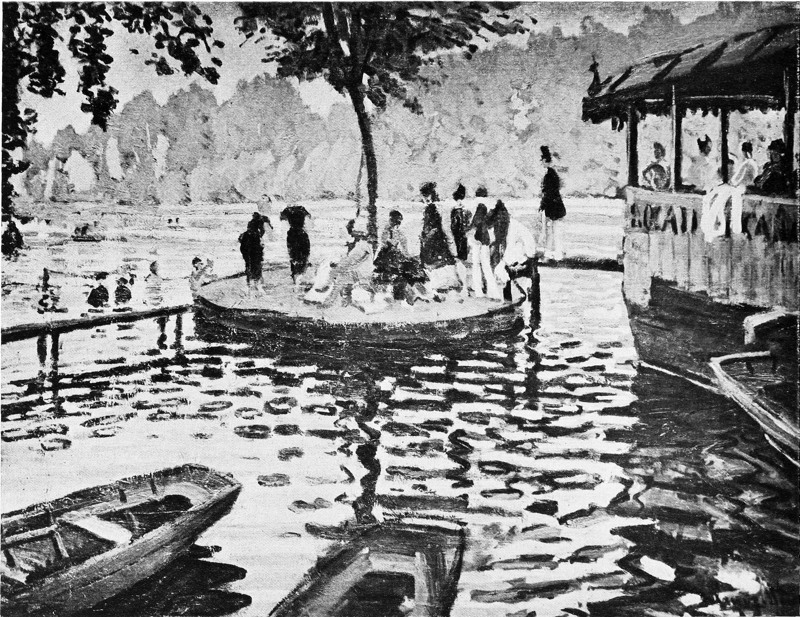
LA GRENOUILLÈRE · CLAUDE MONET
41No writer ever expressed this fascination more eloquently than the “Wizard of the Butterfly Mark,” who wrote: “And when the evening mist clothes the riverside world with poetry, as with a veil, and the poor buildings lose themselves in the dim sky, and the tall chimneys become campanili, and the warehouses are palaces in the night, and the whole city hangs in the heavens and fairyland is before us—then the wayfarer hastens home; the working man and the cultured one, the wise man and the one of pleasure, cease to understand, as they have ceased to see; and Nature, who, for once has sung in tune, sings her exquisite song to the artist alone, her son and her master—her son in that he loves her, her master in that he knows her.”
With these thoughts Claude Monet is in perfect agreement. He is amazed at the apathy and indifference of British artists, blinded no doubt by familiarity, in allowing so fertile a field of labour to remain comparatively unexplored, not only with regard to the river scenes, but to the Metropolis as a whole. Whistler was fascinated, so was Bastien-Lepage, so is Claude Monet; but the Englishman remains unmoved.
A chapter could be written upon the artist possibilities of the city, and the fringe of the subject would have been then but touched. Where, asks Monet, can more soul-inspiring subjects for the brush be found than in the Strand from morning to night, in the movement of Piccadilly, in the evening colour of Leicester Square, the classic sweep and brilliancy of Regent Street, the bustle of the great railway termini, the dignity of Pall Mall and the sylvan glades of Kensington? They offer themes in such variety that the devotion of a lifetime would not give adequate realisation.
It was during his visit to London with Pissarro and other painters in 1870 that Monet carried an introduction from Daubigny which led to his acquaintance with M. Durand-Ruel, expert connoisseur and most celebrated of all the Parisian art dealers. It proved to be the commencement of a life-long friendship, and established business relations which meant the actual necessities of existence, bread and butter itself, to the struggling Impressionists. During this visit, which had such auspicious results, Monet studied with profound admiration the canvases of Turner in the National Gallery, and he was also able to increase very largely his knowledge of the art of Japan.
In surveying as a whole the work of the last thirty years we can arrive at but a single conclusion—Claude Monet will rank as one of the world’s greatest landscapists, the one who, above all others, has 42revealed the transcendent beauty of atmospheric effect in its rarest moods, in its most varied manifestations, in rocks, skies, trees, seas, architecture, fogs, snows, even in crowded streets and moving trains. And Monet is not pre-eminent as a painter of easel-pictures alone. In the unique decorations of M. Durand-Ruel’s private apartment, rooms which constitute the most admirable museum of contemporary painting to be found in France, are realistic paintings of different forms of still-life, which fully vindicate his supreme mastership.
Little space can be devoted in these pages to an extended notice of individual canvases, for the output (to use a somewhat commercial term) of Claude Monet has been exceptionally large. Where the whole is of such excellence it is difficult to select the masterpiece upon which can be staked not only the artist’s reputation but the verdict of the future upon the entire movement.
Personally one may say that the Giverny work is the most triumphant exposition of the methods of Impressionism. If the series known as Les Cathédrales be added, one may safely challenge the most critical. It is natural that Giverny should inspire the finest harvest, for, after years of experimental residence, it is here that Monet finally settled in 1883. The dominant note in the Giverny paintings is one of joy in the beauty of life and nature. They are the works of an inspired genius, who never forgets that Beauty is the mission of Art.
Les Meules or The Haystacks, exhibited for the first time at the Durand-Ruel galleries in May 1891, are impressions of a simple and homely subject—two haystacks in a neighbour’s field, standing out in relief against the distant hillside. These twenty canvases, the fruits of a year’s labour, are as novel in conception as unapproachable in style. The artist watched and painted the haystacks in the making, followed and noted the atmospheric effects upon them at every different hour of the day, at every changing season. He portrays them covered with the pearls of dew, baked by the sun, lost in the fog, rimed with early frosts, and covered in snow. Each picture is a masterpiece of beauty, truth and form.
The influence of such creations is world-wide. The annual Salon in Paris demonstrates what a power Monet has become in the land. Almost to a man the younger painters are Impressionistic, whilst not a few of the old generation have revised their methods.
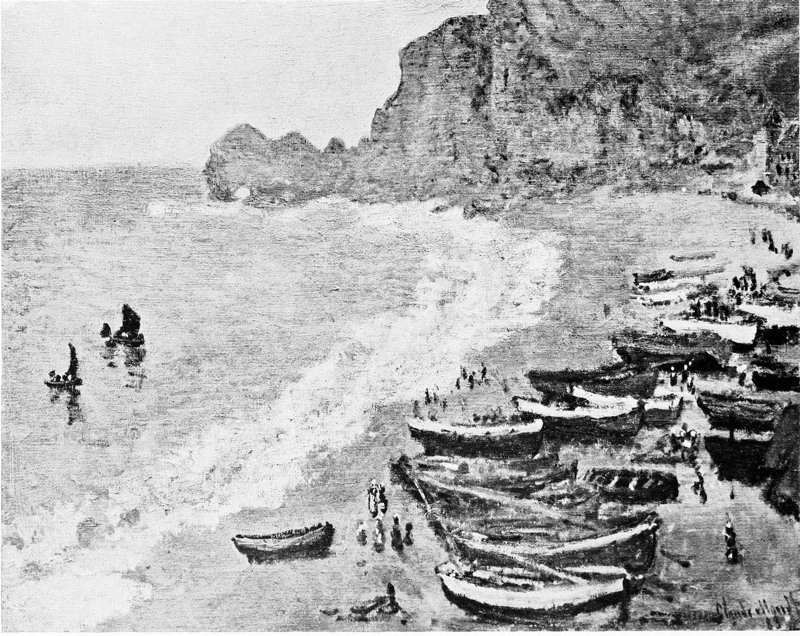
THE BEACH AT ÉTRETAT · CLAUDE MONET
Soon after Les Meules came Les Peupliers, exhibited in March 1892. The Haystacks were a recital of history during the four seasons; the Poplars show us their differing aspects under the 43changing atmosphere of a single day. Again the subject is of the simplest. Seven great Normandy poplars are reflected in the sluggish waters of a rivulet slowly running through marshy ground. The continuation of the long column of these graceful trees, ever diminishing, is lost in the distance, marking the sinuous course of the stream. The gracefulness of the subject gives it a nobility of effect. The landscapes are poems.
In some of the canvases the master has depicted the dim light of early morn, through which can be seen nebulous tree-trunks, leaves and grass, dank and obscure. Upon the water floats a chill blue mist, broken here and there with the gold rays of the rising sun.
In another canvas the mists have cleared away, morning appears in its superb glory, each dewdrop is a sparkling diamond, each leaf a shimmering gem. The stream throws out a sheen of gold and silver, and the whole picture is flooded with a roseate hue.
Then comes mid-noon. The blue dome of the unclouded sky is reflected in a deeper tint across the still water. The trees are dusty, lifeless, almost colourless. The atmosphere vibrates in an intense silent heat. Nature is taking her siesta,
In the last canvas night is shown falling gently upon the land, obscuring, with a veil of rich and sombre colour, trees, foliage, stream. The landscape is lost in sleep.
From the photographs, reproduced by the courtesy of M. Claude Monet, M. Durand-Ruel, M. Paul Chevallier, and M. Georges Petit, little idea can be gathered of the extreme beauty of the originals. The colour and technique of Impressionist pictures seem unfortunately to be insuperable barriers to their reproduction in monochrome. Upon this account it has been thought inadvisable to publish reproductions of any of the Haystack or Cathedral series.
Monet’s marine pictures are marvellous. In them he depicts throbbing, swelling, sighing sea, the trickling rills of water that follow a retreating wave, the glass-like hues of the deep ocean, and the violet transparencies of the shallow inlets over sand. Monet is the greatest living painter of water. Witness the Matins sur la Seine, views painted from the river bank, from the artist’s houseboat, anchored in mid-stream, and on the various islands of the backwaters 44between Vétheuil and Vernon. The handling is free, loose, and masterly. Never has art expressed, through the hands of a craftsman, anything finer or more virile; never were ideas more frankly expressed, more freshly and more brilliantly executed.
Of the last exhibited group of “effects,” the series known as Les Cathédrales of Rouen, exhibited at the Durand-Ruel gallery in the spring of 1895, Monet writes in a personal note to the author: “I painted them, in great discomfort, looking out of a shop window opposite the Cathedral. So there is nothing interesting to tell you except the immense difficulty of the task, which took me three years to accomplish.” Despite the immense difficulties involved in their production, Monet considers them to be his finest works. On the other hand, they are the works least understood by the public.
The series consists of twenty-five huge canvases, a feat requiring considerable physical endurance and indomitable perseverance. Each canvas demonstrates the fact that the painter possesses eyes marvellously sensitive to the most subtle modulations of light, and capable of the acutest analysis of luminous phenomena. The façade of the ancient Norman fane is depicted rather by the varying atmospheric effects dissolved in their relative values, than by any actual draughtsmanship of correct architectural lines. It is very regrettable that the series was not purchased “en bloc” for the French nation. The opportunity has been lost. The canvases realised enormous prices, and are now scattered over two continents.
In years to come visitors to Rouen will be shown with pride the little curiosity shop “Au Caprice” on the south-west side of the “Place,” from the windows of which Claude Monet evolved these world-famous paintings of Rouen Cathedral.
The attitude of the press and the public in face of this glorious manifestation of a newly-created art has been, as usual, distinctly and actively antagonistic. Animosity has been pushed so far as to include threats of personal violence to the innovator, and of injury to the offending canvases. It is difficult to believe such stories amidst the recent pæans of praise and adulation. But the contemporary press of the period will prove to be a curious study in the hands of some careful historian of a future age. Readers of the “Figaro,” it may be mentioned, discontinued their subscriptions and advertisements because the band of “lunatic visionaries” were so much as mentioned in its orthodox columns. Dealers required courage in exposing for sale the “aberrations of disordered imaginations.” History monotonously repeats itself. A genius generally goes down broken-hearted to his grave before the world awakes to the value of his creations.
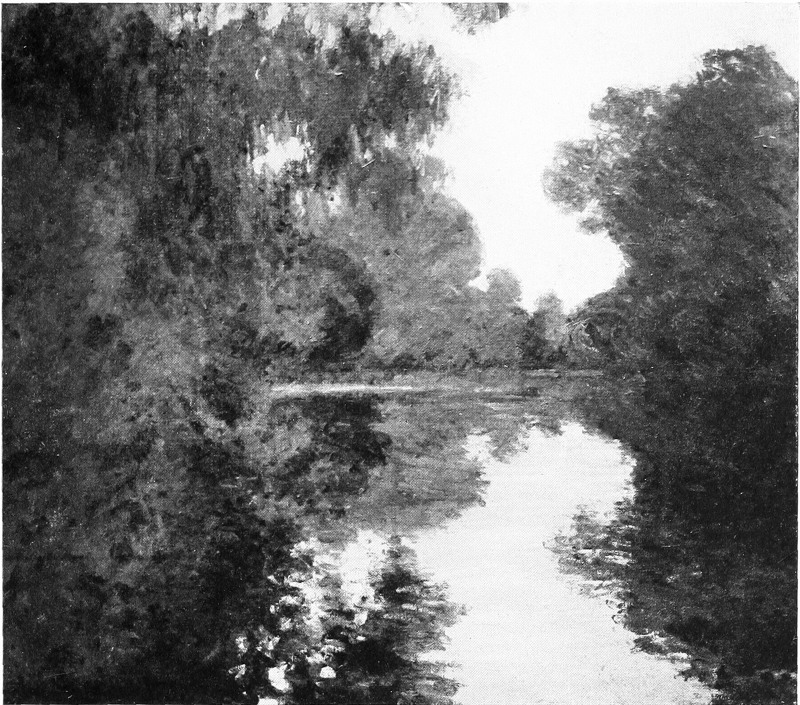
MORNING ON THE SEINE · CLAUDE MONET
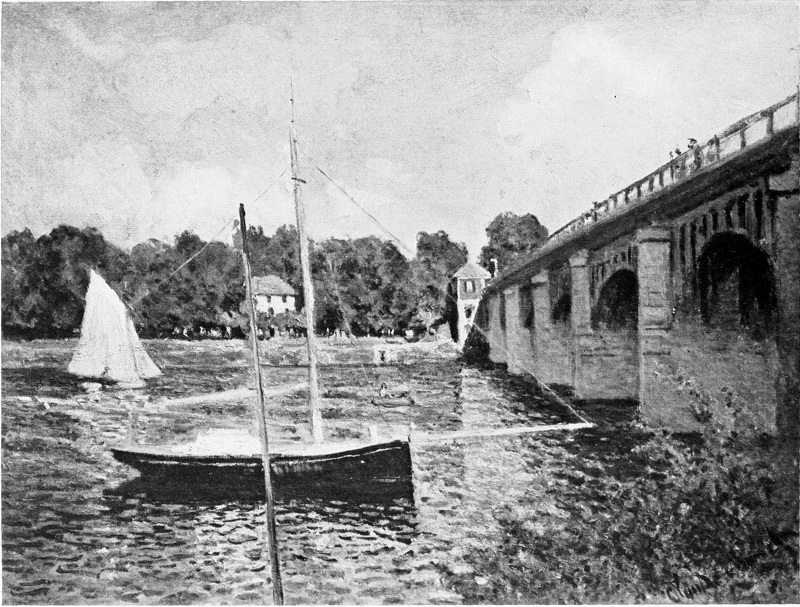
ARGENTEUIL · CLAUDE MONET
45Paris, “la ville luminaire,” the birthplace of so many revolutions, both artistic and political, has almost invariably been hostile to any new spirit in Art. From memory one can cite many instances. In 1833, Parisians assembled that they might jeer and throw mud at Baryes’s Le Lion, a masterpiece now in the Jardin d’Acclimatation. Rude’s great bas-relief, Départ des Volontaires de la République, decorating one of the pillars of the Arc de Triomphe, met with a similar reception. In 1844, the exquisite paintings of Eugene Delacroix, now in the Louvre, were greeted with a storm of ridicule. Carpeaux’s group of sculpture La Danse, ornamenting the façade of the Opera, was bombarded nightly with ink-pots, and the sculptor was broken-hearted when compelled to polish the figures of his magnificent Fontaine des Heures facing the Observatory. Millet and the Barbizon group had small thanks to return for their reception. The frescoes of Puvis de Chavannes in the Panthéon, the Sorbonne, and the Luxembourg had to be guarded against the risk of damage from an ignorant and exasperated public. The vituperation which assailed Rodin upon the completion of his statue of Balzac is quite recent, and cannot be forgotten.
Claude Monet has passed through like storms. Edouard Manet fell a victim to the fury of the attack. His physique was not strong enough to resist the continual warfare. But Monet is of stouter calibre, and has lived to see the triumph of his principles, although he has learnt to value much of the praise, nowadays lavished upon him, at its true worth.
Monet is seen in his most genial moods when, with cigar for company, he strolls through his “propriété” at Giverny, discussing the grafting of plants and other agricultural mysteries with his numerous blue-bloused and sabotted gardeners. He settled with his family at Giverny in 1883; and Stephen Mallarmé, his old friend the poet, has given us the address for his letters:
He is now sixty-two years of age, in the prime of his powers, active and dauntless as ever. Each line of his sturdy figure, each flash from his keen blue eyes, betokens the giant within. He is one of those men who, through dogged perseverance and strength, would succeed in any branch of activity. Dressed in a soft khaki felt hat and jacket, lavender-coloured silk shirt open at the neck, 46drab trousers tapering to the ankles and there secured by big horn buttons, a short pair of cowhide boots, his appearance is at once practical and quaint, with a decided sense of smartness pervading the whole.
Monet has the reputation of being surly and reserved with strangers. If true, this manner must have been assumed to repel those unwelcome visitors who, out of thoughtless curiosity, invade his privacy to the waste of valuable time and the gradual irritation of a most sensitive nature.
Determination is the keynote of Monet’s character, as the following anecdote (told me on the spot by the poet Rollinat) shows. In the spring of 1892 the artist was busily occupied painting in the neighbourhood of Fresselines, a wild and picturesque region of precipitous cliffs and huge boulders in the valleys of the Creuse and Petit Creuse. A huge oak-tree, standing out in bold relief against the ruddy cliffs, was occupying Monet’s whole attention. Studies of it were taken at every possible angle, in every varying atmosphere of the day. Bad weather intervened, wet and foggy, and operations were suspended for three weeks. When Monet set up his easel again the tree was in full bud, and completely metamorphosed. An average painter would have quitted the spot in disgust. Not so Monet. Without hesitation he called out the whole village, made the carpenter foreman, and gave imperative orders that not a single leaf was to be visible by the same hour on the following morning. The work was accomplished, and next day Monet was able to continue work upon his canvases. One admires the painter, and feels sorry for the unhappy tree.
After painting, Monet’s chief recreation is gardening. In his domain at Giverny, and in his Japanese water-garden across the road and railway (which to his lasting sorrow cuts his little world in twain), each season of the year brings its appointed and distinguishing colour scheme. Nowhere else can be found such a prodigal display of rare and marvellously beautiful colour effects, arranged from flowering plants gathered together without regard to expense from every quarter of the globe.
Like the majority of Impressionists, Monet is most pleased with schemes of yellow and blue, the gold and sapphire of an artist’s dreams.
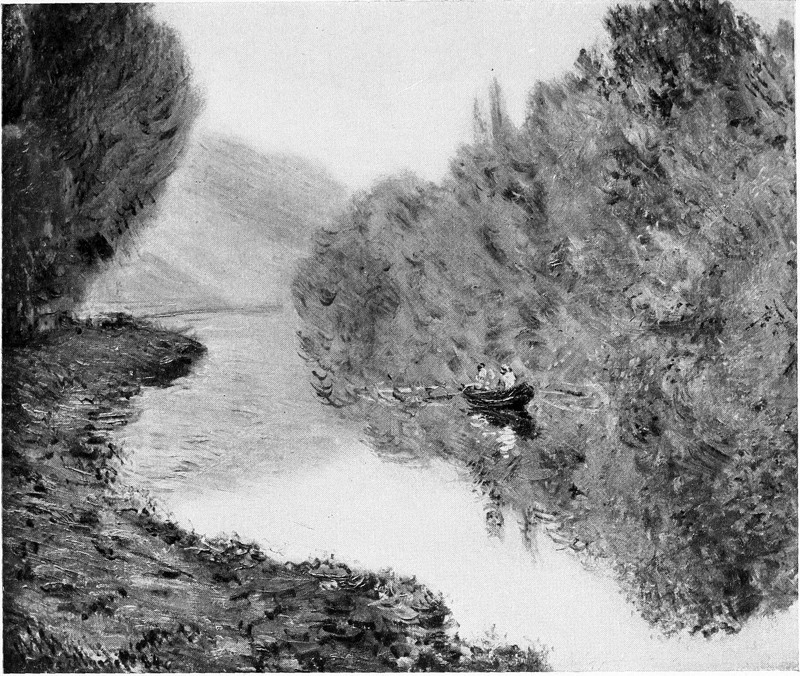
A RIVER SCENE · CLAUDE MONET
In the neighbouring fields are hundreds of poplars standing in long regimental lines. These trees, which inspired Les Peupliers, were bought by Monet to avoid the wholesale destruction which threatened every tree in the Seine valley a few years ago. The 47building authorities of the Paris Exhibition required materials for palisading, and thousands of trees were ruthlessly felled to make a cosmopolitan holiday.

A LADY IN HER GARDEN · CLAUDE MONET
In the distance are the mills, subjects of the master’s admiration and reproduction, yearly copied by the scores of students and amateurs who, year by year, during the summer, journey through this delightful country.
In the peace of Giverny we leave the great painter. He is one of the few original members of the Impressionist group who has lived to see the almost complete reversal of the hostile judgment passed upon his canvases by an ill-educated public. Now he is able to enjoy not only the satisfaction of having his principles acknowledged, but also the receipt of the material fruits of a world-wide renown. Not often do pioneers succeed so thoroughly.
Success in the sale-room is not always the same thing as artistic success, but some information as to the prices Monet now commands may prove of value. The New York Herald, referring to the well-known Chocquet auction, says: “It will be observed that the works by Monet are sought after and purchased at high prices, which are moreover justified by collectors as well as by dealers.” At the present moment a small example (about 26 in. by 32 in.) can be had for any price from four hundred guineas upwards.
After the Chocquet sale, dealers of all nationalities flocked down to Giverny. Two series of impressions, entitled Water Lilies and Green Bridges, were carried off, and the art public were deprived of seeing them exhibited as a whole, their creator’s original intention.
The dealers were ready to buy every canvas Monet had in his studio, even down to the numerous studies he had condemned. Needless to say that with regard to the latter they were disappointed, and the destroying fires will still claim their own. In discussing with the writer this sudden and extraordinary popularity, Monet remarked: “Yes, my friend, to-day I cannot paint enough, and make probably fifteen thousand pounds a year; twenty years ago I was starving.” Only artists can fully appreciate the philosophy of this short sentence.
The principal private collectors of Monet’s work are, in Paris, M. Durand-Ruel, Count Camondo, M. Faure, M. Dearp, M. Pellerin, M. Gallimard, and M. Bérard. In Rouen, M. Depeaux. In the United States, Messrs. C. Lambert Paterson and Potter Palmer of Chicago, Frank Thompson of Philadelphia, A. A. Pape of Cleveland, and H. O. Havemeyer of New York. All these 48rich collections of modern art are most generously thrown open to the inspection and enjoyment of students and lovers of art.
Claude Monet is in the possession of undiminished vigour, and the list of his works will yet receive the names of many fresh triumphs. A life of strenuous labour, unflagging perseverance in the pursuit of a high ideal from which he has never flinched, the production of a long series of magnificent canvases—these great qualities of true and inspired genius merit and receive our deepest admiration, our most sincere and genuine homage.
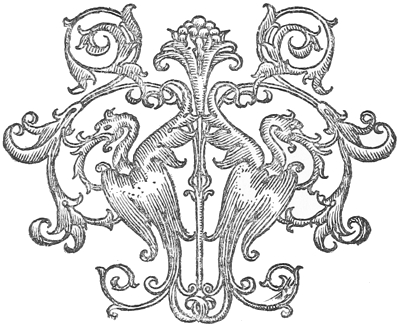

INTERIOR—AFTER DINNER · CLAUDE MONET
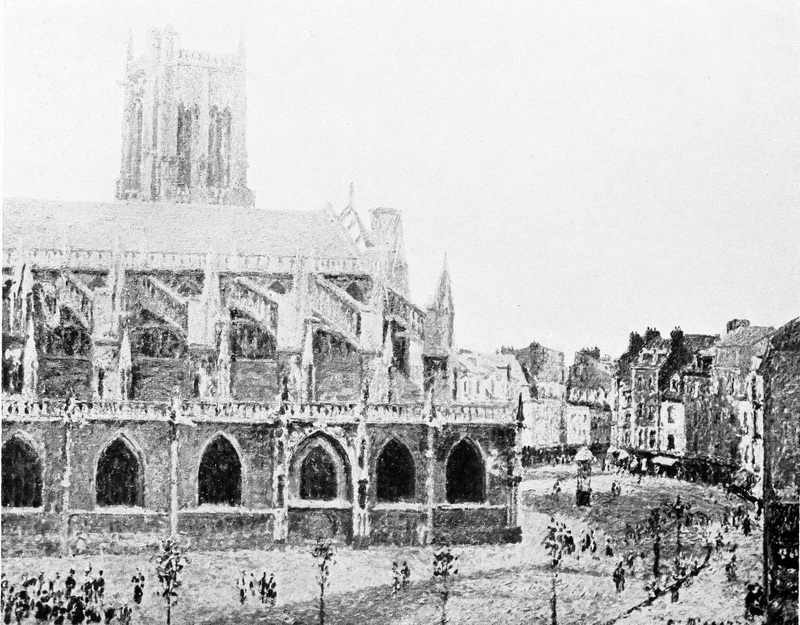
CHURCH OF ST. JACQUES, DIEPPE · CAMILLE PISSARRO
“JE CROIS QU’IL N’Y AURA RIEN DE PLUS TRISTE À RACONTER DANS L’HISTOIRE DE L’ART, QUE LA LONGUE PERSÉCUTION INFLIGÉE AUX ARTISTES VRAIMENT ORIGINAUX ET CRÉATEURS DE CE SIÈCLE”
THÉODORE DURET

THE artists who accepted originally the title of Impressionists numbered about fifty in all, and a complete list of their names can be found in the catalogues of the eight exhibitions held between 1874 and 1886. There were never more than a dozen active members. Twenty-six (including Boudin and Signac) exhibited but once, and ten were represented in two collections only. Pissarro was the single painter who contributed to the whole series, Degas and Berthe Morisot forwarding examples during seven years. Of the remainder, Rouart and Guillaumin were catalogued in six exhibitions; Caillebotte, Monet, and Tillot, in five; Cals, Mary Cassatt, Forain, Gauguin, Renoir, Sisley, and Zandomeneghi, in four. These artists were the original members of the group until it dispersed about 1886.
It will be noted that Camille Pissarro exhibited eight times, and the fact is characteristic of an artist who was famous for his large output. On the eve of the publication of this volume comes the sad intelligence of the death of one of the most gifted members of the early Impressionist group in France. The loss of Camille Pissarro is a severe blow to the art he loved so well, and it has formed the subject of general regret. Born in 1830 at St. Thomas, in the Antilles, son of a well-to-do trader of Jewish descent, Pissarro at an early age showed signs of artistic promise. In 1837 his parents moved to Europe, and his precocious talent was noticed by the Danish painter Melbye, who took the boy into his atelier as a pupil. In 1859 Pissarro exhibited for the first time at the Salon, and, by all accounts, his picture was successfully received. After passing through several varying phases of artistic evolution the young painter became an avowed Impressionist. Camille Pissarro’s career can be divided into no less than four different periods, his temperament being curiously influenced at times by novel technical ideas.
At first he was a victim to Corot’s magic art, and Pissarro worked 50by the side of that master in the woods of Ville d’Avray. The young painter’s methods were those fashionable amongst such men as Courbet, Manet, and Sisley. He worked upon immense canvases, and some of the productions of this period are almost classic in style and quality of technique. Then he came under the influence of another great master, Jean-François Millet, whose methods he copied most faithfully. Following the example of Millet, Pissarro went to live in the solitude of plains and woods, painting the peasant life and landscape around him, and gradually gaining a considerable reputation. He sought to reproduce nature in art in much the same spirit as Virgil reproduced nature in poetry. His point of view was more that of an idealist than a realist, and his sympathies were clearly with the Fontainebleau school. Had there been no Monet we may feel sure that Pissarro would have ranked in history as one of the leaders of the Barbizon men.
Then blossomed the Impressionist Idea, and Pissarro’s volatile imagination was fired. The great war of 1870 intervening, Pissarro fled from the terrors of the invasion, visited London in company with Monet, and studied on the spot the masterpieces of Turner, Constable, the Norwich painters, Watts, and the great English portraitists. He lodged in Lower Norwood, and painted, also with his friend Monet, in the parks and suburbs of the metropolis, along the riverside, and in the crowded picturesque streets of the City. Twelve years later, after much brilliant practice of Impressionism, Pissarro came under a new influence, the effects of which were but momentary. The hotly discussed idea known as Pointillism, originated by Seurat and Signac, attracted Pissarro, and, for a short time, he joined the group of such restless innovators as Angrand, Maurice Denis, and Van Rysselberghe.
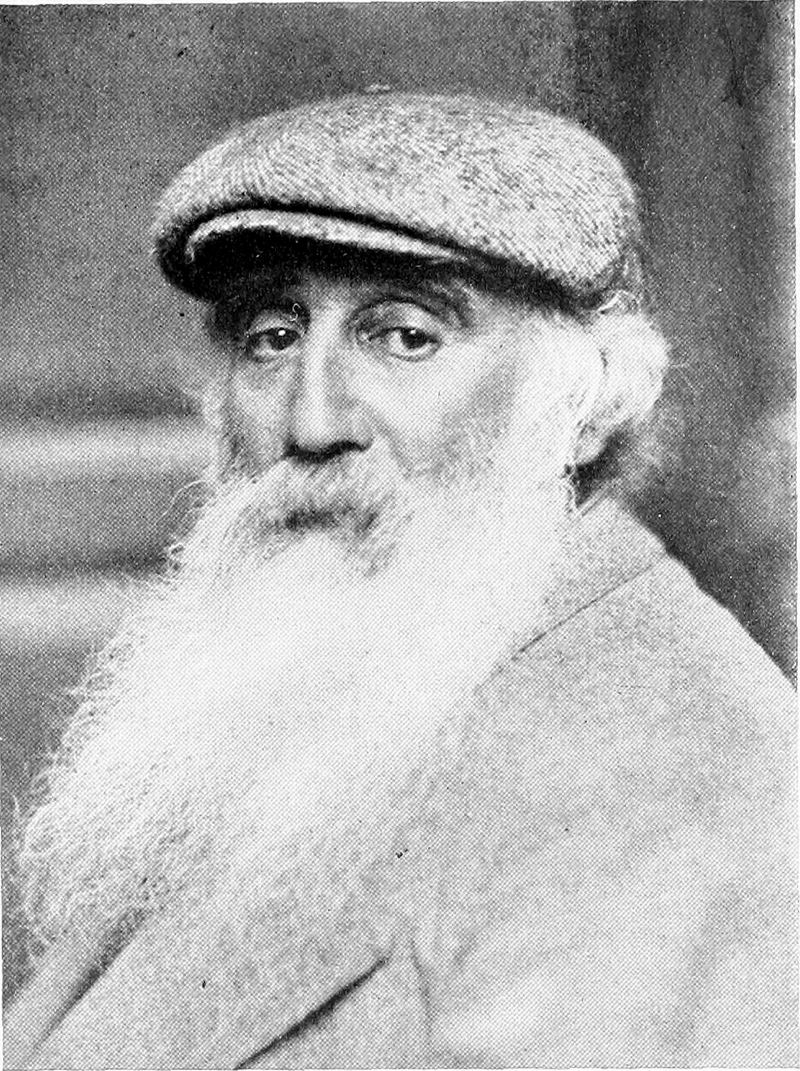
CAMILLE PISSARRO
During a sketching tour in Normandy in the summer of 1903, the writer unexpectedly discovered some of the latest work produced by Pissarro. These pictures had been painted in Havre a few weeks previously, and had been immediately acquired by the Havre City Council, and placed on exhibition in the same gallery which contained the important collection of sketches by Eugene Boudin, as well as a score of works by other artists of the Impressionist group. Pissarro had represented the port of Havre as seen from various “coigns de vantage” offered by neighbouring balconies. The canvases are charged with life, and are painted with a most unsuspected brilliance of colour and freshness of tone pitched in the highest possible key, an effect to be found only in the pure sea-washed sunlit atmosphere of the morning. In this work of his seventy-third year, the veteran artist had never arrived at stronger, happier, and more distinguished results.
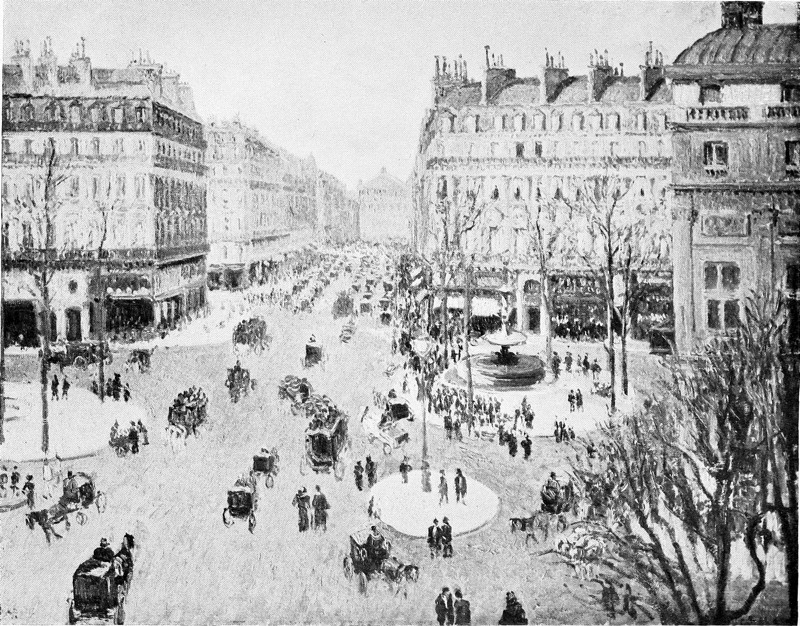
PLACE DU THÉÂTRE FRANÇAIS · CAMILLE PISSARRO
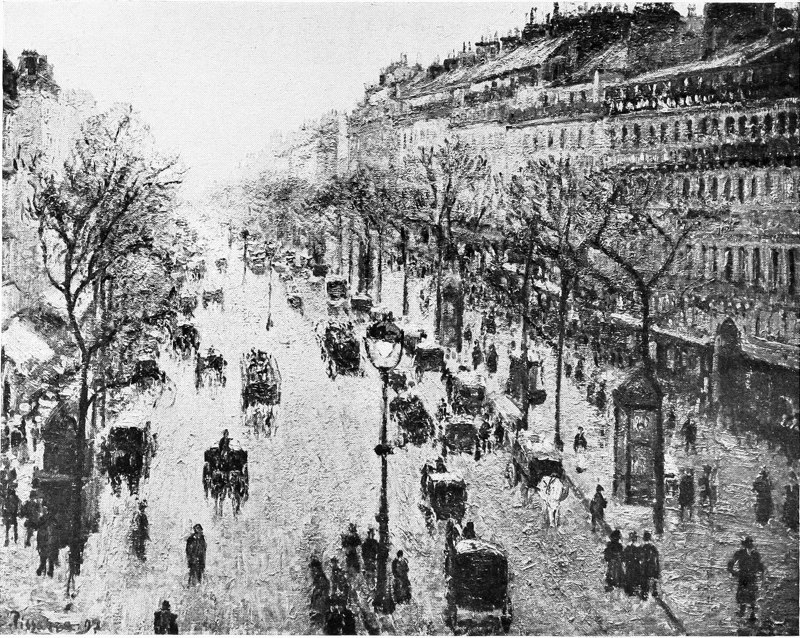
THE BOULEVARD MONTMARTRE: A WINTER IMPRESSION · CAMILLE PISSARRO
51These canvases were extremely different in technique and effect from the drab landscapes Pissarro painted with such a niggling touch during that period of his career prior to 1886. The Havre works prove that he possessed an acute colour sense, and, in conjunction with his inimitable Parisian street scenes, place him second only to Manet and Monet in the history of modern French art. It is the opinion of many connoisseurs that Pissarro’s best work is comprised in the series of views (painted from elevated points of view) of the streets, squares, and railway stations, of Paris and Rouen. These vivid transcripts of modern town life form a remarkable monument of a long career of high resolve and incessant industry.
Like that of Monet and other Impressionist artists, Pissarro’s work now commands high prices, which are steadily advancing. Shortly after his death a landscape entitled La Coté Sainte Catherine à Rouen was sold by public auction for 11,000 francs, an average present value for his canvases, although not a record figure.
With the etching needle Pissarro has done some particularly interesting work little known in England. Students of this fascinating medium should look through the Rouen etchings, a masterly little set.
Camille Pissarro was a man of commanding personality, and his handsome features and long white beard gave him a patriarchal appearance. Of charming disposition, with a mind of simple nobility, an excellent raconteur of droll stories chiefly drawn from his own interesting experiences, he will long be remembered as one of the most attractive of the great French artists of the nineteenth century. He lived and worked, as befitted a “paysagist,” in the midst of a beautiful stretch of country at Eragny, outside Gisors, not far from Monet’s residence at Giverny. Pissarro left a considerable amount of work behind, paintings in oil and water-colour, drawings in every medium, etchings, and lithographs. His art may be summed up as powerful. It possessed a healthy vitality and sentiment, and these will assure a lasting respect and admiration for his name.
Many of the foregoing remarks apply equally to Pissarro’s close comrade and friend, Renoir. Auguste Renoir was born in 1841, and has always taken an important place in the Impressionist movement. His work forms an epitome of the whole school, and perhaps it is for that very reason that the artist has not attained a higher popular appreciation. During his forty years of continual labour he has produced landscapes, seascapes, large subject compositions, 52studies of still-life, portraits, and exquisite nudes. Critics, charged with enthusiasm, have found in his canvases the finest traits of Boucher, Fragonard, Greuze, Reynolds, and Hoppner.
Renoir is above all the painter of women and children, and his creations in this genre glow with the sure fire of genius. He renders in a marvellous fashion the subtle play of light upon flesh. His portraits are charming and typically French, graceful in line and rich in colour, drawn with extraordinary skill, and with great truth to nature. In the portraits of Bonnat and Duran, writes a German critic, there are people who have “sat,” but here are people from whom the painter has had the power of stealing and holding fast the secret of their being at a moment when they were not “sitting.” Here are dreamy blond girls gazing out of their great blue eyes, ethereal fragrant flowers, like lilies leaning against a rose-bush through which the rays of the setting sun are shining. Here are coquettish young girls, now laughing, now pouting, now blythe and gay, and now angry once more, now faltering between both moods in a charming passion. And there are women of the world, of consummate elegance, slender and lightly built figures, with small hands and feet, an even pallor, almond-shaped eyes catching every light, moist shining lips of a tender grace, bearing witness to a love of pleasure refined by artifice. And children especially there are, children of sensitive and flexuous race; some as yet unconscious, dreamy and free from thought; others already animated, correct in pose, graceful, and wise. Good examples of this artist as portraitist are to be found in the pictures Le loge, and On the Terrace, the latter a most delightful composition.
Another famous canvas by Renoir is the Bal au Moulin de la Galette, a most trying theme in which the master has triumphed over every difficulty. Degas would have conceived the composition in a very different spirit, throwing stress upon the sordidness of this scene from low life, adding a bitterness which is quite foreign to the temperament of Renoir, whose dominant note is one of sunlight and noisy dust-enveloped pleasure.
Criticising the work of Renoir from a purely technical point of view one finds throughout almost the whole of his work an unpleasant tone of Prussian blue, which strikes one at times as spotty and crude. The handling of the large-sized portrait groups seems often unnecessarily coarse and repellent. Many find it hard to appreciate his landscapes, considering them to be thin, of a greasy woolly texture, unatmospheric and lacking many of the qualities one looks for in such representations of nature.
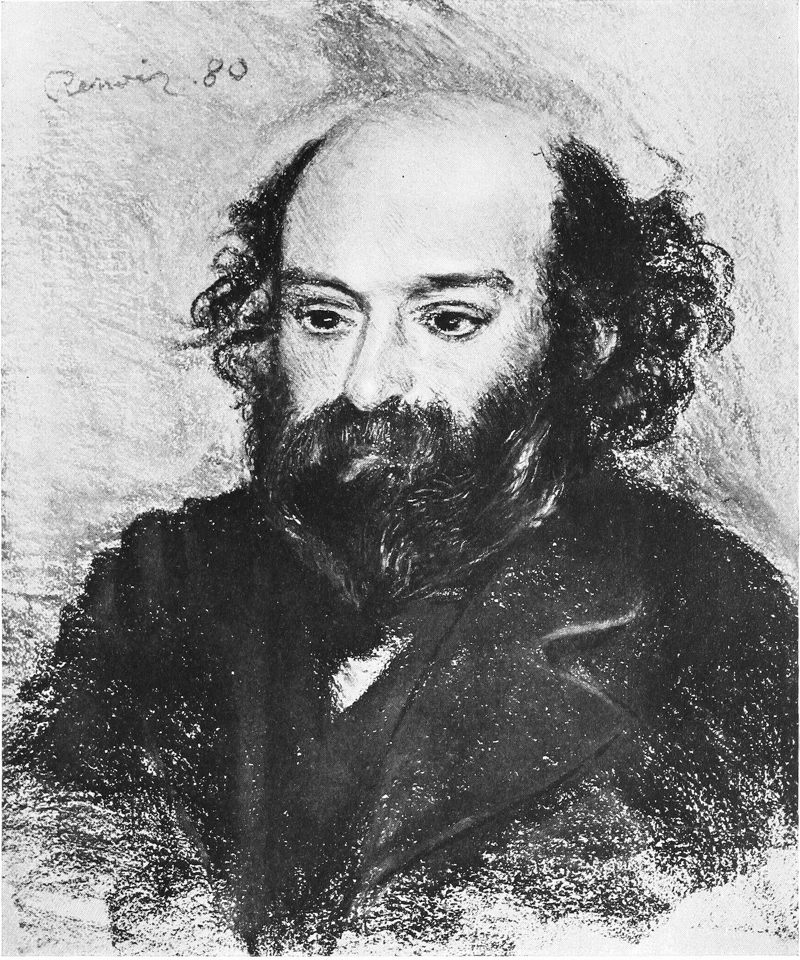
PASTEL PORTRAIT OF CÉZANNE · AUGUSTE RENOIR
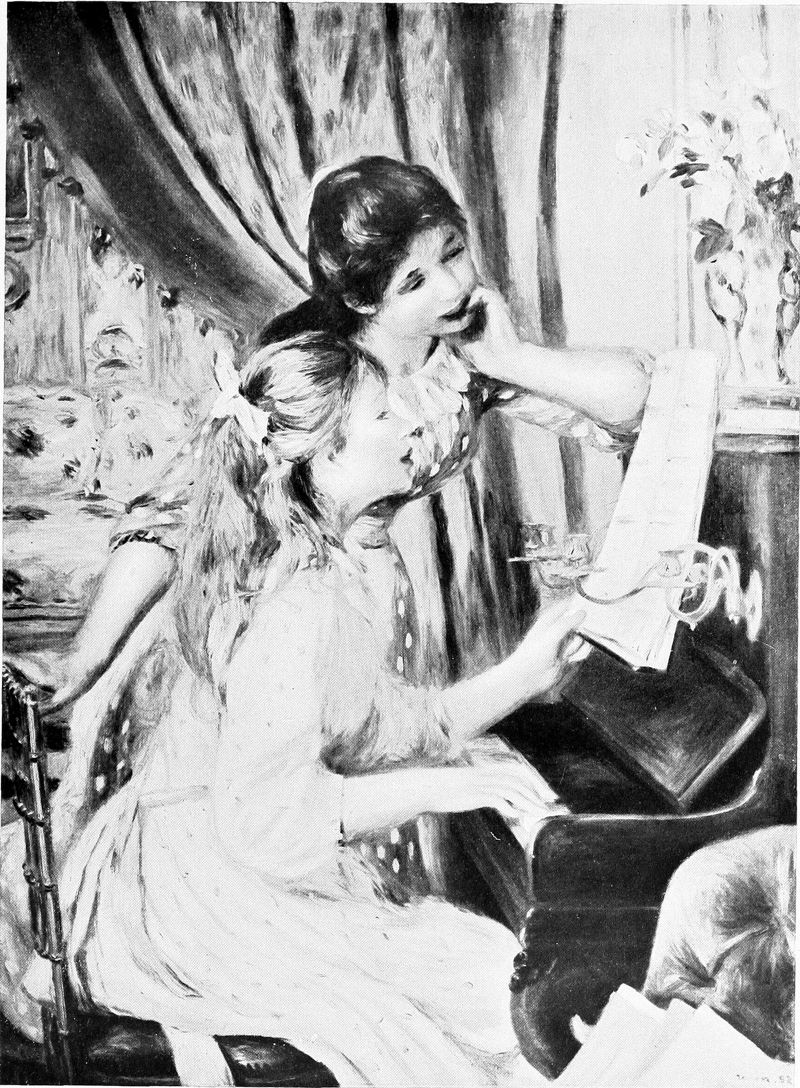
AT THE PIANO · AUGUSTE RENOIR
53The work of Auguste Renoir will always remain a battlefield for the critics. The champions of the group acclaim him as one of its most brilliant members. Renoir is voluptuous, bright, happy, and learned without heaviness, says M. Camille Mauclair, adding that the artist is intoxicated with the beauties of flowers, flesh, and sunlight.
Rare are the artists who distinguish themselves in every branch of art, lucky the man who excels in one. An example of the latter is Alfred Sisley, “paysagist” pure and simple, who has left a legacy of some of the most fascinating landscapes ever painted.
Sisley was born in Paris of English parents in 1839, and remained a citizen of the country of his birth, although he paid several visits to England. At first he painted conventional landscapes in russet and grey, after the type of Courbet. After passing under the influence of Corot he commenced to evolve a style peculiarly his own, abundantly rich in colour and agreeable in line, loving especially to paint the violet tints of a sunlit countryside, generally upon canvases of small and medium size. In his earlier days canvases of enormous extent alone seemed to satisfy him. He specialised his efforts almost solely to transcripts from the riverside. When in England he remained in the neighbourhood of Hampton Court and the Thames valley generally; in France he painted on the edge of the Seine, or the Loing, finally settling at Moret, where he died in 1899. He was less successful in draughtsmanship than in colour, particularly when he attempted to achieve with Moret church what Monet had done with Rouen cathedral.
In spite of the production of many little masterpieces, Sisley lived to the day of his death on the verge of poverty. Never a popular artist, although he and his wife led a life of the most frugal description, he was for ever uncertain of finding the barest means of subsistence. This embittered his existence, and undoubtedly tended to cut short a life of much activity and talent. “Sisley, be it said, worked always, struggled long, and suffered much. But he was brave and strong, a man of will, consecrated to his art, and determined to go forward on the road he had taken, wherever it might lead. He faced bad fortune with a front of undaunted energy. His years of début were cruel times. His pictures sold seldom and poorly. He kept on, however, with the same brave heart, with that joyous fervour which shines from all his works.” These words were spoken by an old friend at the graveside of Sisley. M. Tavernier went on to remark that the success which arrived for several of the other Impressionists was slower in coming to Sisley. “This never 54for a moment disturbed him; no approach to a feeling of jealousy swept the heart of this honest man, nor darkened this uplifted spirit. He only rejoiced in the favour which had fallen upon some of his group, saying with a smile, ‘They are beginning to give us our due: my turn will come after that of my friends.’... Sisley is gone too soon, and just at the moment when, in reparation for long injustice, full homage is about to be rendered those strong and charming qualities which make him a painter exquisite and original among them all, a magician of light, a poet of the heavens, of the waters, of the trees—in a word, one of the most remarkable landscapists of this day.”
A contemporary of Sisley, equally gifted and more fortunate financially, is Armand Guillaumin, whose art is practically unknown in England. His style and his subjects are of the simplest, whilst his colour is vigorous, pure, and rich in tone. Possessing few tastes outside his art his life has been one of continued and active devotion to its perfection. Son of a linendraper, like Corot, his youth was passed behind the counter, and later as a clerk in an office. In the meanwhile he attended, when possible, the “Académie Suisse,” by the Quai des Orfèvres, a curious school without professors. Here he worked in company with Pissarro and Cézanne. This, combined with study in the public galleries and sketching along the riverside and in the streets and parks of Paris, constituted his sole education.
In a letter to the writer, Guillaumin says that Courbet, Daubigny, and Monet are the masters who have influenced his style most, with perhaps special stress upon the methods of Monet.
Some years ago a lucky speculation in a lottery attached to the Crédit Foncier brought the artist a “gros lot” of about £4000, which immediately freed him from further anxieties about money, and gave him complete liberty to exercise the art he lives for. He contributed to the original exhibition held by the Impressionists in 1874, where his pictures, views of Charenton, at once marked him as a painter of special talent and originality. In 1894, at the Durand-Ruel galleries, were exhibited about one hundred of his canvases executed in various mediums, and the effect of this collection upon students has been remarkable. These pictures were painted for the most part at Agay, Damiette, and Crozant. In the solitude of these deep valleys, overhung by cliffs down which rush the limpid Creuse and Sédelle from the mountains of the Cevenne to the sea, works the artist in hermit-like solitude, two hundred miles from Paris and far from railways and latter-day civilisation.
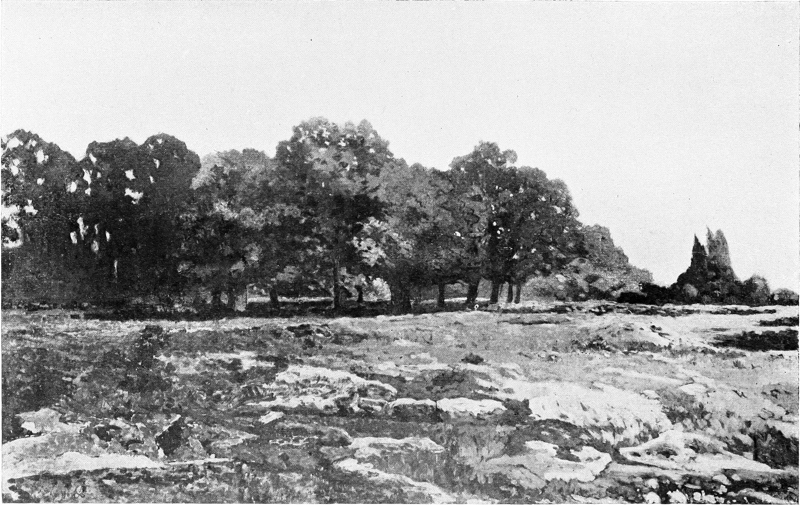
OUTSKIRTS OF THE FOREST OF FONTAINEBLEAU · ALFRED SISLEY
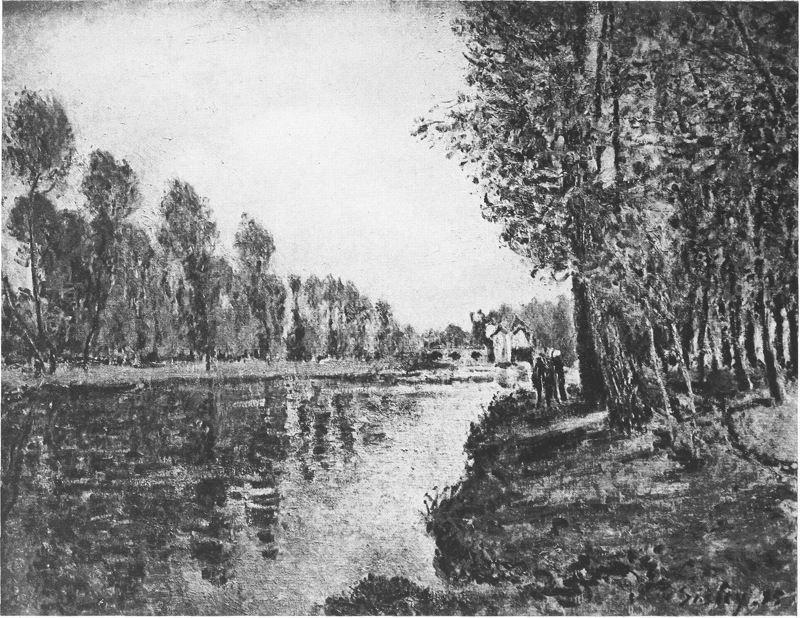
ON THE BANKS OF THE LOING · ALFRED SISLEY
Guillaumin is an incredibly prolific worker, and this, although 55often a sign of great talent, is much deplored by his admirers, who cannot help believing that he is wasting in the production of countless sketches and repetitions a talent which is strong enough to create masterpieces. Zola’s reproach addressed to Gustave Doré comes to the mind when speaking of Guillaumin. Such an artist is likely to combine with business men in manufacturing works purely commercial. There is yet time for Guillaumin to produce some great masterpiece with which to crown the glory of his long career.
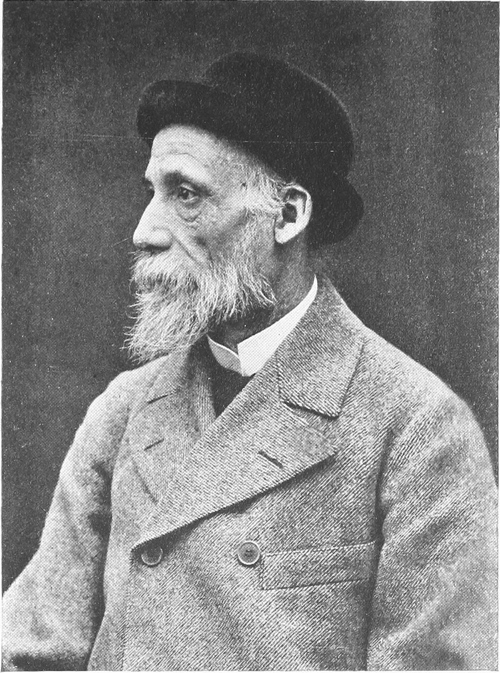
AUGUSTE RENOIR
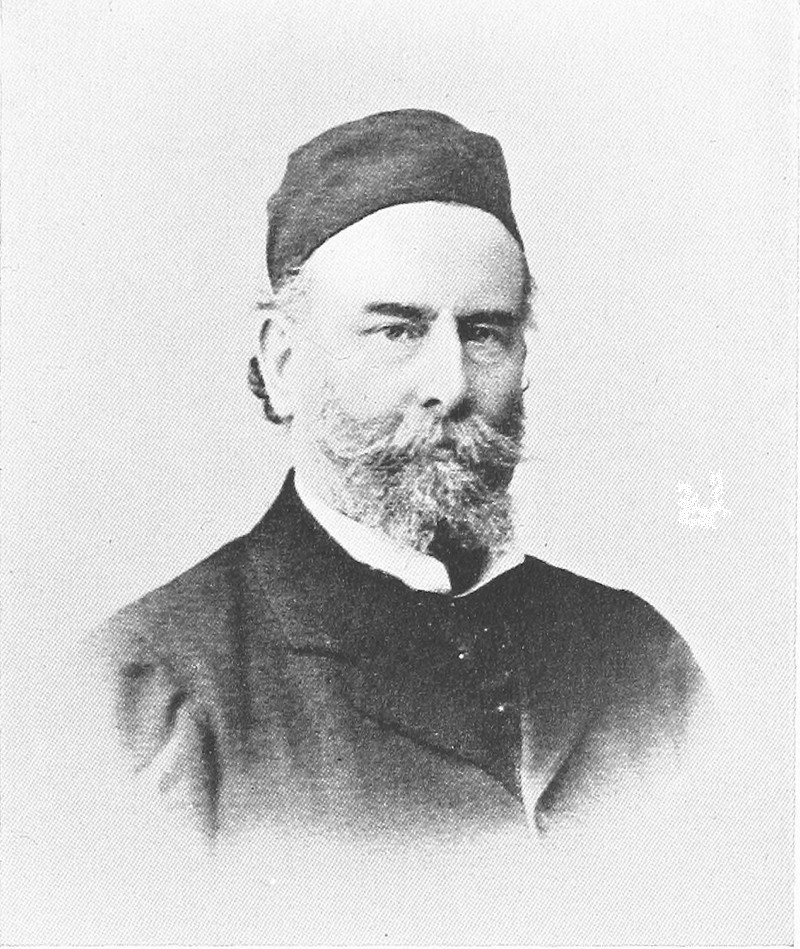
ALFRED SISLEY
Other manifestations from the parent stem of Impressionism took the form of Idealism with André Mellino at its head; the Salon of the Rose + Croix, with Sar Peladan in command; and the “Intimists,” a body consisting of Charles Cottet, Simon Bussy, and Henri Le Sidaner, who is referred to elsewhere. The Salon of the Rose + Croix, held in the early nineties, was one of the most eccentric art societies of the past century, a mixture of art, religion, politics, and rules of morality. Its members were forbidden to exhibit historical, prosaic, patriotic, and military subjects, portraits, representations of modern life, all rustic scenes and landscapes (except those in the style of Poussin), seamen and seascapes, comic subjects, oriental subjects, pictures of domestic animals, and studies of still-life. The doings of Sar Peladan and his followers have long since been forgotten, but at the time they afforded a curious study in artistic eccentricity.
There are several other men who have rendered good service to Impressionism, although one is not able to mention more than their names in this chapter. Paul Gauguin, an artist of decided ability, whose death has only just been chronicled, contributed to several of the exhibitions in the Durand-Ruel and other galleries. At first a simple painter of Breton landscapes he inclined towards “Pointillism.” Upon his return from a long visit to Tahiti his manner became crude and bizarre to an extreme, not altogether admirable, although leaving an impression of uncommon strength. Gauguin was a friend of Van Gogh whom, together with Renoir and Cézanne, he may be said to have influenced. Another of his pupils is Emile Bernard, the symbolist.
Vincent Van Gogh requires mention as a painter who practised the methods of Impressionism to their extreme limit. A Dutchman who lived in France, Van Gogh, a man of great talent, committed suicide after a most unhappy life. Like his own personality, these canvases are exotic, though at times displaying a more tender note. Had fortune been less unkind he would have developed into a great artist, for nature had endowed him with a rich genius.
56In the eighth exhibition organised by the Société des artistes Indépendants were some ambitious works, interesting but totally unconvincing, painted in the new and then hotly discussed “Pointillist” style. Seurat, Signac, Ibels, Maurice Denis, Henri-Edmond Cross, Théo Van Rysselberghe, and Angrand, were members of this movement initiated by Seurat and Signac. George Seurat died at an early age in 1890, and this was doubtless the chief reason for the collapse of the group. The aim of the “Pointillists” was to resolve the colours of nature back into six bands of the spectrum, and to represent these on the canvas by spots of unmixed pigment. At a sufficient distance these spots combine their hues upon the retina, giving the effect of a mixture of coloured lights rather than pigments, resulting in an increase instead of a loss of luminosity. One of the first converts was the veteran Camille Pissarro, who happily abandoned these extraordinary methods which Théo Van Rysselberghe and a few others continue to employ.
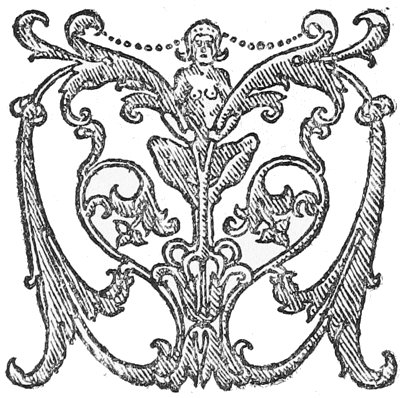

OUTSKIRTS OF A WOOD · ALFRED SISLEY

CHILD AND DOG · EUGÈNE CARRIÈRE
“WHENEVER MEN ARE NOBLE THEY LOVE BRIGHT COLOUR, AND WHEREVER THEY CAN LIVE HEALTHILY, BRIGHT COLOUR IS GIVEN THEM IN SKY, SEA, FLOWERS, AND LIVING CREATURES”
RUSKIN

EUGÈNE Carrière is one of those great artists so prolific in France who alone would make the fame of any ordinary country. For his work the writer has always had deep sympathy, and this feeling has strengthened since the days when he copied the works of the master now in the Luxembourg. There can be no better method of studying any artist, and specially is it needed in the case of such a painter as Carrière. It is only during the long patient hours spent in trying to reproduce in facsimile these strange elusive pictures that one can grasp their technical qualities, their poetic intention, their thoughtful nature, and can fully recognise the fine achievement of the artist. As the copyist stands and works for hours, thinking, reasoning, reproducing, the whole history of the man and his art slowly reveals itself.
It has been said of Carrière that he has “le génie de l’œil,” and it is exactly this “genius of the eye” which constitutes the bond of sympathy between all Impressionists. There exists between Carrière, Pointelin, and Whistler, the greatest similitude. Their outlook upon nature is identical, and their method of expression most characteristic. They have found their chief inspiration in rendering misty veiled effects, sometimes the result of natural means, haze, moonlight, river mist, early sunrise; sometimes purposely arranged by means of darkened interiors, and the skilful control and exclusion of strong lights. In each case the result sought after is the same.
Carrière possesses, in almost the highest possible degree, the power of visualisation (one is nearly writing the power of second sight) which Claude Monet also has, though in a different degree. The first has caught in an entrancing style the infinitely varied degrees of luminous light in the evening twilight. He has painted the shadows of shades. The second, in an equally fascinating manner, has rendered the shadows of sunlight. In the works of both artists all exact contours are lost; in Carrière by reason of 58the semi-obscurity of night, in Monet because of the blinding equalising glare of noon-day sun. The one is as apparently colourless as the other is apparently exaggerated. Yet both are right, true to nature and to their own individual temperaments, in fact true Impressionists.
As a portraitist Eugène Carrière has no rival at the present moment. His marvellous powers of vision have placed him in a position unassailable. The ordinary portraitist, the painter “à la mode” (probably “à la mode” for this very reason), depicts the superficial aspect of his sitter, together with a photographic delineation of the features. Whilst the onlooker wonders at the dexterous skill, the clever schooling and frequent harmonies of colour, he generally passes on unmoved. With Carrière the effect is different; one cannot easily leave such triumphs. On the contrary, we stay to admire, not the technical gymnastics of the artist, but the subtle superhuman manner in which the soul of the sitter has been transferred to the canvas by the brush of a man of rare genius.
His lithographs too are marvellous. Should any reader carp at the use of such word let him carefully examine the portrait-studies of Anatole France, Rodin, Verlaine, Daudet, Geffroy, Madame Carrière, and the artist himself, also the Christ at the Tomb, the Théâtre de Belleville, Maternité, and many others. The more these great works are studied the more real they become. Daudet lives again in a drawing recreating the great novelist in a peaceful atmosphere of dreams which seems to remain the peculiar secret of the artist. Eugène Carrière becomes a clairvoyant when he commences a portrait.
His paintings of the intimate life of the family, the circle round the fireside or the little gatherings in the common room during a winter evening, have a quiet charm which his contemporaries rarely attain. Such groups, it may be said, find little favour from those who issue commissions for family heirlooms, and Carrière has no chance of becoming a fashionable painter of human mediocrity. One remembers though that Mr. Sargent has proved recently that even with mediocrity a genius can do a great deal. Carrière, however, is never likely to wish to rival Bonnat or Carolus-Duran. His scenes are not so much represented as suggested. His drawing is a reproduction of the play of light upon the different planes of the subject, the whole picture becoming a symphonic development of light. His brush manipulates colour much as a sculptor manipulates clay, and the results are real Impressions.
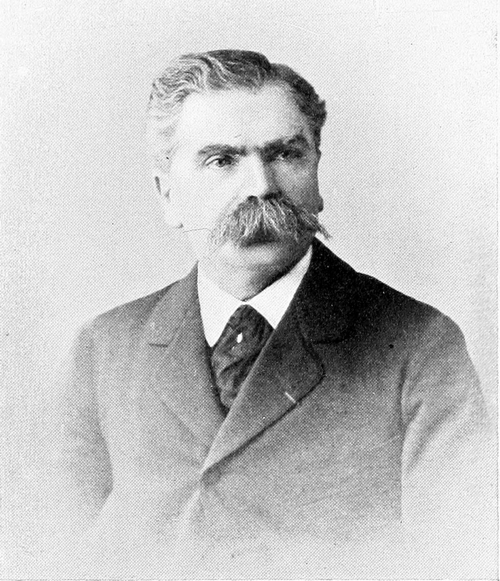
AUGUSTE POINTELIN
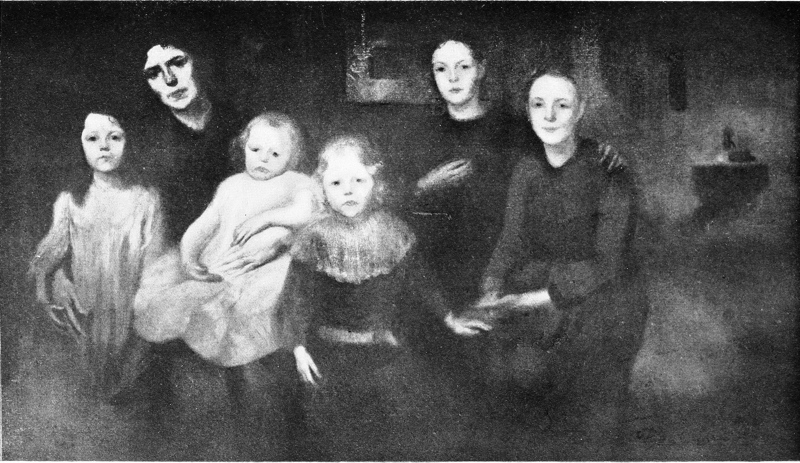
THE FAMILY · EUGÈNE CARRIÈRE
Eugène Carrière has been inspired by no particular school, and 59has no special theories to regulate his methods. Yet, in spite of himself, a group, animated by his ideals, has gathered and formulated rules. This group and its system will have but a short duration, for an art so personal and distinguished as is that of Carrière cannot in any possible way be transmitted to pupils or followers. Carrière occupies in painting much the same position as his friend Rodin occupies in sculpture. Such art is not to be copied, much as it may be admired. If there could be any analogy in literature one would cite Edgar Allan Poe. The poet of the shadows has had an enormous influence upon French art and literature, and Carrière has undoubtedly come under his strange spell.
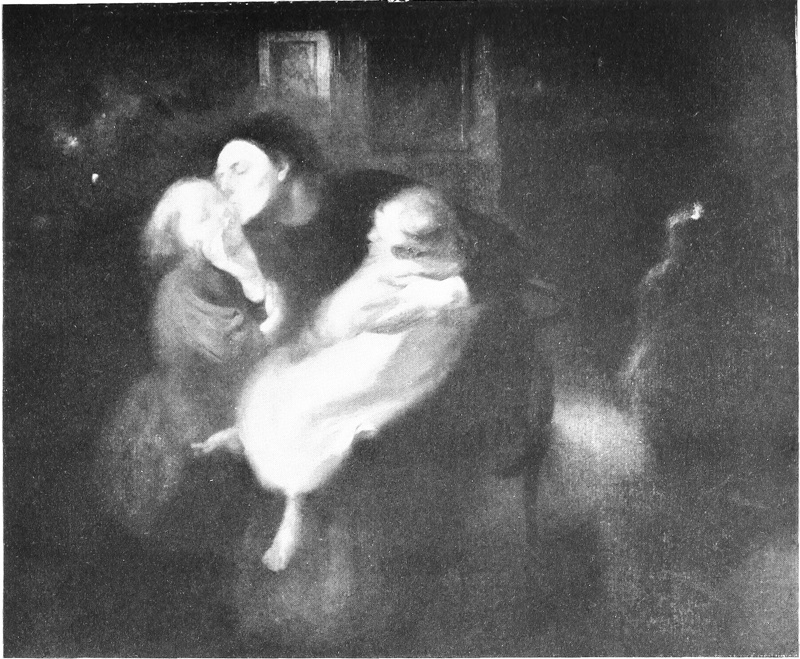
MOTHERHOOD · EUGÈNE CARRIÈRE
Much has been written concerning the exhibited works of this artist, and a bibliography would contain the names of the most celebrated art critics in Paris. The universal opinion is that in Carrière France possesses an artist of exceptional endowments. His gift is a peculiar one, which has not appeared before in exactly the same manner, and, within his own limitations, the painter’s equal will probably never be seen again. A well-known writer upon art subjects has penned an appreciation which conveys a clear insight into the methods of the master. Carrière, he says, is not an inductive painter, he does not construct his whole from parts. He does not work on, wisely, cautiously, from the forehead to the eyes, continuing by way of the cheekbones. In the manner of a sculptor, he builds up his picture as a complete whole, he balances his masses, he constructs. Insensibly the face lights up on the background, the successive veils which enveloped it are torn away and hide his thoughts no longer. This simultaneous process never leaves him quite satisfied, and he constantly reviews his original plans. He lives for the creation to which he gives life. His work is an effort, an attempt, the result of a mysterious genius whose secret is never all told. What he knows before is the impression he expects to obtain, what it will tell, what it will reveal of the character and will express of the invisible reality. And it is thus he approaches those faces which speak to us of an intense inner life. His plans settled, he paints astonishing faces, mobile and quivering as they smile and speak.
A few personal particulars may be added. Eugène Carrière passed his life up to the age of eighteen in Strasbourg, and displayed no special inclination toward the artistic career. But a visit to some galleries awoke the latent fire, and his ambitions were roused. He then entered the atelier of Cabanel. During the war he was captured by the Germans, and sent as prisoner to Dresden, where he studied with diligence in the museums. Upon his return to France 60in 1872 he worked for five years at the École des Beaux-Arts (he had been there for a short time before the war) and then, none too well equipped for the battle, set up in his own studio. He attempted to gain the Prix de Rome, but failed. Shortly after followed his marriage, together with a semi-retreat to the Vaugirard, where he toiled for five years, turning his family to artistic account as models. These days of unremitting labour proved to be the foundations of his fame, for, when he returned to Paris, he reaped almost immediately the fruits of success and appreciation. As we write, the news comes that the authorities of the Luxembourg have purchased Carrière’s Dead Christ for £1000.
Auguste Pointelin is a passionate Impressionist in the best sense of the word. He paints in low tones (almost monotones) the twilight, moonrise, the sombre and melancholy notes in Nature. He is the poet-painter of those evening hours when—
The artist’s character can be read at a glance from these canvases. We see at once that he is a strong man, of nervous and romantic temperament, somewhat a pessimist, perhaps a writer of verse, probably a fine musician, fond of solitude and reverie, yet of good heart and noble mind.
Monet is of the lowlands. He worships the plains and paints the sun hot and keen, and all that it reveals. He revels in depicting great trees, the lustrous brilliancy of corn and poppies, the bubble and iridescence of quick-flowing trout-streams, the flash of white cliffs, the luminous shadows of haycocks, every varying phase of the play of brilliant light upon the face of responsive nature. Pointelin is a man of the hills, delighting to work amidst deep wooded glens or lonely tracks of mountain scenery, trying to reproduce the glints of moonlight upon black bottomless pools. He loves to depict the tranquillity of the long silent valleys, through which roll heavy mists, whilst the rising sun tints with a rosy glow the tips of the neighbouring peaks. Our admiration of Monet does not blind us to the beauty of Pointelin. In a sense the two artists are complementary to each other. The art of Pointelin may be compared to a “Reverie” by Schumann, that of Monet to a “Rhapsody” by Brahms.
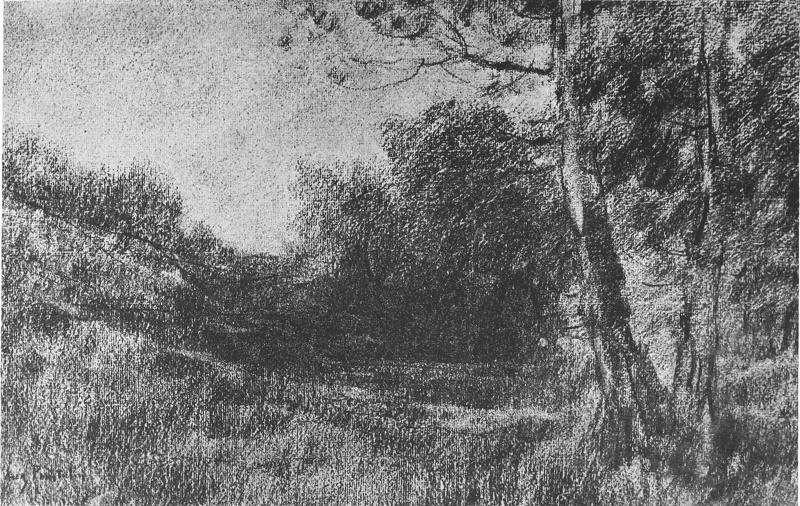
A GLADE IN THE WOOD · AUGUSTE POINTELIN
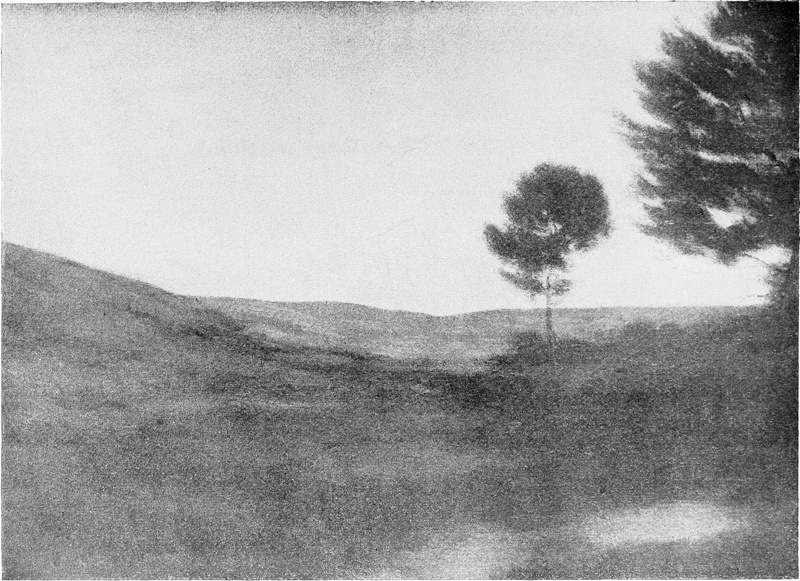
MOUNTAIN AND TREES · AUGUSTE POINTELIN
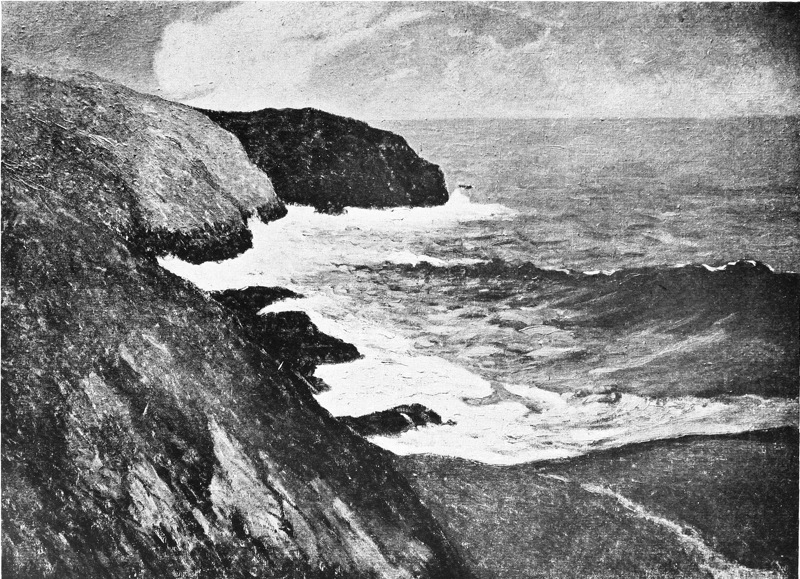
A ROCKY COAST · MAXIME MAUFRA
61Auguste Emmanuel Pointelin was born at Arbois, June 23, 1839, and the first art teaching he received was from the hands of M. Victor Maire. Success was long in coming, and for a livelihood he had to turn to several other professions, the chief being that of a mathematical professor.
Pointelin has received the usual honours France awards to her most distinguished citizens. He has been decorated with the Legion of Honour, is “Hors Concours” at the Salon, and received (amongst many other like trophies) the Gold Medals at the Exhibitions of 1889 and 1900. His work is to be found in many of the public galleries of the country, including the Luxembourg. The note of his art is a certain refinement and aloofness which is rarely found in contemporary Salons. Of him it may be said: “Through his brain, as through the last alembic, is distilled the refined essence of that thought which began with the gods, and which they left him to carry out.”
Some time ago the writer was painting by the edge of the Seine in company with Maxime Maufra, and the artist recounted the origins of his Impressionist tendencies. “I am directly influenced by Turner and Constable,” he said. “I admired and studied their works whenever it was possible during the time I spent as a commercial man in Liverpool twenty years ago. There is no doubt that Monet, Pissarro, and the others of that group, owe the greater part of their art to the genius of the great Englishmen, just as Delacroix and Manet were indebted in a previous generation.”
This testimony is interesting, as it comes from one of the leaders of the modern school of “La peinture claire,” the school of light, of life, and of movement. It is valuable in view of the fact that some of the artists who have profited most by the valuable example of our men of genius seem least inclined to acknowledge their debt. For instance, Pissarro writes: “I have read with great interest your article. I do not think, as you say, that the Impressionists are connected with the English school, for many reasons too long to develop here. It is true that Turner and Constable have been useful to us, as all painters of great talent have; but the base of our art is evidently of French tradition, our masters are Clouet, Nicolas Poussin, Claude Lorrain, the eighteenth century with Chardin, and 1830 with Corot.” This statement is somewhat at variance with facts as we know them, and does not agree with several letters from Pissarro in the writer’s possession previously quoted.
To attempt to record bright open-air effects, to struggle with all the thousand nuances of the atmosphere, the division of tones, the 62juxtaposition of colour, the general principles and technical practice adopted by the Impressionists, is to come under a ban. There is an old and well-beloved professor at the Beaux-Arts who taught the writer, a member of the Institute and Officer of the Legion of Honour, a man of much official influence, who, in a single phrase, has summed up the feeling of a large body in France with reference to the Impressionists. “They are a disgrace to French art,” he said bitterly. Such an irreconcilable attitude has compelled a section of the younger artists in France to adopt a style altogether opposite to that discussed in these pages, a reactionary manner in many cases opposed to their natural temperaments. They seek in Nature for the slightest cause which will give them reason for the use of black paint, forgetting that in a world charged with sun and iridescence the only absolute black that can be found is in the heart of a bean blossom, which is black only by the exclusion of the atmosphere. The slightest shadow they paint black, any dark piece of clothing is rendered in black. They have evolved a lugubrious funereal style and choice of subject which is sad, dull, inartistic, dyspeptic. This section of the art community has been named the “Nubians.”
Maxime Maufra is an adversary fighting this group of reactionaries, and perhaps his successful example may bring some of these erring ones back to the fold. He has the courage to paint in a light key, because he sees all nature in such a value, and by following the dictates of his artistic temperament he has become the exponent of a beautiful and personal art. He does not aspire to the position of a little Monet, but attempts to carry the master’s methods forward. Maufra maintains that Monet has by no means said the last word in Impressionism. Maufra and his friends are not content with the first illuminated corner presented by Nature, which, save for the sense of illumination, is probably uninteresting and ill-composed. They are equally attracted by beautiful rhythmic line, balance of form, by composition as well as by colour. The ethereal tints in nature which the pioneers were happy to reproduce, does not satisfy the younger men now that the fundamental laws of the Impressionists have been agreed upon.

AN ETCHING · MAXIME MAUFRA
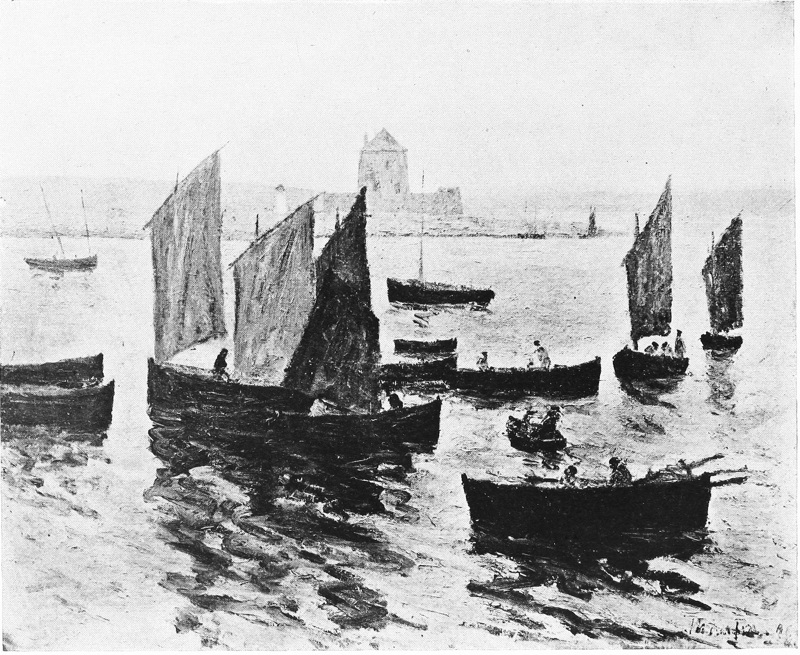
ARRIVAL OF THE FISHING BOATS AT CAMARET · MAXIME MAUFRA

MAXIME MAUFRA
Born at Nantes in 1861, the only regular art education Maxime Maufra received was from M. Le Roux, a local professor. His father, a man of business, decided that the son should follow the same vocation, much to the son’s disgust. After a few years of preliminary training Maufra was sent to Liverpool in order that he might acquire the language and further the commercial interests of his father’s house. Maufra studied English, more or less, and 63practised art, copying in the museums and private collections, and sketching in the neighbourhoods of New Brighton, Seacombe, and amongst the docks and shipping of the great port. Business was not neglected, but having effected a lucky “deal” which placed him in the possession of a little capital, he cut the cable which joined his life to commerce and sailed into the open sea of art. His family protested, his friends implored him not to take such a rash step. Maxime Maufra became a professional artist. For five years he toiled with his brush, working hard at every different method of technical expression, trying oils, water-colours, and the etching needle. Dealers did not come forward, buyers were never seen. At last, at the very end of his financial resources, he organised a tiny “one-man” show in Paris.
In the “Echo de Paris” M. Octave Mirbeau published a short criticism, which voiced the general opinion of Maufra’s talent. “Yesterday,” writes Mirbeau, “I entered the galleries of de Boutheville, where are exhibited about sixty works by Maufra. I was immediately conquered, for I found myself in the presence of an artist in full control of himself, who, after the necessary indecisions, the usual educational troubles, has realised that style is the most important thing—in fact, the joy of art.”
A few of the paintings were sold, enough to cover the expenses of the exhibition. A better luck awaited Maufra. M. Durand-Ruel casually glanced into the rooms before the close of the modest collection. He asked to see the artist. Maufra was in Brittany, and a telegram called him back to Paris. An interview followed in the Rue Lafitte between artist and dealer, and never since that day has Maufra known the anxieties of living on hope, for M. Durand-Ruel, with characteristic acumen, had arranged for his future.
In the spring of 1901, at the galleries of M. Durand-Ruel, Maxime Maufra organised his last and most successful exhibition, about fifty canvases executed in various mediums being shown. From the admirable preface written by M. Arsène Alexandre, one of the most perspicacious of French critics, the following lines may be quoted: “Maufra continues in the school of the Impressionists in this manner, that the point de départ in each of his pictures is in reality a quick and profound impression. He detaches himself from the school inasmuch as the realisation is a calculated and skilful art; and this is complete Impressionism.” A final quotation from the pen of M. Gabriel Mourey in “Le Grand Journal” aptly sums up the talent of this artist: “One could accuse Maufra 64at the time of his first exhibition at the de Boutheville galleries of submitting himself to the influence of Claude Monet. Already, however, he reveals his strong personality. Here he is to-day a free man and master of himself, capable of realising whatever his thoughts impel him to. He has his own conception of Nature, and he realises it with a liberty and independence which is veritably masterful. The diversity of his talent is proved in the most striking fashion. Scotland, Brittany, Normandy are evoked with an extraordinary facility, the different characteristics of these three countrysides, their special conditions, their peculiar atmosphere. They are like portraits in which a soul breathes, in which the blood runs beneath the skin, where the mystery of being is declared. The words of Flaubert’s St. Anthony come involuntarily to the lips before these pictures of Nature, sometimes savage, sometimes in a more tender mood: ‘There are some spots on earth so beautiful that one wishes to press Nature against one’s heart.’”
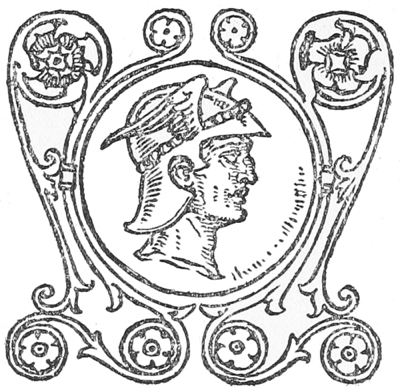
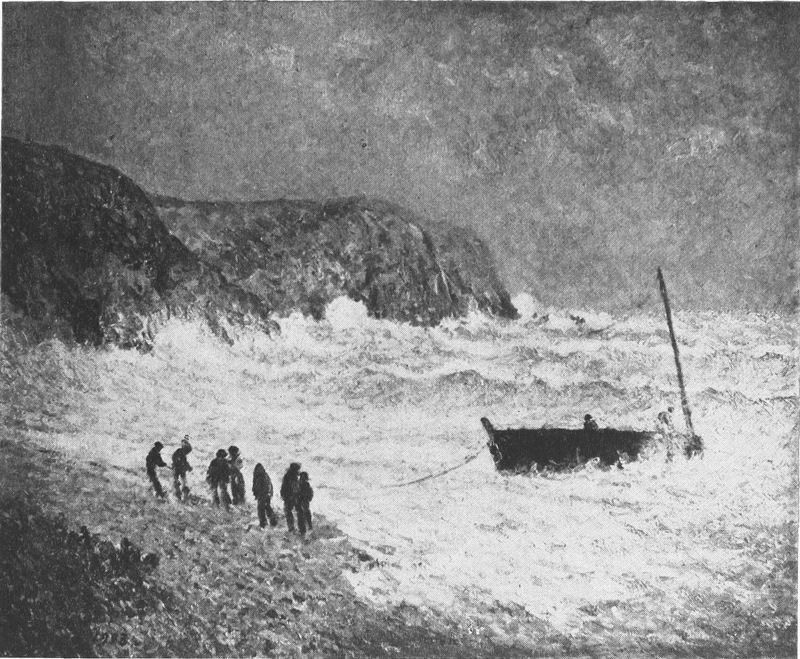
SHIPWRECK · MAXIME MAUFRA
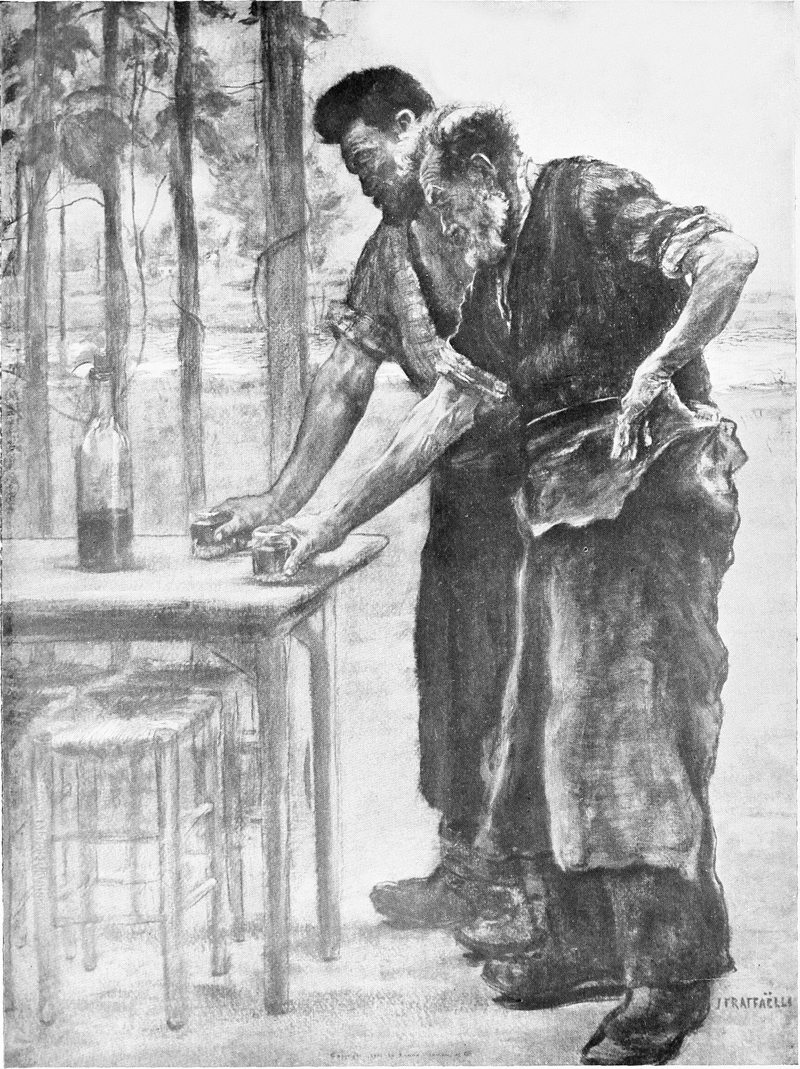
Photo by Braun, Clement & Co.
A GLASS OF GOOD RED WINE · J. F. RAFFAËLLI
“IL Y A SELON MOI, DEUX ÉLÉMENTS DANS UNE ŒUVRE: L’ÉLÉMENT RÉEL, QUI EST LA NATURE, ET L’ÉLÉMENT INDIVIDUEL, QUI EST L’HOMME”
ZOLA

JEAN FRANÇOIS RAFFAËLLI joined the Impressionist movement late, and did not commence to exhibit with the other members of the group until 1880, when he sent a canvas to the gallery in the Rue des Pyramides. He had clearly grasped the trend and scope of the idea, but cannot be classed altogether with the other members of the group as a “Luminarist.” This may be due to many causes apparent in his work. He is not a painter for the love of painting itself, and does not revel in colour for colour’s sake. He is no analyst of the shimmering effects of a summer’s sun. That side of Impressionism has never appealed to him. Yet his right to be numbered amongst them is assured, for, in spirit, he is one of the first of the school.
Raffaëlli is the historian of the “banlieue” of Paris. His street scenes are typical, life-like, and modern, and they will be treasured in future years as veritable documents of the daily existence of the great city. He wanders through the dreary “no man’s land” outside the fortifications, and transfers to his block the most vivid portraits of the nondescript characters who swarm through that gaunt wilderness. He is a man of much mental refinement, who has had to struggle for every inch of the artistic success which now surrounds him. Richly endowed by nature, he had no resources to fall back upon save his determination to conquer. In a few words M. Geffroy sums up the opening of this curious career.
Raffaëlli has had many employments, has been engaged in many trades, has searched the town for work. He has been in an office, has sung bass at the Théâtre Lyrique, has chanted psalms in a church choir, and at the same time painted under the tuition of Gérôme at the École des Beaux-Arts. He travelled through Europe, penetrating even so far as Algeria, working in each town as he stopped. Returning to Paris he exhibited landscapes founded upon the studies he had accumulated in his portfolio, some pictures of the Louis XIII. 66style, some portraits, a view of the Opera. Suddenly he opened his eyes to a sight nobody had seen before, disdained by the whole world, subjects which had never reached the dignity of an entrance in art circles. He became the recorder of the suburbs of Paris and their wandering inhabitants.
For years he experimented endeavouring to produce a medium best suited to his temperament. In the solid paint crayons we have an addition to the working tools of the artist which is of notable importance. This is not his only gift to France, for it is he who practically resuscitated the beautiful but dying art of etching in colours. In this work he was ably seconded by Miss Mary Cassatt. He is not only an artist but an actor, a musician, an orator, a sculptor, an etcher, a pastellist, an illustrator, and a man of letters. He is a fine example of the pioneer temperament. No sooner is success achieved in one branch of energy than he is in chase of another idea. One day he is trying to invent a perfect oil-crayon; the next, and colour etching is his sole ambition. He draws the elegant “mondaine” of the Boulevards, and then sallies out to study the frowsy denizens of the “banlieue.” In this quarter he found congenial subjects for a series of little masterpieces.
Amidst these wretched surroundings, warehouses, factories, wooden sheds ruinous and dilapidated, refuse heaps, brick-kilns, homes of the outcasts and cut-throats of the metropolis, Raffaëlli discovered a rich mine of material hitherto entirely unworked. The district is peculiar to Paris, and owes its existence to the clear half-mile of view required around the useless fortifications. This territory has, in mining phrase, been “jumped” by the penniless. Upon it squat the failures, the drunkards, the thieves, all the vicious under-life of the city. The artist revealed this world to the unsuspecting citizens. He lived in it, studied it day by day, and is a greater authority than the “sergots” upon the manners and customs of a neighbourhood which even the police shun. Such a blot upon the fair page of so magnificent a capital is rapidly being wiped away, but Raffaëlli has immortalised in his etchings and drawings some of the poetic atmosphere which enveloped these legions of the damned.
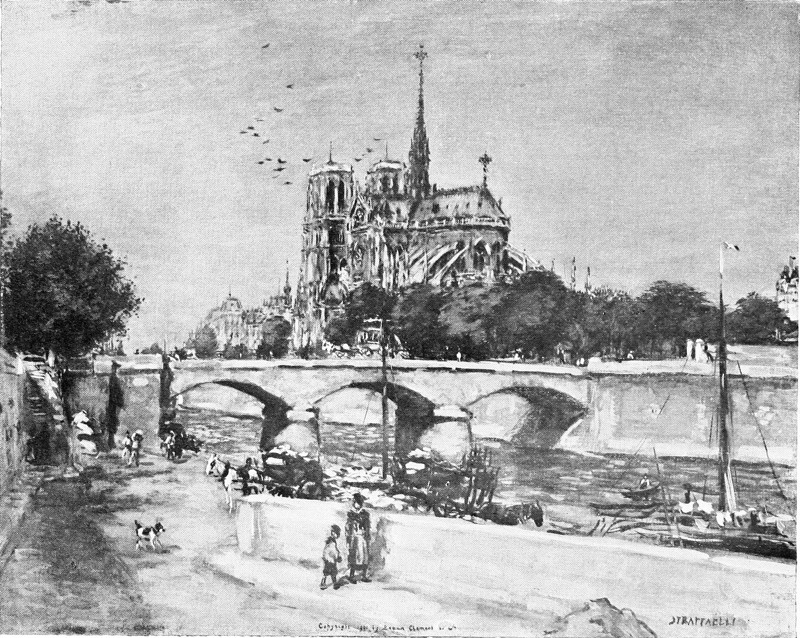
Photo by Braun, Clement & Co.
NOTRE DAME · J. F. RAFFAËLLI
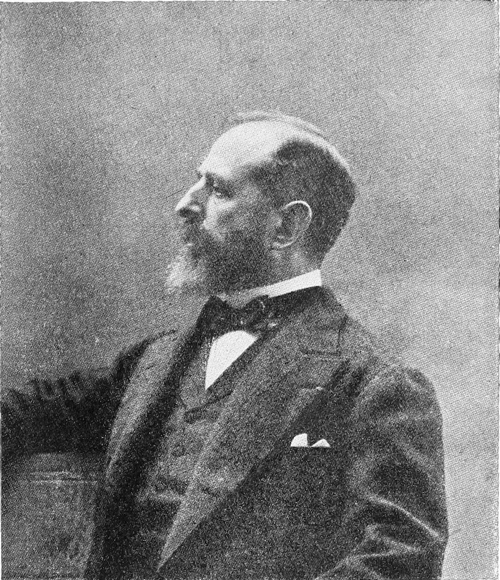
J. F. RAFFAËLLI
During the course of a long and strenuous career, Raffaëlli has received many decorations. He is of the Legion of Honour, besides having received numerous medals and awards from foreign exhibitions. He is represented adequately in the Luxembourg, and many continental galleries. He enjoys the admiration and friendship of a host of connoisseurs throughout the world. His studio is most pleasant. Facing the broad green sweeps of the boulevard 67by the fortifications, in the Rue de Courcelles, it occupies a large area on the ground floor, having been built over a spacious courtyard surrounded by banks of foliage and flowers. The predominant note is that of cheerfulness. The decoration is bright and restful, the ruling colours being delicate shades of yellow and blue. The usual theatrical adornments of a French studio are absent; there are no oriental carpets and rugs, no armour, no antique furniture, so dear to the heart of the Gallic painter. In this atelier the master holds periodical conferences, exhibitions, and friendly gatherings. Upon these occasions one will meet the cleverest men in Paris, for Raffaëlli is a celebrated conversationalist as well as a famous artist.
Degas has a temperament strangely different from that of Raffaëlli, and, although always classed with the Impressionists, he stands apart from the recognised group. He has never endeavoured to transmit the impression of atmosphere, and work “en plein air” does not attract him. He has, however, profited much by the teaching of the Impressionists, particularly in relation to the use of radiant colour, for at one time he painted in greys which were closely allied to black. He exhibited continually with the other men in the early days of the movement, and proved a genius both in suggestion and organisation.
Hilaire Germain Edgard Degas was born in Paris, July 19, 1834. He entered the École des Beaux-Arts in 1855, studying under Lamothe and also having Ingres for a master. He made his first appearance at the Salon of 1865 with a pastel entitled War in the Middle Ages. In 1866 he contributed the Steeplechase, the first of his series devoted to scenes of modern life. In 1867 he exhibited Family Portraits, in 1868 the portrait of a ballet-dancer, and during 1869 and 1870 some further portraits which closed his connection with official art, for he never sent contributions to the Salon again. In his early work he did not confine his brush to subjects of daily actuality, such compositions as Semiramis Building the Walls of Babylon and Spartan Youths Wrestling being far removed both in style and genre from later work. During the sixties his canvases were classical in spirit as well as in subject. He had a strong feeling for the Primitives together with Fra Angelico, and much of his work conveyed a reminiscence of Holbein. A Realist from the beginning, the Interior of an American Cotton-Broker’s Office, painted in 1860, shows that his temperament has never radically changed. This canvas, now in the museum at Pau, is minutely exact in all its details. It is Realism but emotionless, without atmosphere and lacking all feeling. 68It shows too that forty-three years ago the artist was acquiring that facility of hand which has placed him at the head of modern draughtsmen.
Degas exhibited in company with Manet, Monet, and the Impressionists generally, at five exhibitions, namely 1874, 1876, 1878, 1879 and 1880. In the last-named year he exhibited a series of portraits of criminals, and commenced to model figures of dancers in wax. In December 1884 he showed some racecourse scenes, and at the last exhibition of the Impressionists in 1886 exhibited studies of the nude, jockeys, washerwomen, and other characters of modern life. He has worked with the etcher’s needle, and also in lithography, his subjects being generally confined to theatrical life and incidents noticeable on the Parisian boulevards.
The characteristic of Degas personally is mystery. He now refuses to exhibit his works, he shuts his door to all visitors. Like most artists he detests writers, and there is a legend that he successfully grappled with one enterprising but unwelcome interviewer and dropped the unfortunate critic down a flight of stairs. This proves how thoroughly his principles are carried out in practice. “I think that literature has only done harm to art,” he said once to George Moore. “You puff out the artist with vanity, you inculcate the taste for notoriety, and that is all; you do not advance public taste by one jot. Notwithstanding all your scribbling it never was in a worse state than it is at present. You do not even help us to sell our pictures. A man buys a picture, not because he read an article in a newspaper, but because a friend, who he thinks knows something about pictures, told him it would be worth twice as much ten years hence as it is worth to-day.”
With these strong views one can understand the attitude of Degas to the art world in general. It was a very different attitude from that of Manet who gloried in the fight. “Do you remember,” Degas said once to George Moore (who quotes the conversation in his “Impressions and Opinions”), “how Manet used to turn on me when I wouldn’t send my pictures to the Salon? He would say, ‘You, Degas, you are above the level of the sea, but for my part, if I get into an omnibus and some one doesn’t say, “M. Manet, how are you, where are you going?” I am disappointed, for I know then that I am not famous.’” This conversation reveals in a curious manner the differing characters of the two men; Manet with that attractive vanity so often to be found in the artistic temperament, Degas, a satiric misanthrope analysing the degraded types which make up the gay life of Paris.
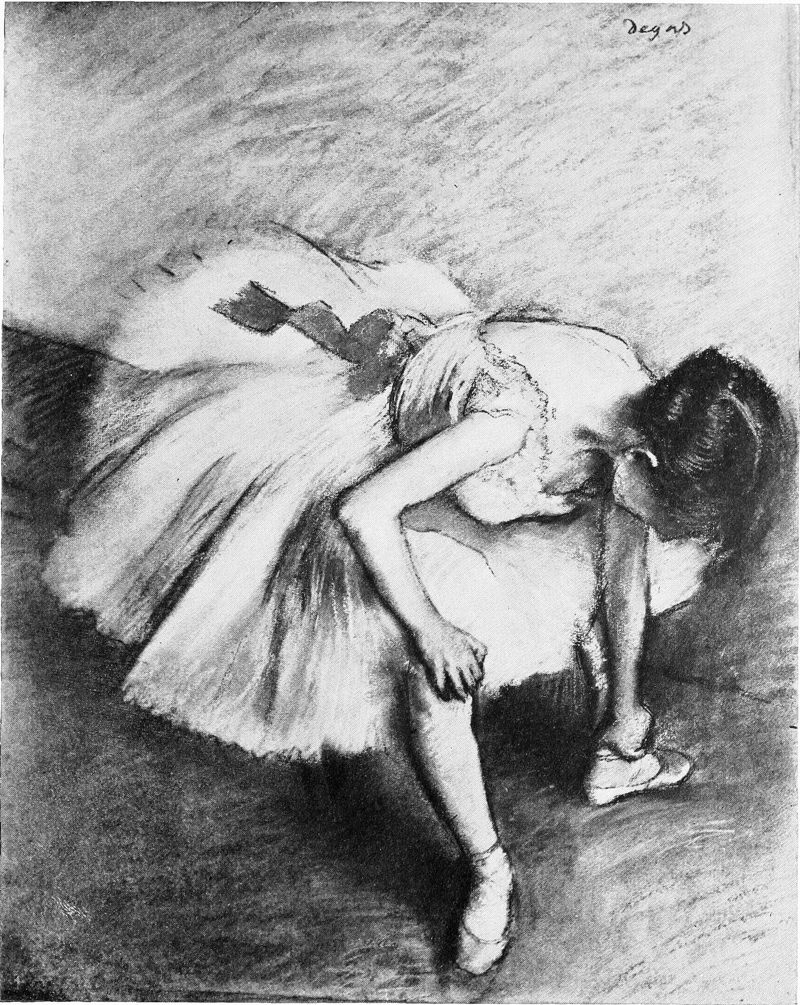
DANCING GIRL FASTENING HER SHOE · EDGAR DEGAS
69The work of Degas may be sorted into four main groups—the racing series, the theatrical studies, the drawings of the nude, and a few landscapes. From many points of view the scenes of the coulisses come first. Superb in draughtsmanship, they represent the life of the theatre in a way it has never been represented before. In one we see shivering girls rehearsing upon a cold cheerless stage lit by a few gas jets; in another the première danseuse quivering upon tiptoe amidst the frenzied plaudits of an excited audience. Degas reproduces the atmosphere with a marvellous precision, which only those engaged in the busy turmoil behind the curtain can fully judge. Upon these scènes de théâtre will rest his fame, for humankind is never likely to tire of such vivid renderings of a life always fascinating to the outside world.
Degas is not a countryman, and cannot be classed amongst sportsmen, or lovers of horseflesh. His jockeys and racehorses are highly extolled, but with animals he has not always succeeded. It is not sufficient to be a great artist in order to convey convincing impressions of sporting scenes. An artist must have the whole spirit of sport thoroughly engrained in his nature before he can properly represent it. Apart from the city, Degas is out of his element, and this is very apparent in the landscapes he has painted during the last eight years. The glamour of the fields and hedges does not touch his soul. Rural life he finds dull, and naturally his essays in landscape painting are somewhat painful. He has not the temperament which can faithfully interpret the poetry of the countryside, and is more at home in the purlieus of the opera or upon the asphalte of the boulevards.
Degas is a realist, and his subjects are for the most part exceedingly trivial in selection. After racehorses and ballet-dancers, he loves to depict buxom ladies of the lower classes engaged in personal ablution. It is extraordinary that the pupil of Ingres, the painter of La source, should create such appalling creatures. The most plausible apology comes from Mr. George Moore. The nude, he writes, has become well-nigh incapable of artistic treatment. Even the more naïve are beginning to see that the well-known nymph exhibiting her beauty by the borders of a stream can be endured no longer. Let the artist strive as he will, he will not escape the conventional; he is running an impossible race. Broad harmonies of colour are hardly to be thought of; the gracious mystery of human emotion is out of all question—he must rely on whatever measure of elegant drawing he can include in his delineation of arms, neck, and thigh; and who in sheer beauty has a new word to say? Since 70Gainsborough and Ingres, all have failed to infuse new life into the worn-out theme. But cynicism was the great means of eloquence of the Middle Ages; and with cynicism Degas has again rendered the nude an artistic possibility. The critic then describes these works in most sympathetic phrases. Three coarse women, middle-aged and deformed by toil, are perhaps the most wonderful. One sponges herself in a tin bath; another passes a rough nightdress over her lumpy shoulders, and the touching ugliness of this poor human creature goes straight to the heart. Then follows a long series conceived in the same spirit. “Hitherto,” says Degas, “the nude has always been represented in poses which presuppose an audience, but these women of mine are honest, simple folk, unconcerned by any other interests than those involved in their physical condition.” In another phrase he gives you his point of view, “it is as if you looked through a keyhole.”
Descendant of Poussin and Ingres (when Ingres fell down in the fit from which he never recovered, it was his pupil who carried him out of his studio), Degas worships drawing, and line is with him a cult. Japanese art has helped to mould his style, as it influenced many of the Impressionists. His oil-paintings, though for the most part correct in draughtsmanship, are frequently wiry and academic in technique. Colour was never his strong point, and it is in his pastels that we find the achievement of his life. In a masterly essay on this artist, Thèodore Duret writes: “Degas has proved once more that, with genius, subject is a secondary matter, merely its opportunity, one may say. It is out of itself, out of its inner consciousness, that the poetry and the beauty discovered in its production are drawn. His work will thus remain one of the most powerful, the most complete, and the most instinct with vitality amongst that of the masters of the nineteenth century.”
Of Degas personally little is known. He comes of an old bourgeoise family, and at one time it is said that he possessed considerable financial means, which he sacrificed in order to save a brother from financial disaster. Although seventy years of age he still works with excessive labour at the art over which he has gained such a mastery. Scorning wealth, publicity, and popularity, he lives a life of complete isolation, dispensing with friends, able to more than hold his own against enemies.
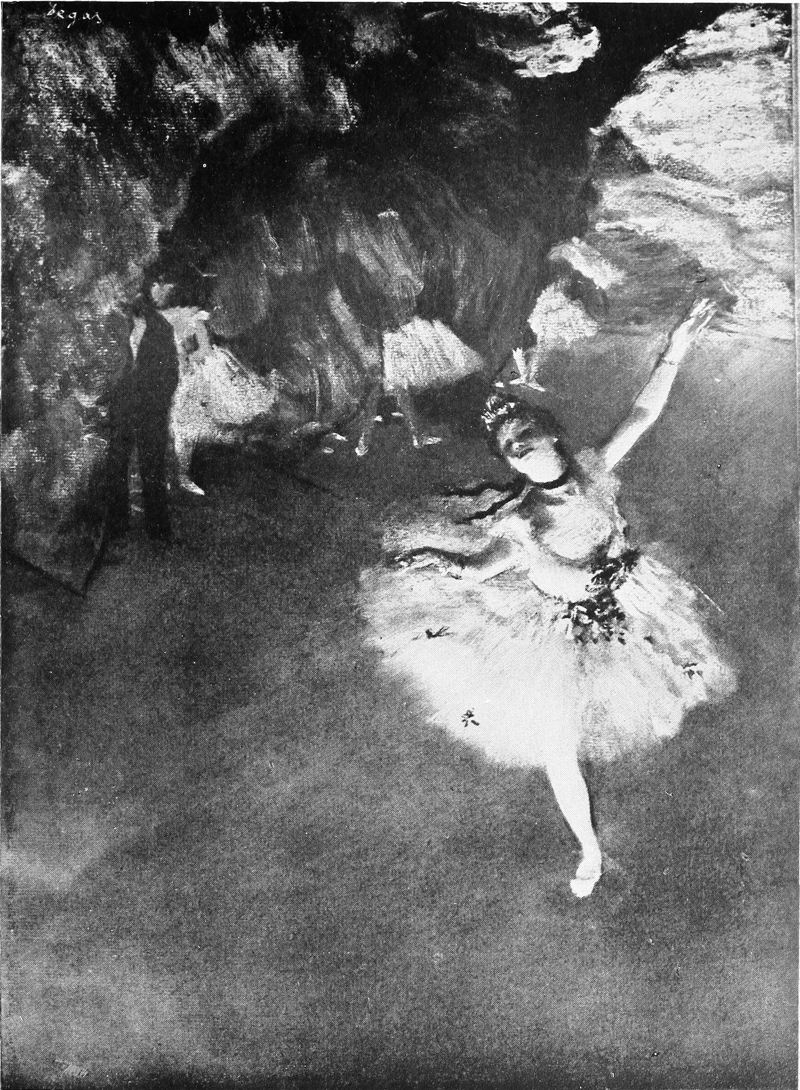
DANCING GIRL · E. DEGAS
He has had two pupils whose names stand out prominently in the art of to-day, the American artist Miss Mary Cassatt (referred to elsewhere in this volume) and the caricaturist Forain. Degas has always had a bitter wit, the dread of his contemporaries, and many 71of his sayings have passed into history. During the height of the battle which raged around the Impressionists during the seventies, he remarked concerning the academic painters and critics: “On nous fusille, mais on fouille nos poches,” or, in other words, “They cover us with injuries, yet they make use of our ideas.” In him Whistler met his match. “My dear friend,” he said once to that great artist, “you conduct yourself in life just as if you had no talent at all.” Upon another occasion, speaking of Whistler when the latter was having a number of photographic portraits taken, he observed sarcastically, “You cannot talk to him; he throws his cloak around him—and goes off to the photographer.” It was not likely that two such spirits would appreciate each other.
Degas is a pessimist. He has always been a realist, and the realist in this troubled world cannot look through rosy spectacles; acute pessimism becomes the natural result, especially when a great city is the venue. He is the analyst and ironist of the Impressionist group, with whom he has a sympathy of temperament rather than a sympathy of technique. At the present moment there are few artists better known in Paris, yet few who have received so small an amount of official acknowledgment. He has never received an official commission, has refused all decorations, his chief works are to be found in foreign countries. Yet an enthusiastic French critic has summed up the opinion of the art world of France in the striking phrase, “Degas is one of the greatest draughtsmen who have ever lived.”
Ten years ago, when the writer was a student in Paris, the name of Toulouse-Lautrec was known only in connection with various daring and flamboyant posters advertising the exotic attractions of the “Moulin Rouge” and the “Divan Japonais,” and also through extraordinary sketches which appeared from time to time in Aristide Bruant’s feuilleton “Le Mirliton.” Now and again one found a sketch, with his signature, pinned up in an artistic cabaret of the Batignolles quarter. Few had seen him, nobody seemed to have any wish to discover his whereabouts. In the studios he was almost invariably spoken of with contempt as half a fool. He was celebrated in a way, and yet unknown.
He was by no means a fool, for few men have possessed a brighter intellect. His semi-retirance and evident reluctance to appear amidst the crowd were partly owing to a temperament of ultra-refinement, and still more directly the result of a terrible personal misfortune. The story of his life is romantic.
Henri de Toulouse-Lautrec-Monfa was born in 1864 at Albi, a scion of an ancient and illustrious family. His father, the Count 72de Toulouse-Lautrec, was a wealthy country gentleman, of sporting tastes, a splendid horseman, a crack shot, a sculptor, and a person of most violent and impulsive temper. The son inherited many of his father’s qualities. Generations of ancestors accustomed to the beauties and refinements of such a life in the country had developed at last an artist of peculiar sensibilities. These natural gifts were carefully cultivated, and the boy became a professional artist, who, although he possessed gifts of the most extreme refinement, became through the irony of fate primarily famous amongst his countrymen as a designer of street posters and comic sketches. Those who knew him superficially could not comprehend how his delicate and extraordinary exterior could cover such excellent qualities of heart, such delicacy of spirit. He met with scant respect and few patrons. Happily he was not dependent upon his brush for the means of existence, and his works, when they sold, fetched but little. After his sad and untimely death, the most insignificant sketches were eagerly disputed for and changed hands at large prices.
Physically Toulouse-Lautrec was a weak man, of a highly-developed nervous temperament, with a brain too active for its frail tenement. To such a nature all excess proves fatal, although it is generally such natures that seek excess. In his infancy the artist had the unlucky mischance to break both his legs, and these, badly set, left him malformed for life, a dwarf. Thoroughly embittered, his proud and sensitive soul could not endure the inquisitive stares of the curious with which he was invariably greeted, and for the most part he lived a very solitary life. “Je suis une demi-bouteille,” he would often say to his friends in sarcastic reference to his own unhappy condition.

CAFÉ SCENE ON THE BOULEVARD MONTMARTRE · E. DEGAS
He drowned his griefs, as many have done before, keeping in his studio huge stocks of the most fiery spirits and liqueurs, from which he compounded wonderful “cocktails” for the benefit of himself and his friends. It is not surprising that first came the madhouse and then premature death completed this tragedy. Of an excitable temperament he found much pleasure in resorts such as the “Moulin Rouge.” Taverns, theatres, and the circus, found in him a constant patron. These were his schools; and hundreds, one may say thousands of sketches are the result of such teaching. He loved horses as his ancestors had done before him, and he studied their attitudes at the circus, sketching them in barbaric trappings and in eccentric poses. The smell of the sawdust always inspired him. The sketches here reproduced illustrate this phase of his career.
73M. Princeteau, the designer of sporting scenes, influenced Lautrec’s style, and became his intimate friend. Forain also counts for something in his development, whilst Pissarro and Renoir were frequent visitors to and critics of the young Impressionist. Perhaps of all men Degas inspired him most, and at times he undoubtedly copied the methods of that master. With serious study he had little to do. He worked in the atelier-Bonnat in 1883, and later on in the atelier-Cormont, where he continued the study of the nude; yet it was only after he had complete liberty and was entirely free from scholastic influence that his style began to form. Then his strong individuality displayed itself, and he became Toulouse-Lautrec as we know him.

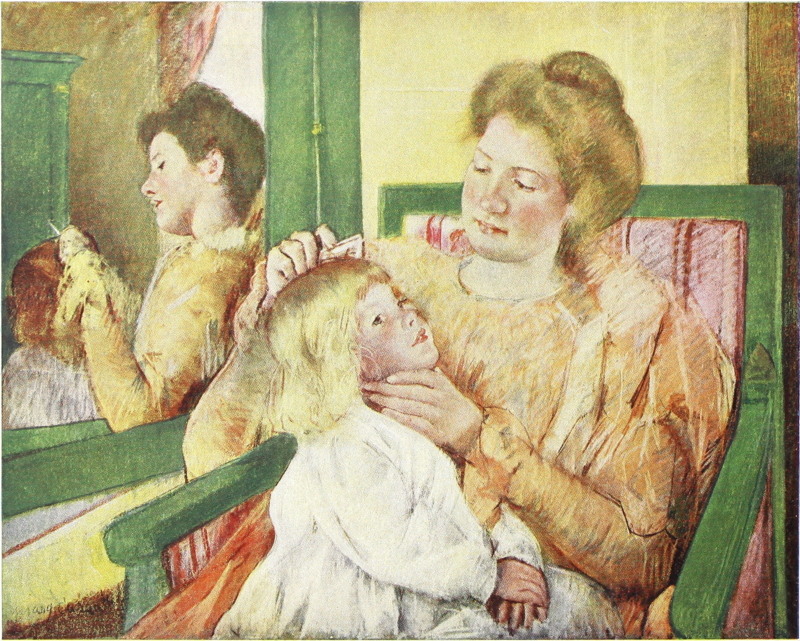
BABY’S TOILET · MARY CASSATT
“TOUTE TOILE QUI NE CONTIENT PAS UN TEMPÉRAMENT, EST UNE TOILE MORTE”
ZOLA

AMONGST the artists who contributed paintings to the eight exhibitions of the Impressionist group are four women, who were influenced by the new methods: Mdlle. Berthe Morisot, Madame Marie Bracquemond, Miss Mary Cassatt, and Mdlle. Eva Gonzalès.
The story of Berthe Morisot is romantic. She was the great grand-daughter of Fragonard, a famous beauty, a pupil of Manet, then the wife of his brother Eugène. Her position in the art world of France was unique, and her death at the early age of fifty in 1895 cut short a career devoted to a most charming and delicate style. She excelled above all in two branches of her art—an exquisite draughtsmanship and a most luminous and poetic sense of colour. Technical difficulties never discouraged her. She was one of those rare and fortunate individuals who can intuitively surmount any problem and consequently hardly require a teacher. Madame Eugène Manet was an artist to her finger-tips. Her work is charged with a feminine charm sympathetic to the temperament of any painter. Her canvases are iridescent poems in paint, and she possessed many qualities in common with her illustrious ancestor. “Only one woman created a style,” wrote the novelist George Moore (who, it may be remembered, had a close acquaintanceship with many of the Impressionists), “and that woman is Madame Morisot. Her pictures are the only pictures painted by a woman that could not be destroyed without creating a blank, a hiatus in the history of art.” She was a woman of great personality and charm, and took an active part in the furtherance of the movement which was initiated by her brother-in-law. “My sister-in-law would not have existed without me,” said Manet one day in the Rue d’Amsterdam to George Moore, and the latter adds, “True, indeed, that she would not have existed without him; and yet she has something that he has not—the charm of an exquisite feminine 76fancy, the charm of her sex. Madame Morisot is the eighteenth century quick with the nineteenth; she is in the nineteenth turning her eyes regretfully looking back on the eighteenth.”
Miss Mary Cassatt is an American subject. She was born at Pittsburg, studied at the Philadelphia Academy, and then, after some work with Degas, became an accomplished painter of children and the varied scenes of maternity. A pastellist of note, with Raffaëlli she succeeded in resuscitating the moribund art of etching in colour. Miss Cassatt’s work shows evidence upon every side of unwearying years of effort. Its dominant character is strength, and, with the single exception of Berthe Morisot, the artist is probably one of the most virile woman painters the world has seen. Strength is decidedly not the keynote of any of the works of Angelica Kauffmann, Madame Lebrun, or even of the many women who exhibit to-day, although they display other qualities worthy of praise. Miss Cassatt has experimented in numerous directions, has often tried to express herself in a fresh way. She has succeeded. Her draughtsmanship is exceptionally firm, and her colour bright, pure, and harmonious. She has worked in oil, charcoal, water-colour, pastel, and etching, and has remained faithful to the inspiration of her master Degas, and through him to the art of Japan.
The pastel drawing here reproduced is one of an extensive series devoted to scenes from maternal life. Although from the nature of things all such reproductions fall far short of the original, still a good idea is conveyed of technique and composition. Miss Mary Cassatt, it may be added, has travelled a great deal in search of subject inspiration, and is the friend of the older members of the original group of French Impressionists, to which she is allied by sympathy and the work of a lifetime.
Madame Marie Bracquemond was also an “Impressioniste,” and joined ardently in the movement. At first following the example of Ingres, her first teacher, she received the most valuable help from her husband, an engraver of the rarest talent. The field of her art ranges from a colossal decorative panel (those exhibited in the Paris Exhibition of 1878 were about twenty-one feet by nine feet in size) to a most delicate little etching. It may be understood that mere physical labour did not appal her, for the Exhibition panels required assiduous and heavy toil.
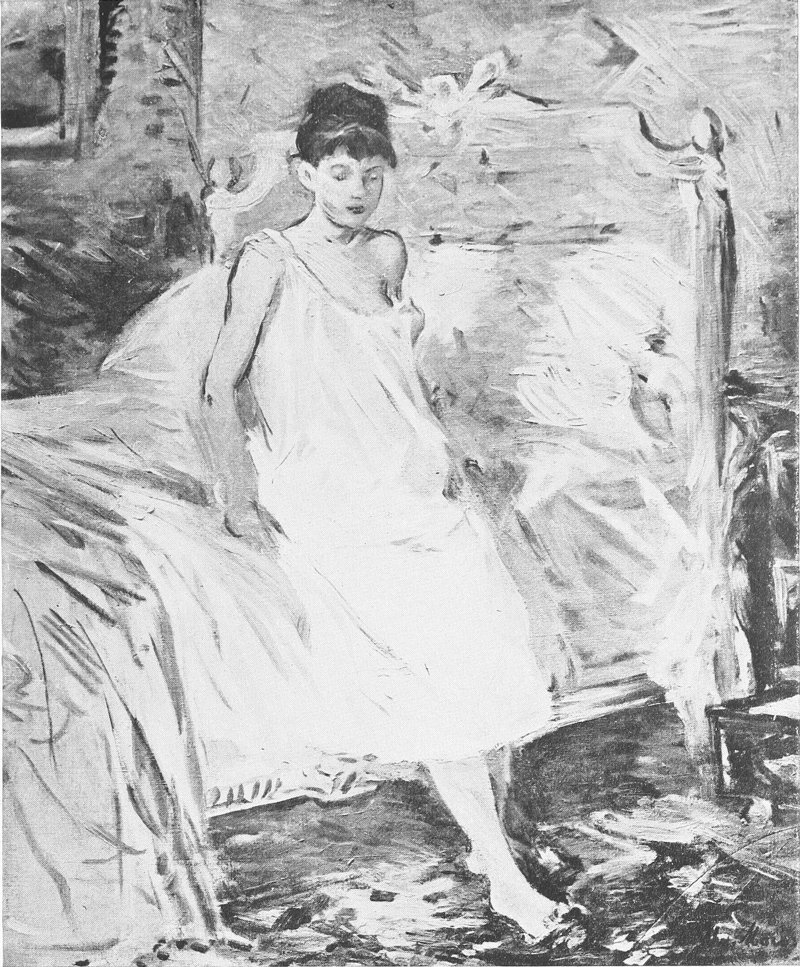
LE LEVER · BERTHE MORISOT
Of Eva Gonzalès there is, unfortunately, little to be said. At first taught by Chaplin, she became the favourite pupil of Edouard Manet, and commenced to display much talent as a pastellist. She married Henri Guérard, the engraver, but death ended at an untimely 77age a career of great promise. In the Luxembourg gallery she is represented by a pastel drawing.
It has been often said that in art women cannot create: they can only assimilate and reproduce. In one sense this is true both of Berthe Morisot and Mary Cassatt, the two principal figures in this tiny feminine group. The first was profoundly influenced by her brother-in-law Manet, the second by her teacher Degas. Marie Bracquemond and Eva Gonzalès married husbands in the practice of their art.
But these women introduced into the stern methods of the early Impressionists a feminine gaiety and charm which were reflected upon the canvases of their “confrères,” and produced a certain change of attitude. There was little light-heartedness in the work of Manet before these women-painters joined the group, and it is not altogether improbable that some of the change is due to their example. In any body of men feminine influence always makes for the good, and these women, of strong but charming personality, must (it is idle to write any less emphatic word) have had a strong influence upon the whole group. Their industry was great, for they exhibited almost without intermission from 1874 to 1886. At times their talent touches genius, and for future historians they will prove an interesting study. Modernity is the note of Impressionism, and that movement was the very first artistic revolt in which women took a prominent part.
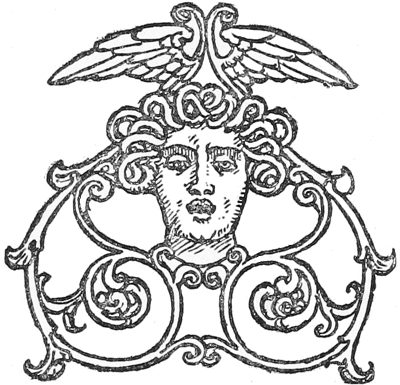

THE LAST RAYS · EMILE CLAUS
“TOUT HOMME QUI NE RESSEMBLE PAS AUX AUTRES, DEVIENT PAR LA MÊME UN OBJET DE DÉFIANCE. DÈS QUE LA FOULE NE COMPREND PLUS, ELLE RIT. IL FAUT TOUTE UNE ÉDUCATION POUR FAIRE ACCEPTER LE GÉNIE”
ZOLA

THE work of Emile Claus is a manifestation in quite another direction of the Impressionist idea. Born in Western Flanders in 1849, he was the sixteenth child of parents in very humble circumstances. Their business in life was to supply with provisions the boatmen who passed along on the river Lys. By various means the boy, who had very early displayed a yearning for the painter’s career, managed to evade all attempts to harness him in the drudgery of the home life. A pastrycook, a railway watchman, a linendraper’s assistant, these were a few of the vocations he was condemned to try, yet from which he escaped. At last he set out for Antwerp, with £7 in his pocket, and the warning that he need not expect a penny more. In the city of Rubens he became a free pupil of Professor de Keyser. All day long he studied in the Academy. When night came he earned a livelihood by giving drawing-lessons, acting as a sculptor’s “devil,” and colouring pictures of the Stations of the Cross. At last, after many struggles, he became a popular portrait-painter in the city, particularly of children in fancy costume. In 1879 he travelled through Spain and Morocco, painting the conventional compositions of an Iberian tour, and much influenced by the style of Charles Verlat. Despite his great success in Antwerp, in 1883 Emile Claus changed his manner entirely. He shook off the dust of the city for ever, renounced portrait-painting, and became “paysagiste.” Impelled by an intense love of nature he returned to his native village on the banks of the Lys, and recommenced his life as a landscape painter “en plein air.” He has never returned to the distracting turmoil of town, and, in his quaint white and green shuttered house at Astene between Ghent and Courtrai, has buried himself in the heart of the country. Although some distance from the larger cities of Belgium, Emile Claus does not vegetate in his obscurity. On wheel or a-foot he is equally active, visiting his friends and working on his canvases, 80of which he has always some six or eight in progress. It may be noted that he works entirely in the open air, and finishes in front of nature. One might judge of this from the strength and completeness of his pictures.
It is years since the writer first saw a landscape by Claus, and he remembers vividly the pleasure it gave. The painting was in the well-known collection of Mr. John Maddocks, of Bradford. Upon a huge canvas the artist had depicted a cornfield ripe for the sickle, and in the midst of the wheat red poppies grew. Across the foreground, emerging from the wheat, wandered a few white ducks. Over the whole was the fierce glare of a noon-day sun. The work was convincing, naturalistic, yet poetic, inasmuch as it seemed to chant the universal hymn of nature. It was a revelation to those artists who found themselves in Bradford at that period. Unknown and a stranger, Claus received in spirit silent congratulations for his splendid achievement, which aroused in several breasts a keen feeling of emulation. The artist writes: “Mr. Maddocks has always strongly encouraged me, and had the courage to buy my work at a time when everybody in Belgium found me by far too audacious, because, as you may know, the leaders, the standard-bearers as it were, of the young Belgian school of painting are not at all in sympathy with the beautiful art of Monet and his school.” Since that day Emile Claus has greatly increased his following throughout the world, being least appreciated in his own country.
Emile Claus is a painter whose brush is charged with the sweetness of life, courageous, healthful, and buoyant. His pictures breathe of sunlight and fresh air, and it is easy to see with what sheer delight he throws himself into his work. When one seeks for the reason which so suddenly changed this prosaic painter of the Antwerp bourgeois into an Impressionist of the most modern school, one discovers the usual cause, the Englishmen of the commencement of the last century. In a recent letter to the writer, Emile Claus says that in England, above all other countries, were born light and life in painting. “I have all too quickly glanced at the Turners and Constables of London, nevertheless it was a revelation to me, and those great artists Monet, Sisley, and Pissarro continue simply what that giant Turner discovered; just as the grand epoch of Rousseau, Millet, Dupré, and Corot, passed over Belgium to find their inspiration in the marvellous works of the Dutch school.”
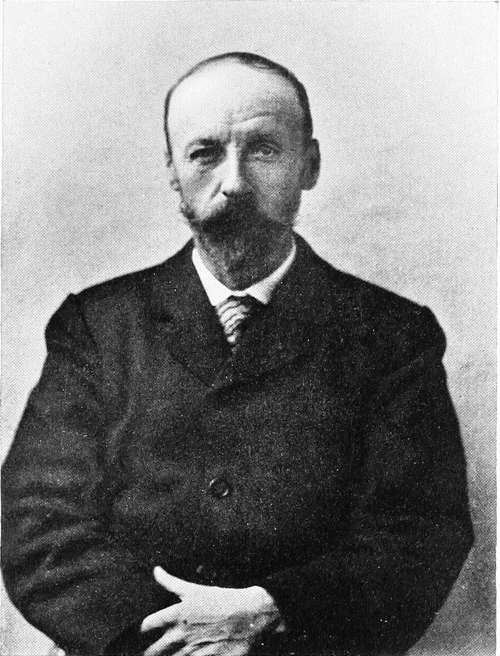
EMILE CLAUS
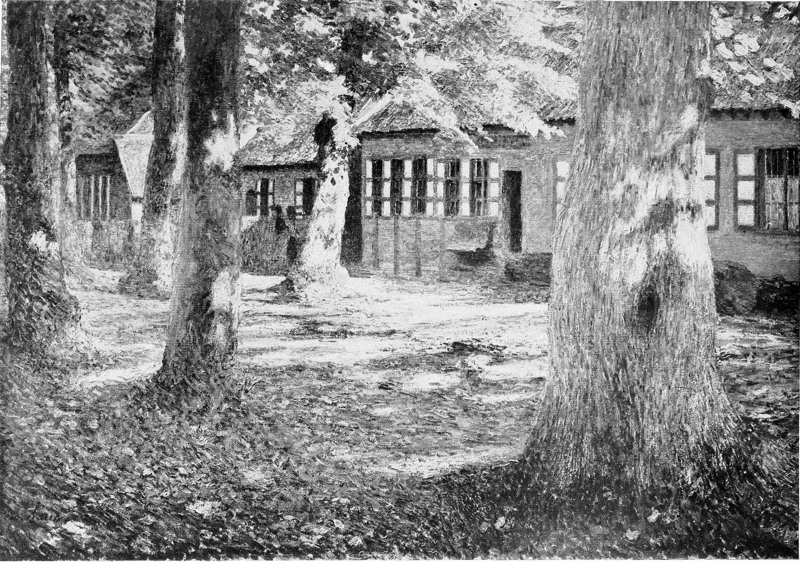
THE VILLAGE STREET · EMILE CLAUS
In the country of the Lys the artist continues to work, producing a series of pictures as beautiful as they are uncommon. One may 81mention his magnificent Flemish Farm of 1883, the Old Gardener of 1887 now in the Liége gallery, the canvas in the Antwerp gallery, and the fine work by which he is represented in the Luxembourg. Charming in colour, they will be found broad in manner, and perfectly original in sentiment.
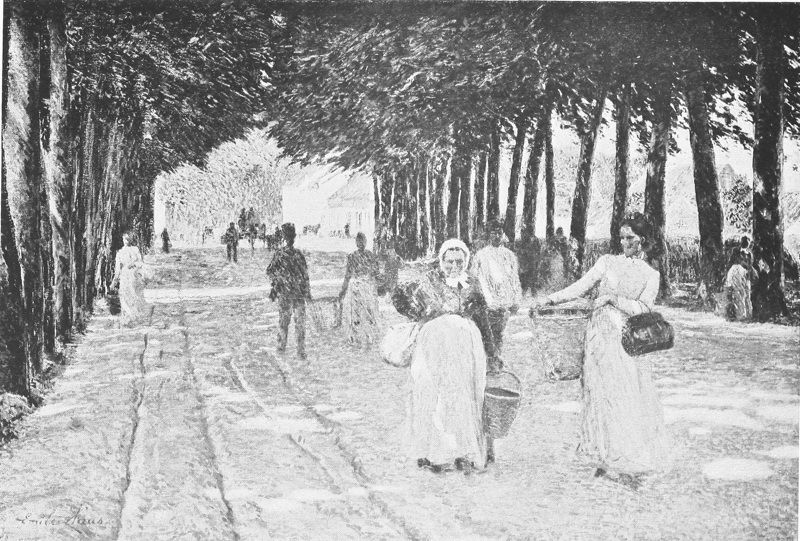
RETURNING FROM MARKET · EMILE CLAUS

GOLDEN AUTUMN · EMILE CLAUS
In 1891, Claus exhibited for the first time in the Champ de Mars, and has contributed each year from that date. His technical skill grows steadily. M. Gabriel Mourey, staunch supporter of “La peinture claire,” contributed a most sympathetic article to the “Studio,” in which he wrote, “In the old days, Claus was accused of being an ‘Impressionist,’ and such he is to a certain degree just as any one may be without disrespect to the glorious traditions of the painter’s art. He is an Impressionist to this extent—that he possesses the gift of feeling with the utmost keenness the true meaning of Nature in all her manifestations; while he is bound by no rule, subject to no formula, in his endeavour to interpret that meaning on his canvas. But, unlike most Impressionists, he has the rare capacity to know how to choose his impressions, to test them to the uttermost, and never to rest until he has translated them to his full satisfaction, disdaining the haphazard attempts which are sufficient for the majority of modern landscapists. Impressionist! One need feel no surprise that the superficial observer dubs him thus; for nowadays every painter whose work is luminous and bright, and devoid of bitumen, earns and deserves the title! The truth is that Claus, without adapting his style to any special method, is mainly concerned that his works shall be as full of atmosphere as possible, that his touch shall be as free and his colour as pure as he can make them. Thus he achieves that remarkable freshness of tint, that brightness of colouring, which constitute one of the chief charms of his art.”
The little house near Astene is called in Flemish “Zonnenschyn”—“Sunshine,” and it is indeed sunshine which is predominant in the work of Emile Claus.
Le Sidaner is an artist, who, after having passed through several antagonistic stages, has developed a style entirely his own. He may be described as a mystic who views the world with an air of detachment, standing aloof from the distractions of its inhabitants. He prefers an environment breathing some vague and undefined sorrow. The joy of life does not course through his veins. The subjects which appeal most to him suggest renunciation and world-weariness, the solemn peace of a Flemish béguinage, a cobbled street in Bruges recalling dead glories, a deserted canal with a solitary swan. When he designs a figure-composition the subject belongs 82to the same genre, a priest administering extreme unction to a dying girl, orphans under the care of a nun, old women waiting with the patience of extreme old age for Death to release them from their suffering senility. He instils into his canvases the very essence of Keats’ line, “Sorrow more beautiful than beauty’s self.”
The only biographical account of Le Sidaner is to be found in one of M. Gabriel Mourey’s penetrating articles in the “Studio.” Le Sidaner was the son of fisherfolk from St. Malo and the Ile Bréhat. He was born in 1862, and spent the first ten years of his life in his native place, the Ile Maurice. “While quite young,” says the writer of the preface to the catalogue of an exhibition held in 1897, “he came to live in Dunkirk, beside the murmuring North Sea, with its melancholy mists. The shock he felt at the change made him absolutely pensive. It was as though, half alarmed, he was taking refuge within himself the better to express the flame of Creole tenderness which burned within him.” His father, who practised painting and sculpture as an amateur, gave the boy every encouragement. At fifteen he was taken away from school, and sent to the local École des Beaux-Arts. Here he studied under a master who was slave to the doctrines of the Antwerp school.
The artist, when telling his early experiences, deplored these evil influences. He admits that they were not worse than those forced upon him in Paris, where, at the École des Beaux-Arts, he studied under Cabanel. Five years he spent under that master, making sketches of the animals at the Jardin des Plantes, and copying Delacroix and Jordaens at the Louvre. Then he passed under the influence of Impressionism. He says: “It was in this year (1881) that Manet displayed his portraits of Pertuiset, le tueur de lions, and of Rochefort. The first of these pleased me infinitely, but the second gradually filled me with alarm; it was so different from that which I had hitherto seen. Nevertheless, I remember well that the famous Bar des Folies-Bergère by this same Manet made the profoundest impression on me. Yet the rules of the school forbade me to consider all this as beautiful as I could have wished to consider it. When I look back on those days it really seems as though I was poisoned. Etaples, that is to say Nature, revived me, and drove the drug from my system.”
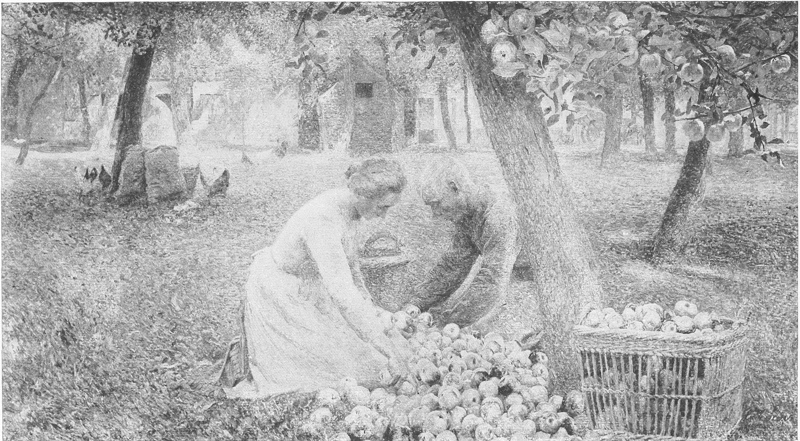
APPLE GATHERING · EMILE CLAUS
Le Sidaner goes on to tell how by chance he spent a holiday at Etaples in 1881. He settled there, and remained in the little coast town from 1884 to 1893, where he made friendships with Eugène Vail, Thaulow, Henri Duhem, Alexander Harrison, and others. He refers to a visit to Holland, where Rembrandt, Peter de Hoogh, 83and Vermeer enchanted him. Having gained a third medal at the Salon des Champs-Élysées he was able to travel to Italy. “Italy simply turned my head, particularly Florence. Oh! the delicious hours I spent in the Convent of San Marco copying the face of the Virgin in Fra Angelico’s Annunciation. How much I preferred the simple grace of Fra Angelico and Giotto to the cleverness and skill of Titian, Veronese, and Tintoretto.” It was hardly necessary to have avowed these influences, they are so evident in the work of Le Sidaner.
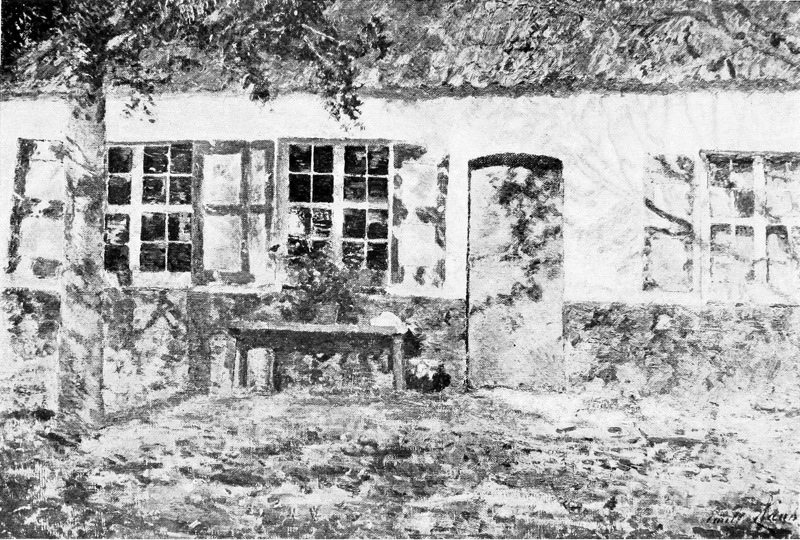
A SUNLIT HOUSE · EMILE CLAUS
He is a man who avoids crowds and the distracting clamour of humanity, loving to work in such dead cities as Bruges, or the peaceful countryside in the neighbourhood of Beauvais. No modern artist has better expressed on canvas the words of the great Millet. “When you paint a picture, whether the subject be a house, a plain, the ocean, or the sky, remember always the presence of man. Think how his joys and sorrows have been intermixed in these landscapes. An inner voice speaks of his inquietude and turmoils. Humanity’s whole existence is conjured up. In painting a landscape think of man.”
Le Sidaner has many affinities to Pointelin, Carrière, and Whistler. They each have sought harmonies of line and colour, and though distinct in personality and unlike in methods, they have produced wonderfully similar effects. One of the most impressive of Le Sidaner’s works is La Table in the Luxembourg. Here is the unmistakable Impressionist technique. In the courtyard of a country house is spread a table, white with napery, upon which stands a glowing opalescent lamp. A calm summer moon diffuses a gentle light over the whole scene. No human figures disturb the peaceful atmosphere, yet the sentiment of their presence pervades the place. The painting is a little masterpiece of its kind. The first canvas exhibited at the Champs-Élysées in 1887 was entitled After Church. Since that time he has exhibited year after year, the subjects of his pictures being well explained by their French titles: La Promenade des Orphelines, Communion in Extremis, Benediction de la Mer (1891), Jeune fille Hollandaise (1892), L’autel des Orphelines (1893), Départ de Tobie (1894), Les Promis, and Les Vieilles (1895). In 1900 he exhibited a notable collection of pictures of Bruges.
Le Sidaner paints a world of dreams. No better description of his work can be found than in the words of Moore:
84English readers and artists have hardly yet made the acquaintance of Besnard. To continental art-lovers he has long been known as the strongest and most audacious of the young men in the movement, and is thoroughly Impressionist in his ideas and methods. Few living artists have had the good fortune to be so much discussed as M. Besnard. Each Salon brings its chorus of admiration, its storm of disapprobation. The height of the argument was reached a few years ago, when, at the New Salon, the artist exhibited his Ponies worried by Flies. A startling piece of colour, it created a strong impression upon those who saw it. At that moment the existence of the violet tints in nature, which had been so beautifully demonstrated by Monet in his series of Les Cathédrales and by Sisley in his charming river studies, was much under discussion in the studios. In some of the works of Monet and Sisley the whole picture is saturated in a glow of violet, which is frequently to be found in nature, particularly in northern France. Those who had not seen this natural effect disbelieved in its existence and charged the artists with painting “de chic.” Those who had seen it and essayed the difficult task of reproducing it upon canvas, loudly proclaimed its truths. Then came the Ponies worried by Flies. Besnard had heard of the heated discussion raging round the violet tints, and, having observed the truth of the effect, determined to demonstrate it in paint. Never had been seen in any Salon such a blaze of colour as this. The composition seemed to be but a peg upon which to hang a sermon in technique. Violet, violent in colour, pure hot impasto as shadow, juxtaposed directly to its natural complement of light in the shape of orange and citron colours, brilliantly loud and unadulterated. A sensation was created, and disbelief in the existence of violet tints in nature for ever silenced. M. Besnard has followed this success with many other surprising themes, for it is his pleasure to amaze. He seeks incessantly the new and incongruous.
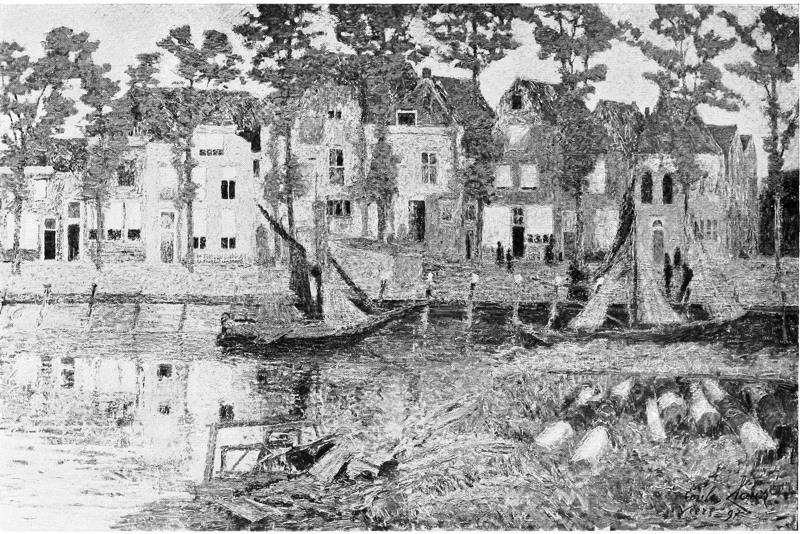
THE QUAY AT VEERE · EMILE CLAUS
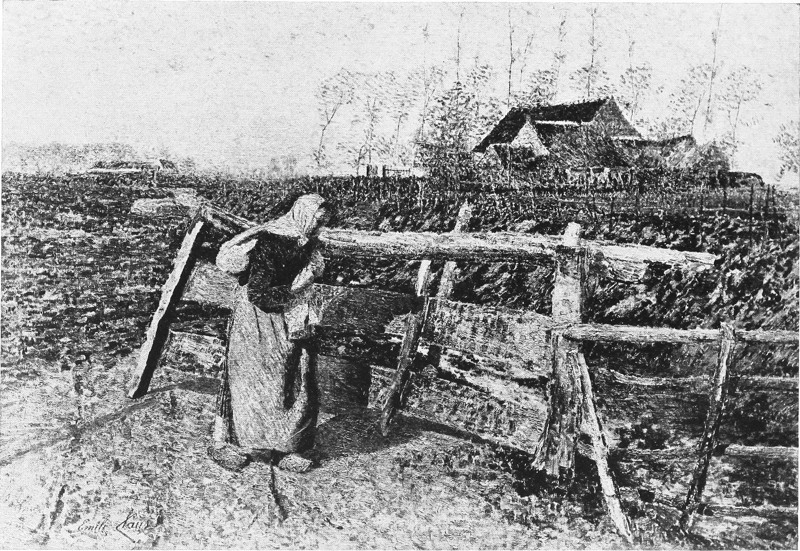
THE BARRIER · EMILE CLAUS
Besnard’s talent has been, and continues to be, publicly recognised. The municipality of Paris yearly expends large sums of money in securing the best available skill for decorating the public buildings in its charge. In this laudable custom it is followed by every town of any importance throughout the country. Lavishly patronised by the Government, the municipalities, wealthy private collectors, and the sentiment of the people generally, artists thrive in France and multiply. In whatever respect—if any—in which France may be found lagging behind the nations, in Art she must by the very reason of things remain supreme, for Art is a part of her daily life. Besnard 85has been lucky with his commissions. He was called upon to assist in the decoration of the magnificent Hôtel de Ville of Paris, in the Town Hall of the First Arrondissement, in the lecture hall of the Sorbonne, and with the frescoes in the School of Pharmacy. In all these decorations one finds colour and composition as original as bizarre, harmonious yet forcible. All students of modern painting should not fail to see these works, the most striking in execution of the last few years. The artist’s atelier is also always open to connoisseurs, and it will be found to be crowded with sketches and pictures in progress, each one unmistakably the handiwork of a master craftsman.
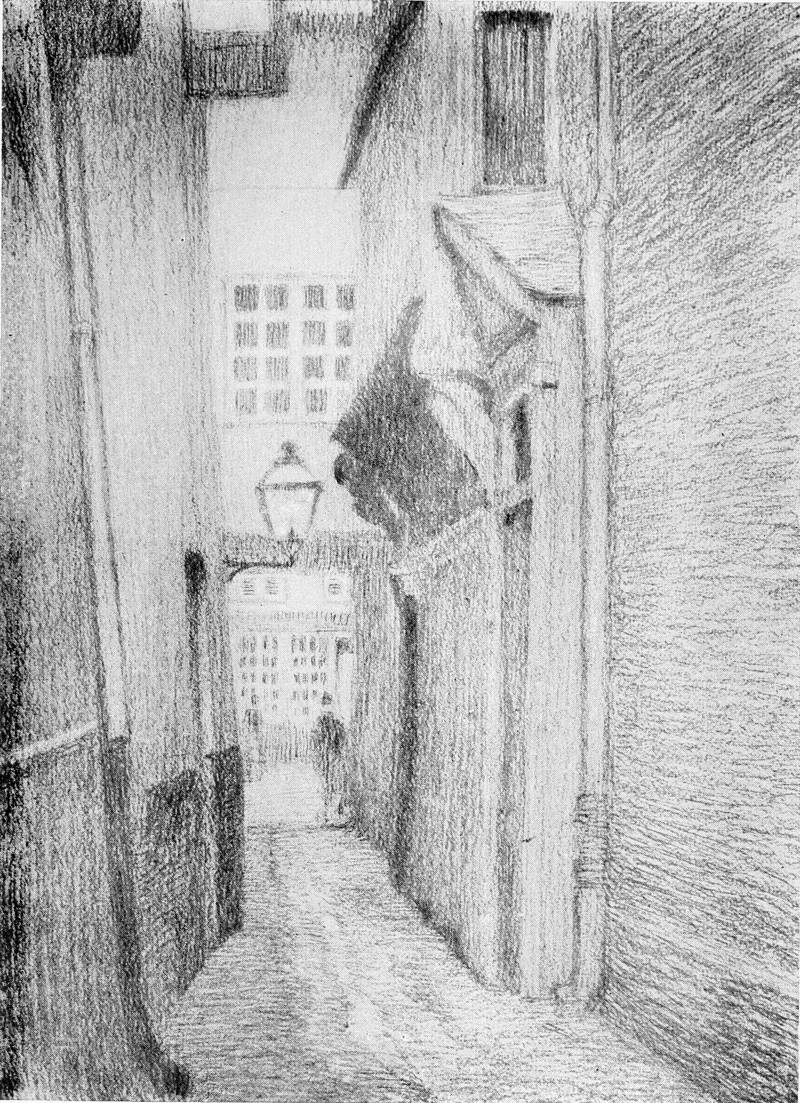
AN ALLEY · HENRI LE SIDANER

THE TABLE · HENRI LE SIDANER
Five of Besnard’s canvases have been bought by the Government, and all are now to be found in the Luxembourg, an honour few artists can boast of. A list is given for reference. The first of the series is a portrait of the artist, the others being entitled Femme qui se chauffe, La Morte, Port d’Alger au Crépuscule, and Entre deux Rayons. The second and third are excellent examples of a branch of art in which Besnard is supreme. His nudes and portraits are wonderfully fine in drawing, and bewitching in colour. They will form his greatest claim to future immortality.
Besnard is a particularly sympathetic lover of horses, and no one can more naturally reproduce them in paint than he. His chief recreation is driving, and he is often to be seen “tooling” along the roads of the Bois de Boulogne and other suburbs of Paris. There is little to add personally about Albert Paul Besnard. He was born in Paris, married Mdlle. Dubray, a sculptor of much talent, and resides in the Rue Guillaume Tell. His career has been a continued series of success upon success, and at the present moment he is one of the shining stars of contemporary art in France.
Allied to the later phase of the Impressionist movement, although not actually identified with the group of artists known as the typical Impressionists, is Didier-Pouget. His habitual manner of regarding Nature, his pure and cheerful colours, and his natural temperament, include him in this survey of workers in “la peinture claire.” He has a special gift of composition, “mise en plan,” as the French say, a strong feeling for balance and form. He is at his best when depicting morning and sunset effects. His scenes of heather bathed in sunshine or glistening with the dew of an autumnal sunrise are rendered with an exceptional verisimilitude, strength, and truth.
Didier-Pouget was born at Toulouse in 1864, the son of the editor of one of the local journals. His father, a great lover of 86Nature, gave the boy every encouragement in his ambition to become an artist. It was the custom of father and son to take long country walks, and the elder would point out natural beauties and discuss the methods of their pictorial representation, relating at the same time biographical details of the great artists, and in every way endeavouring to train the child and sustain his ideals. After Didier-Pouget had passed through a plain schooling, professors were engaged, notably MM. Auguin and Baudit. For the latter (a local artist of genius, who, had he forsaken the quieter life of the provinces for the glare of Parisian publicity, should have attained to the highest honours an artist can reach) his old pupil has still much admiration. Then Didier-Pouget passed into the studio of Lalanne, the celebrated etcher and illustrator. Under these influences many profitable years were spent, the seed-time of a most fruitful career.
Locally the youth was regarded as a prodigy of talent, and great things were expected of him. Pictures were exhibited in the provinces which attracted much appreciation, and found many purchasers. Thus encouraged, the artist sought a wider audience, and went to Paris. It was a wise step, and Fortune smiled on him from the first. From 1886 he has exhibited year by year at the Salon, each fresh season showing a marked advance in his art, bringing to the world of Paris new and delightful colour-schemes and vivid compositions.
Didier-Pouget achieved his “Mention Honorable” in 1890, won the “Concours Troyon” the following year, and was awarded the gold medal at the Salon in 1896 upon the recommendation of Gérôme, hitherto a strong opponent to the new style. He is now a Chevalier of the Legion of Honour, his medals, diplomas, and awards from foreign exhibitions and Governments being almost innumerable. Such a measure of success is rarely achieved nowadays by a man under forty in the arduous profession of art. The State and the municipality of Paris are amongst his most regular patrons. Besides the pictures reserved for Paris, he is represented in the museums of Lyons, Macon, Toulouse, Tunis, the Embassy at St. Petersburg, the galleries of Boston, U.S.A., and Leipsic, and the private collections of the Kings of Italy and Greece.
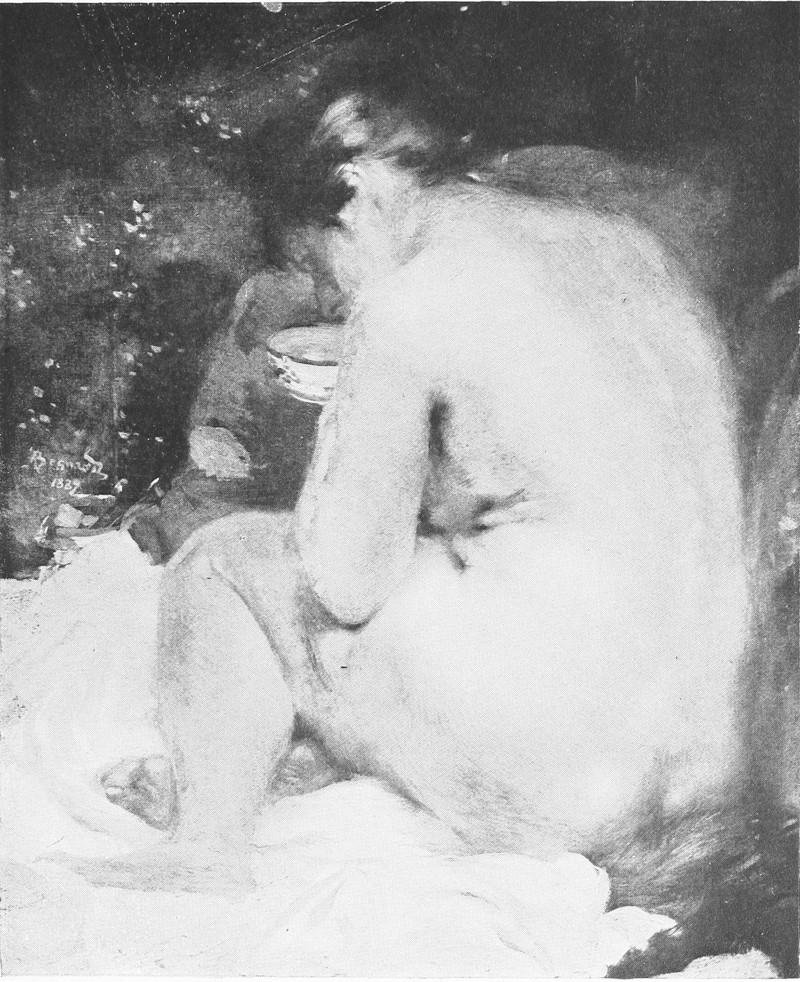
A STUDY · ALBERT BESNARD
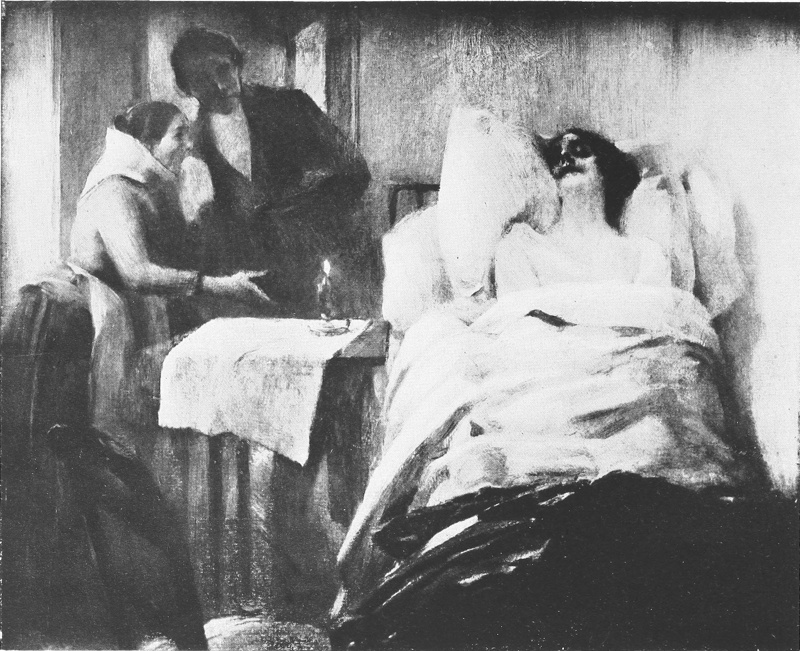
THE DEATH-BED · ALBERT BESNARD
Personally Didier-Pouget is more Spanish than French. Of medium height, tanned complexion, black hair, dark eyes which tell unmistakably of the artist, very reserved in manner, and modest to a degree—these are his characteristics. He leads a solitary life in the Boulevard de Clichy. In his large studio will probably 87be found the canvas he is working upon, about ten feet by six, his favourite size. Innumerable studies are scattered around, rapid sketches of form and colour, line-drawings, careful black-and-white work full of detail, in fact every trifle which will aid him in completing the whole.

MORNING MISTS IN THE VALLEY OF THE CREUSE · DIDIER POUGET

MORNING IN THE VALLEY OF THE CORRÈZE · DIDIER POUGET
If the greatest art is to represent an impression of Nature at her best, then the work of Didier-Pouget is great. “It is truly worth while being a painter to have produced any one of these,” writes the critic of “Le Temps.” The artist loves best to represent Nature in her peaceful moods, and generally seeks the solitudes of the exquisite hills, valleys, and rivers of the Tarbes countryside, or the rich watershed of La Creuse. Here, in the fresh early-morn, charged with dew and mist, he finds his subjects, overlooking magnificent panoramas of river, hillsides covered with heather, across valleys and plains from which loom out sculpturesque masses of foliage, dark and strong against the blue mist and distant mountain ridge. The painter prefers Nature serene and undisturbed, and introduces but little incident.
It need hardly be said that his palette is free from all blacks, browns, ochres, or earth-colours generally, and that his strongest “effects” are gained by the juxtaposition of pure tints in harmonious contrast. His favourite colour-scheme seems to be the composition of subtle arrangements in yellow and blue, or pink and green. He contributes regularly to the Salon, yearly producing from two to four canvases of the size mentioned, and in these days of a limited market and unlimited talent, he invariably finds purchasers. So fortunate has he been that his numerous friends have but one fear for his future, that his enormous success may hasten a tendency to stereotype his compositions. Didier-Pouget is doubtless aware of this danger, and will probably follow his present aims in a manner which will not disfigure or flaw a most brilliant career.

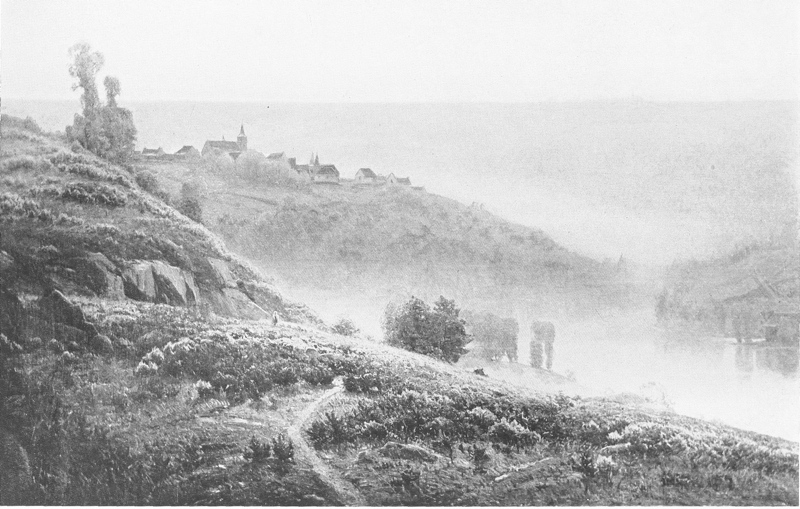
THE VALLEY OF THE CREUSE · DIDIER POUGET

PORTRAIT OF HIS MOTHER · J. A. McN. WHISTLER
“THROUGH HIS BRAIN, AS THROUGH THE LAST ALEMBIC, IS DISTILLED THE REFINED ESSENCE OF THAT THOUGHT WHICH BEGAN WITH THE GODS, AND WHICH THEY LEFT HIM TO CARRY OUT”
WHISTLER’S TEN O’CLOCK

MR. WHISTLER’S personality was one of the most striking in the art world of the last forty years, and his death was an irreparable loss. That he will rank as one of the greatest masters of the nineteenth century there can be no doubt. As an Impressionist with a strong individuality his work requires attention in this volume.
The Whistler family came originally from England, chiefly from the neighbourhoods of Whitchurch and Goring-on-Thames. A notable ancestor was Daniel Whistler, President of the Royal College of Physicians of England in the reign of Charles II. Several references to this “quaint gentleman of rare humour” are to be found in the pages of ‘Pepys’ Diary,’ and the family trait reappeared (with emphasis) in the character of the famous artist. James Abbott McNeill Whistler was born at Lowell, Massachusetts, in 1834, his father being Major George Washington Whistler, for some time consulting engineer to the St. Petersburg and Moscow Railway. The son was destined for a military career, and received a considerable amount of tuition at the Government College at West Point. Work as a cadet, and also on the coast survey, does not seem to have interested him. In the fifties he migrated to Paris and became a student in the atelier of Gleyre, two of his fellow pupils being Sir Edward Poynter and George du Maurier. Whistler cannot have had much sympathy with the art in vogue at that time, a degenerated style based upon a sentimental classicalism. He found his best friends amongst young Frenchmen with extremely different ideas, men such as Fantin-Latour, Bracquemond, Degas, Manet, Duret, Claude Monet, and many others. Whistler first acquired fame as an etcher, and his first set of plates, known as the “little French set,” amply justifies the welcome with which it was received. From that early date until his death he has been acknowledged pre-eminent in the etcher’s delicate and graceful art.
90At the Salon de Refusés (to which frequent reference has already been made) Whistler exhibited his first important painting, the Little White Girl, Symphony in White No. 2. It created his reputation as a painter, and remains one of the most charming of his canvases. An early contribution to the Royal Academy was entitled At the Piano, and clearly showed that the artist was then dominated by the subtle influence of Dante Gabriel Rossetti. This influence was quickly discarded, for Rossetti’s talent was inferior to that of the gifted American.
It has often been said that Whistler was never welcomed at the Royal Academy. This point remains debatable; the fact remains that the artist was constantly in evidence during the early part of his career. In 1859 he exhibited two etchings from nature (the title given in the catalogue to one frame); in 1860 the celebrated At the Piano (which was bought by an Academician) and five other works, namely, Monsieur Astruc, Rédacteur du Journal l’Artiste (Drypoint); Thames—Black Lion Wharf; Portrait (Drypoint); W. Jones, Lime Burner, Thames Street (Etching); and The Thames, from the Tunnel Pier. In 1861 he was represented by one canvas, La Mère Gérard, together with Thames from New Crane Wharf (Etching); Monsieur Oxenfeld, Littérateur, Paris (Drypoint); The Thames, near Limehouse (Etching). In 1862 he sent two paintings, The Twenty-Fifth of December, 1860, on the Thames, Alone with the Tide; and Rotherhithe (Etching). The next year, 1863, was prolific. The catalogue contains the following titles: The Last of Old Westminster; Weary (Drypoint); Old Westminster Bridge; Hungerford Bridge (Etching); The Forge (Drypoint); Monsieur Becgis (Etching); The Pool (Drypoint). Two works were on view in 1864: Wapping and Die Lange Lizen—of the Six Marks. In 1865 he exhibited The Golden Screen; Old Battersea Bridge; The Little White Girl (with a quotation in the catalogue of fourteen lines from Swinburne); and The Scarf. Whistler was not represented in 1866, but in 1867 exhibited the Symphony in White No. 3; Battersea; and Sea and Rain. After a break of two years came The Balcony in the Academy of 1870. The next year’s catalogue does not contain his name, but in 1872 the Academy accepted that exquisite example of his art, now in the Luxembourg, Arrangement in Grey and Black: Portrait of the Painter’s Mother. For six years Whistler was an absentee, being represented for the last time on the walls of Burlington House, in 1879, by Old Putney Bridge (Etching).
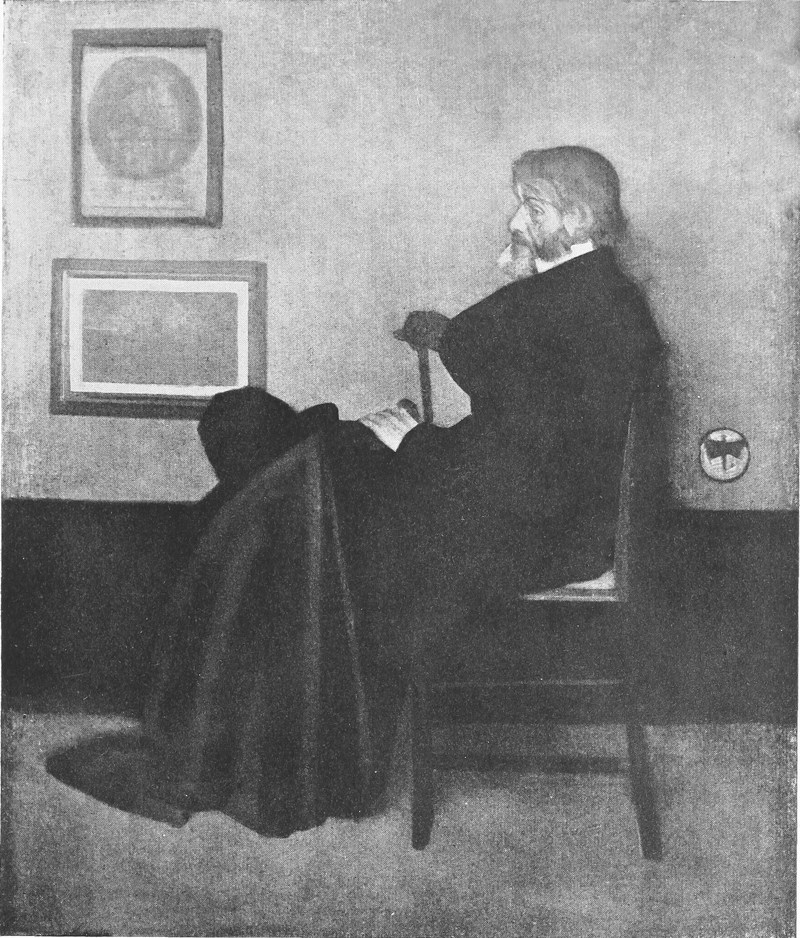
PORTRAIT OF THOMAS CARLYLE · J. A. McN. WHISTLER
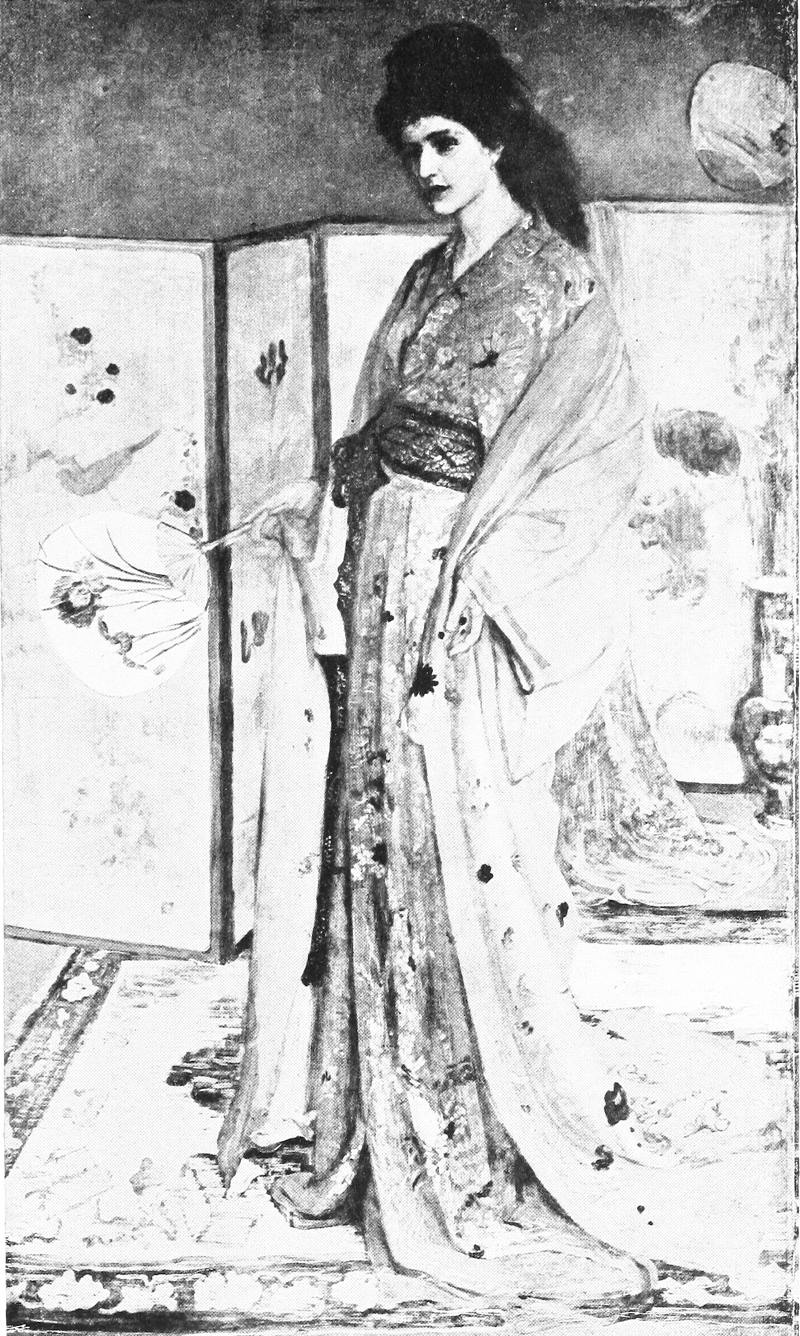
PRINCESS OF THE PORCELAIN COUNTRY · J. A. McN. WHISTLER
The majority of Whistler’s masterpieces were exhibited at the Grosvenor Gallery in the days when Sir Coutts Lindsay was at the head of the direction. The walls of the rooms in Bond Street were 91repeatedly adorned by those charming creations known as Nocturnes and Symphonies, by the remarkable Valparaiso, by many of the portraits, notably Lady Archibald Campbell, Carlyle, and the delightful Miss Alexander. Twenty years ago Whistler’s life in London and Paris was exceptionally active. In him Society discovered a wit of Gallic alertness, and he speedily became one of the most prominent characters of the day. Readers will remember the oft-told tale of how Whistler sacrificed (with a true Whistlerian light-heartedness) much costly Cordovan leather, in order that he might create a masterpiece of decoration in the celebrated Leyland mansion. Another historic story is the cause célèbre of Whistler v. Ruskin, based upon the criticism of a Grosvenor Gallery nocturne as “a pot of paint flung in the public face,” with the resultant farthing damages. The canvas which called forth this elegant banter was that entitled Nocturne in Black and Gold; the Fire Wheel, the theme being a display of fireworks in the gardens at Cremorne. From a literary point of view, as a writer of biting sarcasm the artist scarcely had a peer. One admires that lively jeu d’esprit “Ten o’clock,” and the strange mixture of correspondence entitled “The Gentle Art of Making Enemies” will not be out of date until all the shining lights of the present generation have been forgotten.
After two years of probationship as an ordinary member, in 1886 Whistler became President of the Royal Society of British Artists, an old-established and hitherto staid and conservative institution. His term of office was brilliant and exciting; he himself exhibited such wonderful pictures as the Sarasate, and his reputation attracted the most talented of the younger artists of the day. The correspondence which ensued when Whistler vacated the presidential chair must be sought for in “The Gentle Art of Making Enemies.”
In Whistler’s work there is a curious yet indefinable influence of Japanese painting. In company with most of the Impressionists, he was influenced by those Impressionists of another race. This influence is to be observed in all modern painting since 1870, when artists first commenced to collect examples of the Japanese methods.
In his later years Whistler preferred the atmosphere of Paris to that of London, although he continued to visit occasionally the country he described as “humourless and dull.” The artist was thoroughly cosmopolitan, and was equally at home in New York, Paris, or London. His influence upon the art of to-day has been unmistakable, and one has little doubt as to its permanency. 92Whistler helped to purge art of the vice of subject, and the belief that the mission of the artist is to copy nature.
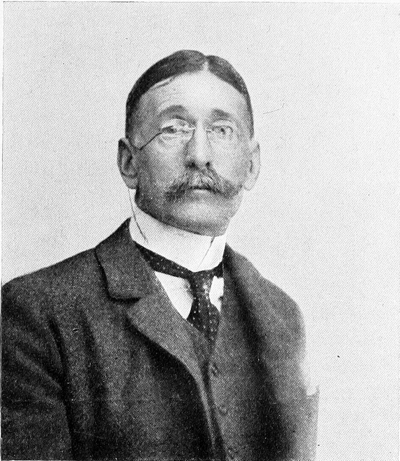
ALEXANDER HARRISON
Mr. Alexander Harrison is one of those numerous American artists who have settled in France, a natural result of French training and French sympathies. Inspired by Manet, influenced by Besnard, he has painted some of the most successful Impressionist work of the last fifteen years. One cannot agree always with Dr. Muther in his learned and not altogether satisfactory tomes, but his appreciation of Mr. Harrison is so delicate and just that it is worth reproducing. “In Arcady,” he writes, “was one of the finest studies of light which have been painted since Manet. The manner in which the sunlight fell upon the high grass and slender trees, its rays gliding over branch and shrub, touching the green blades like shining gold, and glancing over the nude bodies of fair women—here over a hand, here over a shoulder, and here again over the bosom—was painted with such virtuosity, felt with such poetry, and so free from all the heaviness of earth, that one hardly had the sense of looking at a picture at all.” The luminous painting of Besnard had here reached its final expression, and the summit of classic finish was surmounted. His third picture was called The Wave. To seize such phenomena of Nature in their completeness—things so fickle and so hard to arrest in their mutability—had been the chief study of French painters since Manet. When Harrison exhibited his Wave, sea-pieces by Duez, Roll, and Victor Binet were also in existence; but Harrison’s Wave was the best of them all.

IN ARCADY · ALEXANDER HARRISON
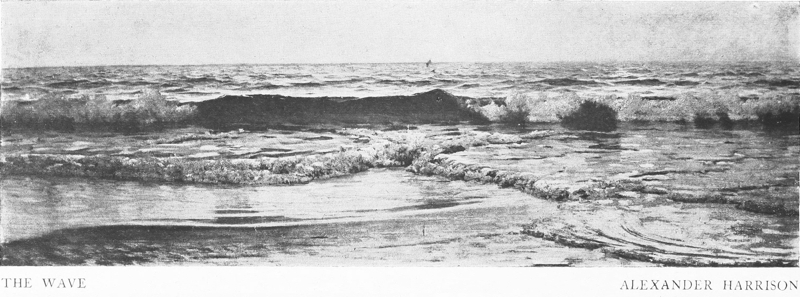
THE WAVE · ALEXANDER HARRISON
Harrison’s vast studio in Paris breathes of the sea. The painter is an ardent yachtsman, and traces of his recreation are numerous. Here are to be found dozens of canvases, rolled up, piled in bundles, hung haphazard against the walls, each one telling some different story of the waters. These studies, probably worked upon in the neighbourhoods of Pould’hu or Begmiel, are often actually salted and sanded by contact with the elements which dash against the wild but lovely Breton shores. No modern man paints seascapes like Harrison. He produces effects which are evidently the results of patient vigil and watching, as well as a vigorous power of brushwork. They are transcripts of the ocean, which can only be seen as the sun rises out of the east over the waters, pale lilac tints, softly fading into citron, or gaining added strength in vermilion or deep orange reflected from the passing clouds, whilst sweeping ripples (one can almost hear their rhythmic cadence) are gently lost across the expanse of ethereal, glistening sand.
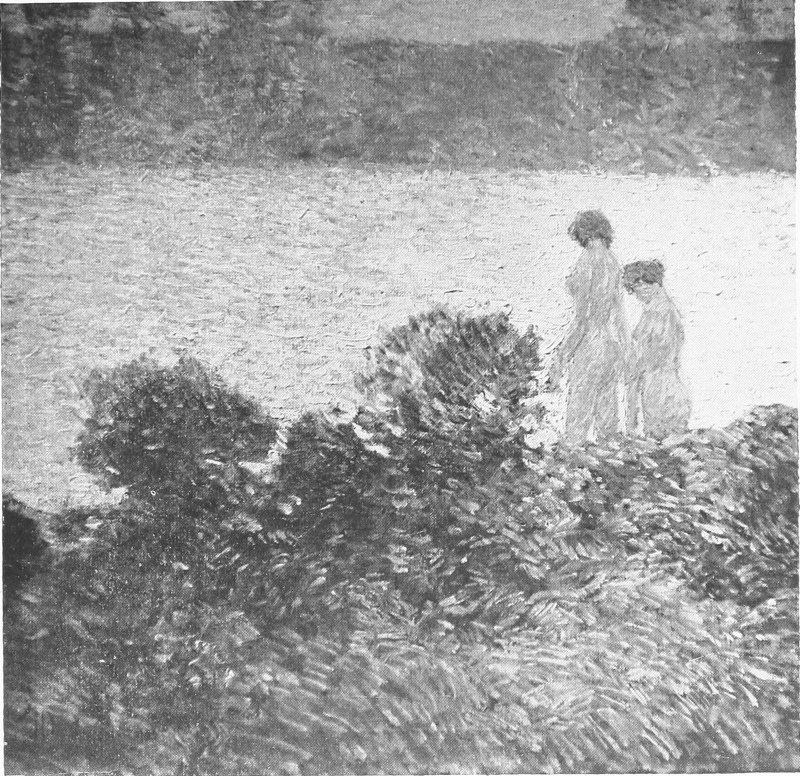
SUNLIGHT ON THE LAKE · CHILDE HASSAM
In other pictures we see the tide at full flood; nature is in a 93fairer mood, and the universe glows with an exquisite green. The waves, of a glassy transparency, are for the moment held in check by a supreme power. Such passing phases of Nature Mr. Harrison seizes with unerring touch. Another branch of his work, already referred to in speaking of the picture In Arcady, are the paintings of the nude amidst the actual surrounding of the fields. Part of their success may be ascribed to the fact that they have been painted in each case in the open air. From the photographs, which Mr. Harrison has allowed us to reproduce, both sides of his beautiful talent may be judged. Like most Impressionists, his art breathes of a love and joy with Nature as seen by a temperament refined, distinguished, one may add—aristocratic.
In the days when Florida was a primæval wilderness Mr. Harrison as a very young man entered the United States Coast Survey. Whistler, it may be remembered, commenced his career under the auspices of the same department. Florida was just the place for an adventurous youth, and Harrison was interested in his work. His enthusiasm, coupled with his ability, resulted in being intrusted with most of the difficult and sometimes dangerous “reconnaissance” engineering scout work that called for lonely jaunts and camping out amongst the swamps and lagoons.
After four years on the Florida coast the party moved on to Puget Sound. The young men connected with the survey had been dabbling for some time in the use of water-colours, and Harrison found that the artist in him was winning ascendency over the surveyor. An argument with the head of the survey settled the matter. Mr. Harrison went to San Francisco, and then travelled to Paris, and studied under Gérôme. He was in his twenty-sixth year, and conscious that his career was midway between success and failure. He exhibited at the Salon a picture Châteaux en Espagne, a boy stretched on his back in the sand of a warm, dry beach, wrapt in the spell of a day-dream. “It was rather symbolic,” said the artist once as he gazed at the photograph, “of my own state of mind at that time.”
During the next ten years he was engaged in painting nudes in the open air. His chief source of inspiration was his friend Bastien-Lepage, with whom he travelled to Brittany. Harrison’s first success was In Arcady, now in the Luxembourg. A recent journalistic interview elicited many interesting facts about Mr. Harrison’s method of work. The writer concludes: “Mr. Harrison’s usual haunt in Brittany is Begmiel. Here there is a sandy peninsula jutting into the sea, whence you can watch the sun go down on the one horizon, and the moon come up from the other. He does not 94carry his paint-box about with him taking notes. Memory and imagination, knowledge and power of visualisation, take psychic photographs. It is not to be gathered from this that Mr. Harrison is unerring. He has scraped out as many yards of painted canvas as any man. But where his strength undeniably exists is in this subjective, rather than objective, genius for instantaneous notation. When he comes to put the picture on the canvas—now mark the importance of early influences—he becomes the young surveyor again engaged in reconnaissance. He takes his embryonic map (a small canvas) and puts down his known points. He knows just what spot of colour was here, what broken line there. The more he puts down the more he sees, and presently the little map is finished. The first map finished a larger size is made, and, if all goes well, perhaps one larger still, and we have a great picture like any one of those exhibited by the artist at the Salon of the Société Nationale.”
It is hardly necessary to add that this artist is an officer of the Legion of Honour, and has received numerous medals and other awards. Of the Franco-American school of painting he is one of the recognised heads, and this has been acknowledged by his election to the chief art societies of Paris, New York, Berlin, and Munich, whilst he is represented in the permanent collections of the Luxembourg, the Royal Gallery, Dresden, the Museum at Quimper, and the American galleries of Philadelphia, Washington, Chicago, St. Louis, and San Francisco.
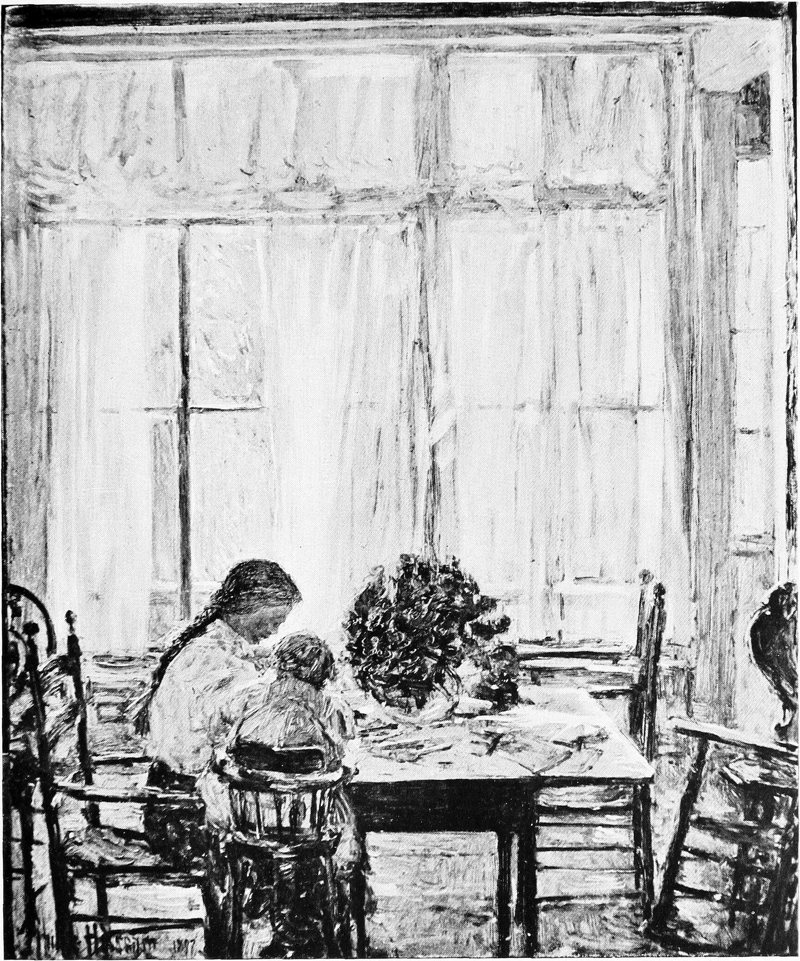
CHILDREN · CHILDE HASSAM
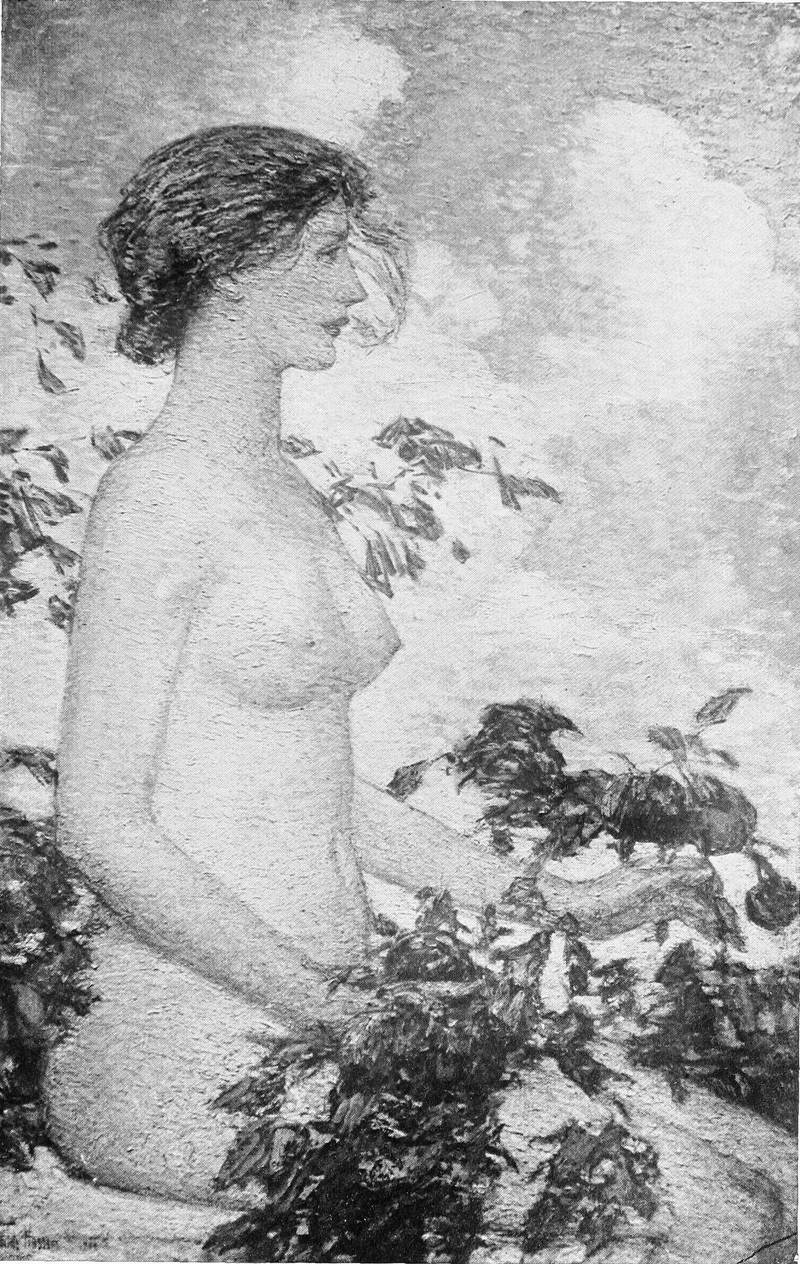
POMONA · CHILDE HASSAM
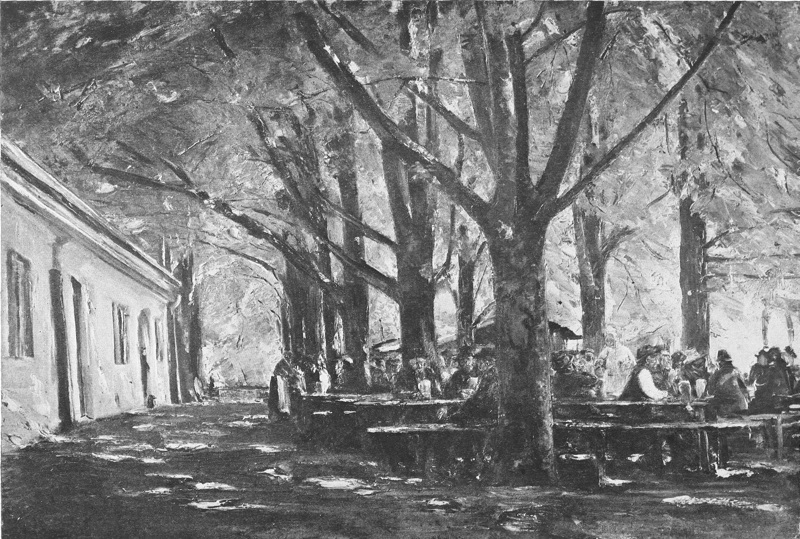
A COUNTRY BEER-HOUSE, BAVARIA · MAX LIEBERMANN
Childe Hassam is a young American artist who has been strongly influenced by Impressionism. Originally from Boston, he worked for several years in Paris, and when he returned to the States had already some reputation. In New York he has “rendered the street life in fresh and fleeting sketches; snow, smoke, and flaring gaslight pouring through the shop-windows, quivering out into the night, and reflected in an intense blaze upon the faces of men and women.” A typical example of his work in this genre is Seventh Avenue, New York. Childe Hassam is an associate of the Société Nationale des Beaux-Arts, a member of the Secession of Munich, the American Water Colour Society, and numerous clubs and societies throughout the States. He has received medals at many of the recent International Exhibitions, including that of Paris in 1889, whilst he is represented in several of the continental and transatlantic galleries. Being still young and enthusiastic, much may be expected of Mr. Hassam in the future.
“CE QUE JE CHERCHE AVANT TOUT DANS UN TABLEAU, C’EST UN HOMME ET NON PAS UN TABLEAU”
ZOLA

GERMANY has been strongly affected by the French movement, as in fact has been the whole of the Continent. Any person who can remember the state of art in the Fatherland twenty years ago will notice the great change now taking place. He need only revisit the country and wander through the great annual exhibitions held in the larger cities, such as Berlin, Munich, and Dresden. In 1878 the “Gazette des Beaux-Arts,” referring to the German school of painting, said: “There are one or two artists of the first rank, and many men of talent, but in other respects German painting is still upon the level of the schools which had their day amongst us thirty years ago; this is the solitary school of painting which does not seem to perceive that the age of railways and World Exhibitions needs an art different from that of the age of philosophy and provincial isolation.” Since that date, in the manner of viewing nature, in the choice of subject, in the style, composition, technique, and colour of pictures, the main trend of German art has been completely altered. Until quite recently Teutonic artists delighted in the allegorical. The output of fabulous monsters, fauns, unicorns, satyrs, was enormous. Every young painter turned his hand to the production of these fantastic mythological subjects. Happily a saner view of the mission of art has come over the land, and the fauns and satyrs are being gradually relegated to oblivion. From an absurd pseudo-classical style (the effect of teaching from men like Couture and Munkacsy), together with unlimited use of bitumen and black, a national school of painting has been evolved which follows “la peinture claire,” giving promise that in time it will travel, as regards purity of colour and brilliance of effect, far beyond the bounds Monet has restricted himself to. Work “en plein air” is the vogue, and no longer the exception, whilst the sun is recognised at his true worth in the universal scheme of nature. Hitherto King Sol has been disregarded, and his presence but rarely indicated in some low-toned sunrise, or a sunset effect—the conventional 96chrome-yellow band across a deep Prussian-blue hill distance. Following the lead of the artists, both critics and public are being gradually weaned from the love of black shadows, although it cannot be said that they are wholly converted. Still their education is in rapid progress, and the German people will soon be abreast of the times in matters artistic.
One man, Max Liebermann, has brought about this healthy state of things almost single-handed. A consideration of his lifework is of the highest importance and interest to all concerned either with the progress of German art or the movement of French impressionism, for Liebermann is a master, head and shoulders above all his colleagues. His artistic history is easy to trace. The greatest painters are always primarily attracted by the work of other great men. They copy the models of their choice, and, missing some of the peculiar qualities enshrined therein, gradually replace them in their own works with something equally fine. These fresh qualities will in their turn find admirers, and, fanning the zeal of newcomers, keep alight throughout the ages the sacred flame of art. If Delacroix borrowed from Constable, Manet borrowed from Delacroix, and Liebermann from Manet. In his turn, Liebermann has influenced a large and increasing number of young German and Dutch artists.
With his pre-eminent position as a representative German painter, Max Liebermann combines a commanding and active personality. More than any other man of his time, his work has provoked discussion and attracted attention from the commencement. During the last thirty years he has fought strenuously the battle of light in painting. Strongly influenced by Manet, Monet, together with Millet and the Barbizon school, he has succeeded in inculcating amongst his brother artists a love of actuality in subject, a desire to work direct from nature (contrary to that old method of painting in the semi-gloom of the studio from incongruous models in more or less correct costume), together with the simplification and purification of the palette. Liebermann has taught German artists to look at nature as it is, and not to represent it as seen through the veil of a deadening academic tradition; he has taught them that art does not consist in a minute finish, that there is no finality in nature, and that the last impression which a true work of art should convey is that of excessive industry.

THE COBBLERS · MAX LIEBERMANN
Max Liebermann was born in Berlin, July 29, 1849, the son of a wealthy merchant. At an early age he decided to become an artist, but the fulfilment of his wish was opposed by his father, who suggested a course of philosophy at the University of Berlin as an 97antidote. Young Liebermann joined the faculty of philosophy, but at the same time worked in Steffeck’s studio where he made quick progress. He assisted his master, we are told, in the battle picture Sadowa, painting guns, sabres, uniforms, and hands, with much approbation from Steffeck. He frequented the galleries and museums in preference to the class-rooms, and preferred to sketch in the streets and parks of Berlin rather than sit at the feet of a professor at the University. In 1869, with parental authority, he deserted philosophy altogether, and joined the Academy at Weimar, then in high repute as a school of art producing the regulation painters of orthodox pattern. Here he worked for three years under Thumann and Pauwels, beginning pictures in their style which were left unfinished. The petrified classicalism which reigned in Weimar was little acceptable to a youth who had keenly studied the life around him, and who had developed a strong love for natural effects as well as modernity in technique. These heretical tendencies were sternly repressed by his respectable and erudite teachers. At last Liebermann threw aside artificiality, and, quitting the circles of the conservative Academy, occupied himself in painting in the open air.
In 1873 he finished his first great picture, Women plucking Geese, now in the National Gallery, Berlin. It was more or less academic as to technique, and black tones predominated throughout in accordance with the fashion of the period. The subject brought the canvas into immediate notoriety, the picture was condemned as a gross vulgarity, and Liebermann was described as “the apostle of ugliness.” This hostile reception was entirely unexpected by the sensitive artist, who was much affected by it, and determined to leave Berlin for Paris.
Thirty years ago the bituminous method of Munkacsy was the most popular art in Germany, and influenced many of the younger painters, Liebermann included. Upon his arrival in Paris the artist sought out the great Hungarian, and asked for advice. The result of the interview was that Liebermann quitted Paris for Holland. Munkacsy was at that time, as Dr. Muther remarks, under the influence of Ribot, and confirmed Liebermann in his preference for heavy Bolognese shadows. It was not until he came to know the works of Troyon, Daubigny, and Corot, that he liberated himself from the influence of the school of Courbet. As subsequent events proved, the advice given by Munkacsy was good and to the point, and Liebermann acknowledges his great obligation to the painter of Christ before Pilate.
The first motive of importance which Liebermann found in the 98Low Countries resulted in the picture Women preserving Vegetables, completed at Weimar in 1873, and exhibited at the Salon of the same year. The subject represents a group of women in a dimly lit barn busily engaged in preserving cabbages and other vegetables. The canvas, although a great advance upon its predecessors, was ungraciously received in Germany. So little appreciation did Liebermann receive that he definitely removed to Paris, where he knew a welcome awaited him. In “la ville lumière” he worked in the schools and museums, studied Troyon, Daubigny, and Millet, whilst the influence of Manet, Monet, and the other Impressionists, was an important factor in the development of his art.
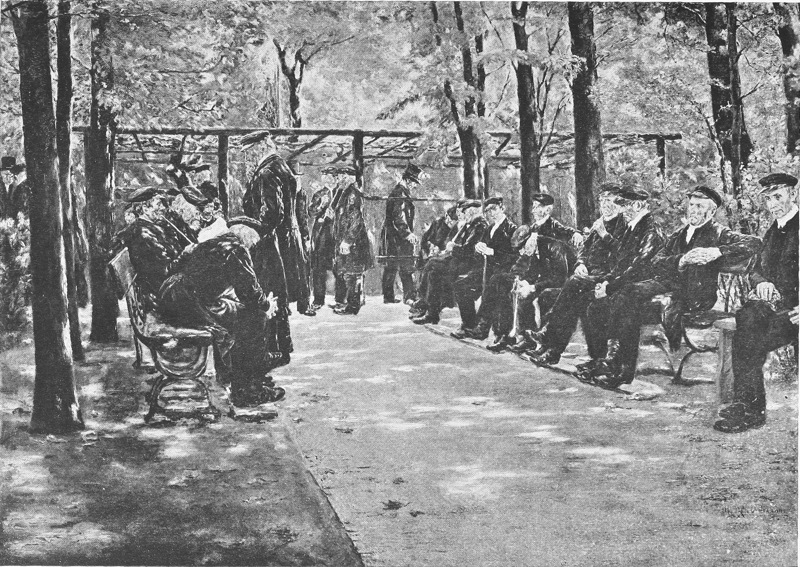
ASYLUM FOR OLD MEN, AMSTERDAM · MAX LIEBERMANN

WOMAN WITH GOATS · MAX LIEBERMANN
So strong was his admiration for Millet that he went down to Barbizon, where he arrived shortly before the death of that great artist. Under the influence of Millet he painted Labourers in the Turnip Field, and Brother and Sister, which appeared in the Paris Salon of 1876. He now reached the turning-point of his career, for he had made up his mind that at all costs he must perfect his own individual style. A great unrest, useless to battle against, disorganised his movements. He travelled through Belgium, Holland, Germany, and Italy, studying and searching for the inspiration which should place him in the right path. During these travels he met at Venice Lenbach, the portrait-painter, who told him to study in Munich. Tired of wandering he acted upon the suggestion, and passed six years in the Bavarian capital. For a period his art assumed a religious character, and he painted many biblical compositions. These works were coldly received, and in Munich they were strongly and adversely criticised. The clergy objected to them as profane, and a debate on the subject followed in the Bavarian Assembly. The life of the artist becoming exceedingly uncomfortable, Liebermann settled in Amsterdam, where he found a freer artistic atmosphere more congenial to his temperament. Disdaining the critical capacity of his native city, Liebermann forwarded all his finest works to Paris, and in the Salon of 1881 exhibited An Asylum for Old Men, which gained a medal in the third class, the first honour awarded to German art since the war. Having received the official imprimatur of Paris, his countrymen began to realise that an artist had grown up amongst them they could no longer afford to neglect. Liebermann’s works found purchasers throughout the Continent, and his future was assured. He was elected a member of the “Cercle des Quinze,” of which Alfred Stevens and Bastien-Lepage were prominent supporters, and he exhibited annually at the Salon Petit and other French collections. Since 1884 he has divided his time between Berlin and 99the little village of Zandvoort, near Hilversum, in Holland. Perhaps his early experiences account for the fact that when in the German capital he mixes little with its artistic society.
Liebermann has practised with success and ability every variety of artistic expression. His portraits alone would class him amongst the masters, taking as examples the Burgomeister Petersen, the Professor Virchow, and the Gerhart Hauptmann. He is equally facile with the burin, the needle, the pastel, or with water-colours. His activity is ceaseless, and his production, in consequence, enormous; he possesses robust health, uncommon strength, enormous fertility, traits common to the great artists of all ages.
In his fine canvas of the Courtyard of the Orphanage, Amsterdam, painted in 1881, Liebermann shows for the first time complete emancipation from the thrall of Munkacsy’s influence. The picture was exhibited in the Salon of 1882, and in it appears that peculiar note of red, now one of the distinguishing features of the artist’s work. Of this canvas Hochédé, the Parisian art critic, said that Liebermann must surely have been stealing sunbeams to paint with. Then commenced a long series of pictures such as the Ropeyard, the Netmenders, now one of the most valued pictures in the modern section of the Gallery at Hamburg, in which the Impressionist spirit is clearly manifested. The unimportant has been omitted, and the pith of the subject only is given. The point of view is focused, the inconsequent suppressed, and the “mise en scène” proves the artist to be an irreproachable draughtsman, as well as a colourist of the first rank. Liebermann’s pictures of “sous bois” are particularly pleasing, strikingly painted and original; they were the first of their kind in Germany, and disconcerted the whole artistic community.
In following the progress of Liebermann’s art, one notes that he is attracted unceasingly by problems of light. If Manet is the great apostle of “plein air” painting, surely no one has yet surpassed the marvellous style in which Liebermann succeeds in rendering the attenuated scheme of interior lighting in conjunction with extraordinary powers of sunlight painting. His gradual emancipation from tradition may be easily traced from the days of Women plucking Geese, when he was with justice called a “son of darkness”; through the “sous bois” pictures, to the present period of vivid sunlight and violet shadows across open country, sea, and the human figure.
Liebermann headed the party which revolted from the National Salon, and of the Secessionists he is the president. Similar cleavages 100of the young and progressive from the old and reactionary have taken place in most countries with equally important results. In Max Liebermann Germany has an artist of most exceptional gifts. “I do not seek for what is called the pictorial,” he writes, “but I would grasp nature in her simplicity and grandeur—the simplest thing and the hardest.”
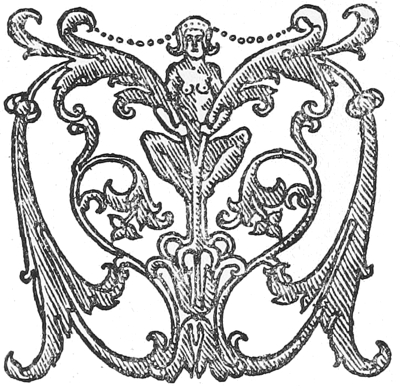
“C’EST L’AFFIRMATION GRANDIOSE DE L’EFFORT VERS LE BEAU QUE CERTAINS ARTISTES INDÉPENDANTS TRAITÈRENT À UN MOMENT DONNÉ EN DEHORS DE LA TRADITION ET DES FORMULES ACQUISES”
GEORGES LECOMTE

IT is the fashion nowadays amongst a certain class of art-critics to adopt the pessimistic note. They laud the past, deplore the present, and display sympathetic alarm for the future of art and artists. Should a modern manifestation of art be under discussion, some phase undeniably good and universally accepted by those best qualified to form an opinion, these critics recognise it with a guarded qualification and a prophecy of its speedy decadence in the immediate future; and these depreciatory remarks are extended to all those artists who have been attracted by the new movement and have ranged themselves under its banner. It has always been so. In the art literature of the past we read of Delacroix and the decadence, of Corot and the downfall, of Monet and the abyss. There are still living in France aged and honoured professors, members of the Institute and of the Salon juries, who believe that the teaching of Claude Monet has been a national calamity. They hold that art no longer exists, having been destroyed by these dreadful innovations. Is it not strange that the birth of new methods, rather than the death of old ones, should be heralded with melancholy head-shakings, with frequent and wrathful imprecations upon the impious intruders! Time rights all things. The new to-day is old to-morrow, the exotic becomes classic, and one more page is added to the history of the evolution of art.
Nothing is more amazing than to read in the daily and weekly press of the “pernicious influence” and decadence of modern French art, criticisms the more astonishing as the present age is one of universal travel and liberal ideas. French art is in no such parlous state, and never, at any period of its history, displayed stronger signs of vitality. Never was its activity greater, nor its influence, poetry, and gaiety better for the general good of the nation. Such wild accusations are unjustifiable, hypocritical, and themselves pernicious. French influence dominates the work of the most successful painters 102and sculptors throughout the world. The art of such men as La Thangue, Edward Stott, Alfred East, Peppercorn, Bertram Priestman, Arnesby Brown, Fred Footet, John Lavery, Macaulay Stevenson, Edwin Abbey, John S. Sargent, George Clausen, and the men of the Glasgow school, is unquestionably derived from Paris, a city we are asked to believe is decadent in art matters. Of these artists it may be said that the majority were educated in Paris. It is well to acknowledge candidly that, although in the days of Gainsborough, Turner, Constable, and the other members of that brilliant band, English art led the world, to-day we must look to “la ville lumière” for instruction and inspiration. The fact is proved by the enormous preponderance of students of all nationalities who flock to Paris for the completion of their art education. In other words, French art is the leading art of the day, and will remain so for many years to come.
Let any unbiased observer compare the two magnificent Salons of Painting and Sculpture held annually in Paris with the English Royal Academy, New Gallery, and British Artists’ Exhibitions. Note that France houses her artists in some of the most beautiful palaces in the world, then think of London. Observe the high average quality of the exhibits, their astounding technical excellence, the courage of the artists, and their bold experiments in untrodden paths, their extraordinary originality and diversity of temperament. They are not content with an ephemeral success, or the stereotyped reproduction of popular playthings. The contributors are cosmopolitan in nationality, for, provided the necessary passport of talent, Paris welcomes the stranger. Where in Great Britain can the foreigner, even if he possess acknowledged genius, be sure of meeting with a sympathetic reception and fair play from a Hanging Committee? He is fortunate if he escapes public ridicule. The Continental artist has learnt this lesson and troubles us no more, to the blight of our national education and the detriment of our taste. This blot upon our reputation for common sense has been to some extent redeemed of recent years by the International Society of Painters, Sculptors, and Gravers. Perhaps its intermittent exhibitions will rehabilitate our name abroad, and incidentally aid in revivifying our national taste.
Recall haphazard the names of a few artists who are at the present moment exhibiting in France. Aman-Jean, Barillot, Binet, Besnard, Billotte, Bracquemond, Cottet, Chèret, Carrière, Cassatt, Cazin, Dagnan-Bouveret, Daillon, Dameron, Didier-Pouget, Degas, d’Espagnat, Forain, Fantin-Latour, Geffroy, Gosselin, Gaston la 103Touche, Gagliardini, Guillaumin, Harpignies, Henner, Lhermitte, Le Sidaner, Meunier, Marais, Monet, Menard, Maufra, Montenard, Pointelin, Ribot, Rigolot, Raffaëlli, Rodin, Renoir, Roybet, Ziem. This list can be extended indefinitely by the addition of the names of artists of the rarest temperaments. The art of the whole of the rest of the world cannot surpass the productions of these men.
The state of the plastic arts in England is deplorable. If it be not soon remedied, we shall be compelled to go abroad for any statues needed. The little sculpture we have is frequently excellent, but its output is so insignificant that it cannot possibly be compared with the sculpture of France. The art cannot flourish in England whilst there are so few public commissions, or wealthy patrons. Financially the painter’s career is bad enough, but, as a remunerative profession, sculpture does not exist. Look around the galleries in London during the height of the season, and note the quite insignificant amount of sculpture exhibited. Many of the London galleries exclude it altogether, and in the provincial collections it is practically non-existent. If there is any it is systematically overlooked by visitors, and as for sales—! one never hears of such a thing. Then remember Paris with its immense annual production of excellent sculpture, and the admirable manner in which the State fosters this great art.
If we take monuments and statues in public places as the fittest expression of national gratitude, we are sadly lacking. Where in England can we find monuments in perpetuation of the memory of such mighty painters as Turner, Reynolds, Gainsborough, Constable, Romney, and a score besides. If we possess such monuments, they are certainly hidden away from the sight of both native and stranger, and the latter frequently remarks upon their absence. In France the birthplaces of these artists would have raised some remembrance, whilst the capital city in which they laboured would surely have had its statues and collegiate endowments to perpetuate their spirit. An example can be quoted from the little country town in which these lines are being written. Here in Les Andelys, in the most prominent position, are two statues. One of them is as fine a memorial as can be seen in any capital city of Europe. The men so honoured in imperishable bronze are not kings, generals, statesmen, or even local benefactors. They are merely artists, and one of them (the son of an Englishwoman) is but distantly allied to the countryside. Chaplin and Poussin, two artists of thoughtful, gentle lives, of obscure birth, without fortune or influence, yet possessors, in some degree, of the ennobling fire of genius. Of these 104men the simple townspeople are exceedingly proud, and in such pride we see the whole spirit of the nation. France delights to honour genius, and the intelligent foreigner, noting these things, will pay little heed to stories that decadence and pernicious influences are the outcome of such a feeling.
Following the lead of Paris, American painters may be said to have adopted “la peinture claire” almost to a man. Germany also has revolted, and the Secessionist movement, with Liebermann at its head, has gathered together the most vigorous talent in modern German art. Clean painting in a pure and healthy atmosphere now reigns supreme. Spain and Italy have also been deeply affected, and in both of these countries there is a marked recrudescence of that fine talent which in times past distinguished the two peninsulas. Together with this increasing activity is happily to be noted a commensurate degree of financial encouragement. Enormous sums yearly change hands in Germany alone for the products of the new school, irrespective of nationality. The sales recorded at the annual exhibitions in Berlin, Munich, Dresden, and Dusseldorf average about twenty times the amounts received at the Royal Academy, and it is clear that Germany intends to take as leading a position in the arts as she is doing in commerce.
The tendency in England appears to be retrograde. Modern Dutch art reigns as the present fashion, its propagation admirably engineered, its influence widespread. The pictures à-la-mode are those with foggy, sombre grey skies in heavy unatmospheric paint. They give us damp discoloured tenements, shipping the colour of coal-tar, clumsy barges, malodorous canals, ugly toil-broken humanity, the whole as unromantic, depressing, and dyspeptic as can be imagined. The seal of official approbation has been secured for this kind of thing, and the Mansion House requisitioned for its display. This poetry of the prosaic has been generally accepted, and never have times been better for the sturdy, plodding producer of Dutch pictures. As it is the dark and sordid side of Nature that appeals most forcibly to these men, we shall, within a given time, develop a whole race of “Nubians” of our own. Finally we shall deny the very existence of the sun and all he represents in our limited share of life.
The cult of sun-worship, of joy in sparkling colour, of pure health-bringing open-air art must, sooner or later, predominate in England as it already predominates throughout the world. The mission of Impressionism is to depict beauty that elevates, light that cheers. In their struggle for this mastery of light, Impressionist 105painters have often in the past sacrificed many of the qualities which go towards the making of a picture, and have thus incurred public displeasure. Their subjects have been chosen at random, and they have gained their effects often regardless of composition. The artists were far too much occupied by technical difficulties to care about picture-making, and the results, mere studies, were not intended as pictures. They were the necessary experiments incidental to the invention of “Impressionism.” Yet how preferable are these “studies” to the ordinary canvases of commerce, and how treasured they are at the present day. Now that the material difficulties have been overcome, and settled methods achieved, this reproach will disappear, and we may confidently look to the Impressionist picture for all those qualities which go to the making of a perfect work of art.
In the canvases of Vincent Van Gogh, Gauguin, Claus, Maufra, d’Espagnat, Liebermann, Harrison, Besnard, Le Sidaner, and many others of the later school, will be found not only colour, rich light, and subtly strong harmonies, but a feeling for beauty of line, composition, rhythm of movement. Our admiration for the great men of 1870 must not blind us to the fact that there are others; the road is not barred, and many of the followers are of great strength. The pioneers having opened up the new territory, the gift is free and all are welcome.
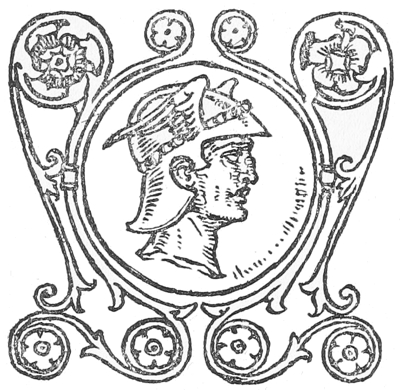
The clearest explanation of the scientific theory of colouring is to be found in the treatise written by Chevreul. First published in France in 1838, it met with great success, and was translated into English in 1854 by Charles Martel. Chevreul remains the standard authority, although he has been followed by Helmholtz, Church, Rood, and others.
Given the necessary competence for accuracy in draughtsmanship, and considerable practice in the manipulation of colour, the art-student may take the field, and not before; for Impressionist painting demands the highest artistic capability. Firstly, he will discover that Impressionists worship light, using the trees, rocks, rivers, &c. of landscape, as so many vehicles for the conveyance of luminous impressions to the eye. This quality of atmosphere distinguishes Impressionist pictures from all others; here will be found what Brownell, Chevreul, MacColl, and Mauclair, have to say upon the subject. Secondly, the art-student will perceive the vital necessity of correct values within a general tone, a subject also enlarged upon by the above writers. Thirdly, some reference is given to the modern study of shadows and reflections, with regard to their influence and treatment.
The following lines, extracted from “The French Impressionists,” by Camille Mauclair, sum up definitely the Impressionist Idea.
“In nature no colour exists by itself. The colouring of the objects is a pure illusion: the only creative source of colour is the sunlight which envelops all things, and reveals them, according to the hours, with infinite modifications.... Only artificially can we distinguish between outline and colour; in nature the distinction does not exist.... A value is the degree of dark or light intensity, which permits our eyes to comprehend that one object is further or nearer than another.... The values are the only means that remain for expressing depth on a flat surface. Colour is therefore the procreatrix of design. Colour being simply the irradiation of light, it follows that all colour is composed of the same elements as sunlight, namely the seven tones of the spectrum.... The colours vary with the intensity of light. There is no colour peculiar to any object, but only more or less rapid vibration of light upon its surface. The speed depends, as is demonstrated by optics, on the degree of the inclination of the rays which, according to their vertical or oblique direction, give different light and colour.... What has to be studied therefore in these objects, if one wishes to recall their colour to 108the beholder of a picture, is the composition of the atmosphere which separates them from the eye. This atmosphere is the real subject of the picture, and whatever is represented upon it only exists through its medium. A second consequence of this analysis of light is, that shadow is not absence of light, but light of a different quality and of different value. Shadow is not a part of the landscape where light ceases, but where it is subordinate to a light which appears to us more intense. In the shadow the rays of the spectrum vibrate with different speed. The third conclusion resulting from this: the colours in the shadow are modified by refraction.... The colours mixed on the palette compose a dirty grey.... Here we touch on the very foundations of Impressionism. The painter will have to paint with only the seven colours of the spectrum, and discard all the others; that is what Claude Monet has done boldly, adding to them only black and white. He will, furthermore, instead of composing mixtures on his palette, place on his canvas touches of none but the seven colours juxtaposed, and leave the individual rays of each of these colours to blend at a certain distance, so as to act like sunlight itself upon the eye of the beholder.”
“Take a landscape with a cloudy sky, which means diffused light in the old sense of the term, and observe the effect upon it of a sudden burst of sunlight. What is the effect when considerable portions of the scene are suddenly thrown into marked shadow, as well as others illuminated with intense light? Is the absolute value of the parts in shadow lowered or raised? Raised, of course, by reflected light. Formerly, to get the contrast between sunlight and shadow in proper scales, the painter would have painted the shadows darker than they were before the sun appeared. Relatively they are darker, since their value, though heightened, is raised infinitely less than the value of the parts in sunlight. Absolutely their value is raised considerably. If therefore they are painted lighter than they were before the sun appeared, they in themselves seem true. The part of Monet’s picture that is in shadow is measurably true, far truer than it would have been if painted under the old theory of correspondence, and had been unnaturally darkened to express the relations of contrast between shadow and sunlight. Scale has been lost. What has been gained? Simply truth of impressionistic effect. Why? Because we know and judge and appreciate and feel the measure of truth with which objects in shadow are represented; we are insensibly more familiar with them in nature than with objects directly sun-illuminated, the value as well as the definition of which are far vaguer to us on account of their blending and infinite heightening by a luminosity absolutely overpowering. In a word, in sunlit landscapes objects in shadow are what customarily and unconsciously we see and note and know, and the illusion is greater if the relation between them and the objects in sunlight, whose value habitually we do not note, be neglected or falsified. Add to this source of illusion the success of Monet in giving a juster value to the sunlit half of his picture than has ever been systematically attempted before his time, and his astonishing ‘trompe d’œil’ is, 109I think, explained. Each part is truer than ever before, and unless one have a specially developed sense of ‘ensemble’ in this very special matter of values in and affected by sunlight, one gets from Monet an impression of actuality so much greater than he has ever got before, that one may be pardoned for feeling, and even for enthusiastically proclaiming, that in Monet realism finds its apogee. Monet paints absolute values in a very wide range, plus sunlight, as nearly as pigments can be got to represent it.”
“Impressionism is the art that surveys the field and determines which of the shapes and tones are of chief importance to the interested eye, enforces these, and sacrifices the rest.
“If three objects, A, B, and C, stand at different depths before the eye, we can at will fix A, whereupon B and C must fall out of focus, or B, whereupon A and C must be blurred, or C, sacrificing the clearness of A and B. All this apparatus makes it impossible to see everything at once with equal clearness, enables us, and forces us for the uses of real life, to frame and limit our picture, according to the immediate interest of the eye, whatever it may be.
“The painter instinctively uses these means to arrive at the emphasis and neglect that his choice requires. If he is engaged on a face he will screw his attention to a part and now relax it, distributing the attention over the whole so as to restore the bigger relations of aspect.
“Sir J. Reynolds describes this process as seeing the whole ‘with the dilated eye;’ the commoner precept of the studios is, ‘to look with the eyes half closed.’ In any case the result is the minor planes are swamped in bigger, that smaller patches of colour are swept up into broader, that markings are blurred.
“The Impressionist painter does not allot so much detail to a face in a full-length portrait as to a head alone, nor to twenty figures on a canvas as to one.”
“The discovery of these Impressionists consists in having thoroughly understood the fact that strong light discolours tones, and that sunlight reflected by the various objects in nature, tends from its very strength of light to bring them all up to one uniform degree of luminosity, which dissolves the seven prismatic rays in one single colourless lustre, which is the light.... Impressionism, in those works which represent it at its best, is a kind of painting which tends towards phenomenism, towards the visibility and the signification of things in space, and which wishes to grasp the synthesis of things as seen in a momentary glimpse.... One has now the right to say, without provoking an outcry, that it has been given to the people of the present time to witness a magnificent and phenomenal artistic evolution by this succession of canvases painted by Claude Monet during the past twenty years.”
Geffroy.
110“Two coloured surfaces in juxtaposition will exhibit the modification to the eye viewing them simultaneously, the one relative to the height of tone of their respective colours, the other relative to the physical composition of these same colours.... We must not overlook the fact, that whenever we mix pigments to represent primitive colours, we are not mixing the colours of the solar spectrum, but mixing substances which painters and dyers employ as Red, Yellow, and Blue colours.... All the primary colours gain in brilliancy and purity by the proximity of Grey.... Grey in association with sombre colours, such as Blue and Violet, and with broken tints of luminous colours, produces harmonies of analogy which have not the vigour of those with Black; if the colours do not combine well together, it has the advantage of separating them from each other.... Distant bodies are rendered sensible to the eye, only in proportion as they radiate, or reflect, or transmit the light which acts upon the retina.”
Chevreul.
“The object of landscape painting is the imitation of light in the regions of the air and on the surface of the earth and of water.... One must seek above all else in a picture for some manifestation of the artist’s spiritual state, for a portion of his reverie.... In the career of an artist, one must have conscience, self-confidence and perseverance. Thus armed the two things in my eyes of the first importance are the severe study of drawing and of values.”
Corot.
For future comparison it will be interesting to note some results reached at recent sales of Impressionist paintings. Pictures which, in the early seventies, were unsaleable for five pounds, now average from £500 to £800 apiece, with a tendency to go much higher. A sale at New York, in December 1902, of seventeen pictures by members of the Impressionist and Barbizon schools, produced nearly £40,000, an average of £2300 for each canvas. The last great public sale by auction was “La Vente Chocquet” at the Petit Galerie, Paris, July 1, 1899. A few days previous to the sale the writer had a long conversation with Claude Monet at Giverny. Discussing the coming event, which was already exciting much press comment, Monet told how the late Père Chocquet, as he was affectionately called, a “chef du bureau” in the Department of Finance, had been a tower of strength to the early Impressionists. He encouraged them, foretold ultimate triumph, invested every franc of his savings in the purchase of their works, at prices ranging from £2 to £10. Late in life M. Chocquet inherited, quite unexpectedly, a large fortune. The Impressionists anticipated much, and the studios were jubilant. Long cherished plans were rediscussed; the Chocquet legacy was to be the source of a golden stream. But a great disappointment was to come. With the increase of M. Chocquet’s riches came the decrease and final extinction of M. Chocquet’s taste. He never bought another picture!
111Throughout the three days’ sale, the gorgeous rooms of M. Georges Petit were crowded, although many well-known and wealthy buyers were absent owing to the lateness of the season. Amongst the distinguished collectors and dealers, from all parts of Europe and America, were the Counts de Camondo, Gallimard, de Castellane, the Marquis de Charnacé, the Barons Oberkampff and de Saint-Joachim, and Messieurs Degas, Cheramy, de St. Léon, de la Brunière, de Léclanché, Clerq, Muhlbacher, Ligneau, André Sinet, Antonin Proust, Escudier, Natanson, de Laivargott, Bigot, Ferrier, Marcel, Cognet, Durey, Zacharian, Moreau-Latour, Mittmann, Durand-Ruel, Bernheim, Allard, Montagnac, Vollard, Boussod, Rosemberg, and Camemtron, Monet’s La Prairie realised 6400 francs, Les Meules 9000 francs, Falaise à Varengeville 9500 francs, and La Seine à Argenteuil was knocked down to M. d’Hauterive for 11,500 francs. Renoir’s works fetched between ten and twenty thousand francs. Manet’s Portrait of Claude Monet in his Studio, which was sold after Manet’s death for 150 francs, changed hands at 10,000 francs.
At the Vever sale in 1897, Monet’s Le Pont d’Argenteuil realised 21,500 francs.
The following list contains the names of the chief private collectors of Impressionist pictures. Though incomplete it will be noted that almost every country is represented:

Arsène Alexandre:
Préface du catalogue de l’exposition des œuvres de Camille Pissarro. Paris, April 1891.
Claude Monet, L’Éclair. Paris, 26 May 1895.
· An article with portrait.
Préface du catalogue de l’exposition des œuvres de Renoir. Paris, May 1893.
Préface du catalogue des Tableaux Modernes, collection de M. Jules Strauss, MM. Paul Chevallier et Bernheim jeune. Paris.
· A magnificently illustrated record of a collection belonging to wealthy connoisseurs; much sought after by collectors.
Histoire populaire de la peinture, École Française. H. Laurens, Paris.
· A concise history of French art, with 250 illustrations, by the art critic of the Figaro.
Le “Balzac” de Rodin. H. Floury, Paris.
· A witty defence of Rodin’s statue, together with a scathing attack upon public taste generally.
Préface du catalogue de l’exposition des œuvres d’Armand Guillaumin. Durand-Ruel, Paris.
· A sympathetic essay upon the artist’s career.
Préface du catalogue de l’exposition des œuvres de Zandomeneghi. Paris, 1893.
A. M.:
Les artistes à l’atelier—Camille Pissarro et A. Renoir. “L’Art dans les Deux Mondes.” Paris, 6th and 31st Jan. 1891.
“Art Journal”:
Some remarks upon Impressionism; with.
G. Albert Aurier:
Le Néo-Impressionisme (Camille Pissarro). Mercure de France, Paris, 1895.
Le Syncholisme en peinture (Paul Gauguin). Mercure de France, Paris, March 1891.
L’Impressionisme (Monet et Renoir). Mercure de France, Paris, 1893.
114Francis Bate:
The Naturalistic School of Painting. The Artist, London, 1887.
Edmond Bazire:
Manet. Paris, 1884.
Emile Bernard:
Les hommes d’aujourd’hui—Paul Cézanne, avec dessin de Pissarro. Vannier, Paris.
F. A. Bridgmann:
L’anarchie dans l’art, Impressionisme—Symbolisme. L. H. May, Paris.
W. C. Brownell:
French art, Realistic painting. Scribner’s Magazine, Nov. 1892.
· A lengthy illustrated article written with knowledge, although some of the conclusions arrived at by the author cannot be admitted.
French art. London, 1892. · The collected articles first published in Scribner’s, but without the illustrations.
Gustave Cahen:
Eugène Boudin, sa vie et son œuvre (Preface by Arsène Alexandre). H. Floury, Paris, 1900.
· Fully illustrated, with dry point by Paul Helleu. It contains special references to the early days of Impressionism.
Préface du catalogue des Tableaux Modernes. Collection de Monsieur L. B. Chevallier et Bernheim jeune, Paris. · Numerous photogravures of Impressionist works, particularly of those by Boudin.
M. Chevreul:
The principles of harmony and contrast of colours, and their application to the arts. Tr. C. Martel. Longmans, London, 1854.
· This book, the standard work upon the subject, should be in the hands of every person who desires to study Impressionism thoroughly. This is the best English translation.
A. H. Church:
The Laws of Contrast of Colour. Tr. J. Spanton. London, 1858.
Colour, an Elementary Manual for Students. Cassells, London, 1901.
Chemistry of Paints and Painting. London, 1890.
· These excellent books deal with all the problems of light and colour.
G. Clémenceau:
Exposition des Cathédrales de Rouen. La Justice, May 20, 1895.
· An important article by a writer of ability.
115E. Delacroix:
Mon Journal, 1823-63 (notes par Flat et Riot). Paris, 1893. Three volumes.
Denoinville:
Sensations d’art. Girard, Paris.
· A collection of short essays dealing with such subjects as Corot, Eugène Carrière, the Simplists, l’Art nouveau, &c.
Wynford Dewhurst:
Claude Monet, Impressionist; Pall Mall Magazine, London, June 1900.
A great French Landscapist. Artist, London, October 1900.
· These articles are notable for their reproductions of Monet’s works.
Impressionist Painting; its Genesis and Development. Studio, London, June and September, 1903.
Duranty:
La nouvelle peinture. Paris, 1876.
· A rare and interesting brochure.
Théodore Duret:
Histoire d’Édouard Manet. H. Floury, Paris, 1902.
· The official biography of Manet, by his life-long friend and executor, with many illustrations, and a complete catalogue of works.
Les Peintures Impressionistes. Paris, 1878.
· A short treatise on Impressionism, explanatory and defensive, with biographical notes of Monet, Sisley, Pissarro, Renoir, Morisot.
L’art Japonais. Quantin, Paris.
Critique d’avant garde. Charpentier, Paris, 1885.
Degas. The Art Journal, London, 1894.
· A critical illustrated article.
Félicien Fagus:
Petite gazette d’art Cézanne. Revue Blanche, Paris, December 1899.
Petite gazette d’art, Camille Pissarro. Revue Blanche. Paris, April 1899.
Felix Fénélon:
Les Impressionistes en 1886. Paris, 1886.
André Fontainas:
Art Moderne, Zandomeneghi. Mercure de France, April 1898.
Art Moderne, Camille Pissarro. Mercure de France, July 1898, May 1899.
Art Moderne, Exposition Cézanne. Mercure de France, June 1898.
Art Moderne, Renoir. Mercure de France, July 1898, May 1899.
116André Fontainas:
Art Moderne, Claude Monet. Mercure de France, July 1898, May 1899.
Pascal Forthuny:
Catalogue des Tableaux Modernes. Preface by Roger Marx. Durand-Ruel, Paris.
· Richly illustrated.
Pascal Forthuny:
Catalogue de Tableaux. Préface by H. Fourquier. Bernheim et Chevallier, Paris.
· A handsome volume illustrated by many engravings and photographs.
W. H. Fuller:
Claude Monet and his Paintings. Evening Sun, New York, January 26, 1899.
Gustave Geffroy:
Sisley, Préface pour la Vente. May 1, 1899.
Notice de l’Exposition d’Œuvres de Camille Pissarro. Paris, February 1890.
La Vie artistique. E. Dentu, Paris, 1892-1900.
· These volumes of art criticism cover the whole field of Impressionism, and include a lengthy history of the movement. To the student and historian of modern French art they are invaluable.
and Arsène Alexandre. Corot and Millet, Winter Number of the Studio, London, 1902.
(Préface). Catalogue de Tableaux, collection de M. E. Blot. Paris, Bernheim jeune.
· Contains essays upon Carrière, Cézanne, Fantin-Latour, Guillaumin, Jongkind, Monet, Morisot, Pissarro, Renoir, Toulouse-Lautrec, Degas.
Maurice Guillemot:
Claude Monet. Revue Illustrée, Paris, March 1898.
J. K. Huysmans:
Certains. Paris, 1896. L’Art Moderne. Paris, 1883.
Franz Jourdain:
Renoir et Renouard. Les Décorés, 1895.
Claude Monet. Les Décorés, 1895.
Hommes du Jour, Renoir. L’Éclair, Paris, May 1899.
Hommes du Jour, Pissarro. L’Éclair, Paris, June 1898.
Miss R. G. Kingsley:
A History of French Art. Longmans, London, 1899.
Georges Lecomte:
L’Art Impressionniste. Paris, 1892.
· Contains 36 etchings of Impressionist pictures in the collection of M. Durand Ruel.
117Georges Lecomte:
Camille Pissarro, Préface pour l’Exposition. Paris, February 1892.
Pissarro, Les Hommes d’Aujourd’hui, No. 366. Paris.
Pissarro. “Revue populaire des Beaux-Arts.” Paris, June 1898.
Alfred Sisley. “Revue populaire des Beaux-Arts.” February 1899.
Alfred Sisley. “L’Art dans les Deux Mondes.” Paris, February 1891.
D. S. MacColl:
Nineteenth Century Art. Maclehose, Glasgow, 1903.
The Albemarle Review, London, Sept. 1892.
Fortnightly Review, London, June 1894.
The Artist, London, March and July 1896.
Impressionism. “Encyclopædia Britannica” Supplement, 1903.
Mr. Whistler’s Paintings in Oil. Art Journal, London, March 1893.
Camille Mauclair:
The French Impressionists. Duckworth, London, 1903.
The Néo-Impressionists. Artist, London, May 1902.
The Great French Painters. Duckworth, London, 1903.
Charles Maurice:
Rodin. Floury, Paris, 1900.
André Mellerio:
L’Art Moderne, Exposition de Paul Cézanne. La Revue Artistique, February 1896.
Mary Cassatt, Préface de l’Exposition de 1897.
L’Exposition de 1900, L’Impressionisme. H.
Floury, Paris, 1900.
· Contains short essays upon pictures exhibited at the Exhibition, with particular reference to Impressionist works, together with a useful bibliography.
Le Mouvement Idéaliste en Peinture. H. Floury, Paris.
· A biographical sketch of the artists who associated themselves with this movement, 1885-95; Puvis de Chavannes, Gustave Moreau, Odilon Redon, Paul Cézanne, Vincent van Gogh, Toulouse-Lautrec, &c.
118F. H. Meissner:
A German Revolutionary—Max Liebermann. Art Journal, London, August 1893.
André Michel:
Notes sur l’Art Moderne. Colin, Paris, 1896.
· Essays on Corot, Millet, Delacroix, Monet, Puvis de Chavannes.
O. Mirbeau:
Claude Monet. “L’Art dans les Deux Mondes.” Paris, March 1891.
Camille Pissarro. “L’Art dans les Deux Mondes.” Paris, January 1891. Le Figaro, Paris, February 1, 1892.
O. Mirbeau:
Together with Bouyer, Tailhade, Maus Mellerio, Dan, Mauclair, Geffroy, Marx, Mourey. J. F. Raffaëlli. Paris.
· A collection of illustrated appreciations of the artists.
Matthias Morhardt:
Eugène Carrière. Magazine of Art, London, August 1898.
George Moore:
Modern Painting. Scott, London, 1898.
· Impressions and Opinions. Nutt, London, 1890. These two books contain interesting essays upon Whistler, Manet, Corot, &c.
Richard Muther:
The History of Modern Painting (3 volumes). Henry, London, 1896.
Thadée Natanson:
Claude Monet et Paul Cézanne. La Revue Blanche, Paris 1900.
De M. Renoir et de la Beauté. La Revue Blanche, Paris, 1900.
Max Osborn:
Claude Monet. Das Magazin für Literatur, Dec. 1896.
Miles L. Roger:
Les Artistes Célèbres. Corot, Paris.
Catalogue de Tableaux, Collection du Docteur D. Chevallier et Petit, Paris.
· Many illustrations, chiefly from works by Boudin.
Catalogue de Tableaux, Succession of Mme. Veuve Chocquet. Petit et Mannheim, Paris.
Sisley, Préface pour l’Exposition 1897. Catalogue de Tableaux, Collection of Louis Schœngrun. Chevallier et Petit, Paris.
· Many fine illustrations from the works of Lépine, Lebourg, Thaulow, Bonvin, Lhermitte, &c.
Ogden Rood:
Colour; International Scientific Series, 1879-81.
119John Ruskin:
Modern Painters, Vol. II. Allen.
Gabriel Séailles:
L’Impressionisme (Almanach du Bibliophile pour l’Année 1898). Pelletan, Paris.
Paul Signac:
D’Eugène Delacroix au Néo-Impressionisme. Edition de La Revue Blanche, Paris, 1899.
· Explains how the Impressionist idea and technical method is almost entirely derived from Turner and Constable.
Thiebalt Sisson:
Sur l’Impressionisme. Le Temps, Paris, April 1899.
R. A. M. Stevenson:
The Art of Velazquez. Bell, London, 1895.
Hugo von Tschudi:
Manet. Cassirer, Berlin 1902.
· A short illustrated essay upon Manet’s art by the Director of the National Gallery of Berlin.
C. Waern:
Notes on French Impressionism. Atlantic Monthly, April 1892.
Frederick Wedmore:
The Impressionists. Fortnightly Review, London, January 1883.
T. de Wyzeva:
Renoir. “L’Art dans les Deux Mondes.” Paris, December 1890.
Y. R. B.:
Miss Cassatt. “L’Art dans les Deux Mondes.” November 1890.
Émile Zola:
Mes Haines. Paris.
· Essays on Manet, Cézanne, the Salons and the Impressionists.
